
The Navy Department Library
COMBAT NARRATIVES
The Landings in North Africa
November 1942
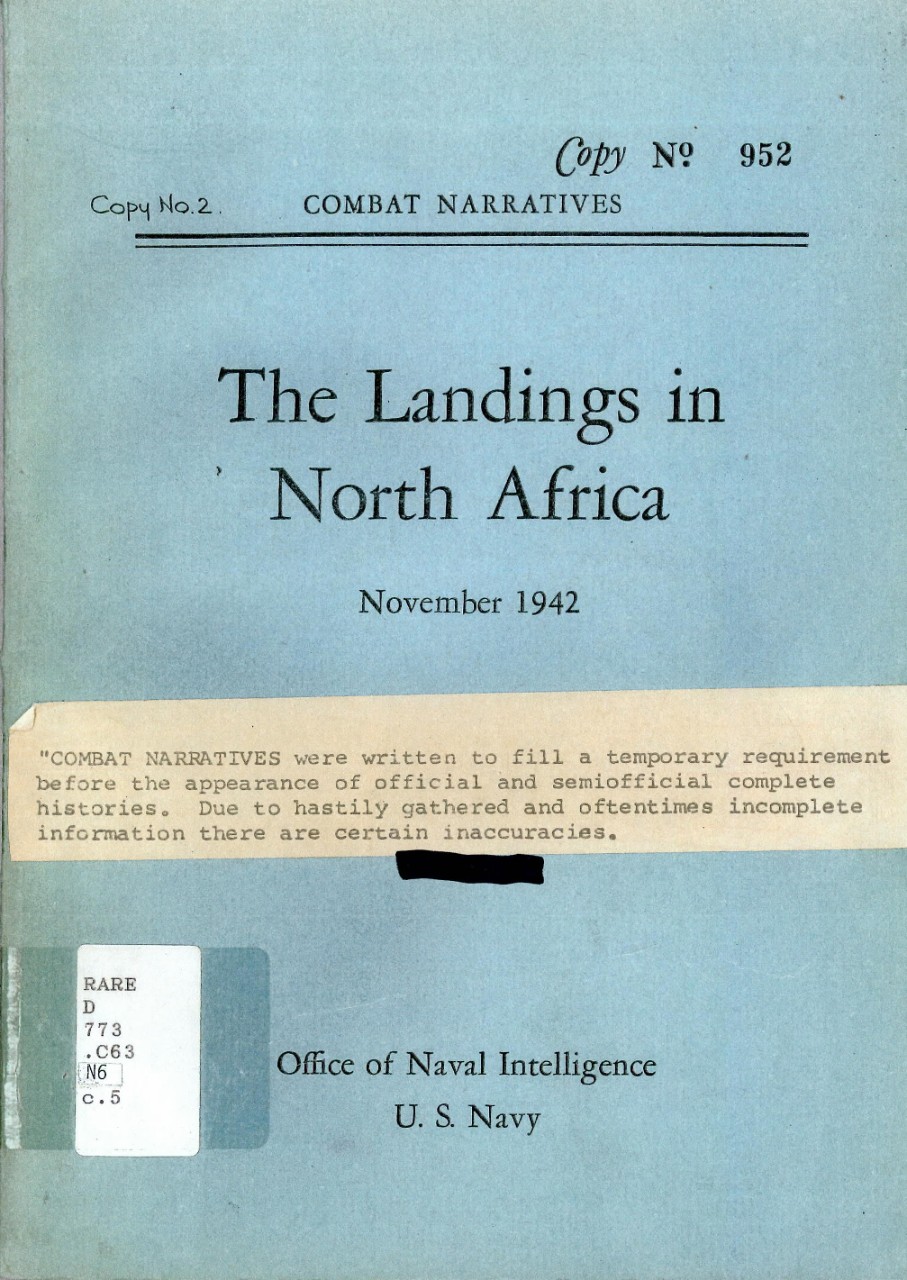
Download PDF Version [41.3MB]
Foreword
8 January 1943
Combat Narratives have been prepared by the Publications Branch of the Office of Naval Intelligence for the officers of the United States Navy.
The data on which these studies are based are those official documents which are suitable for a confidential publication. This material has been collated and presented in chronological order.
In perusing these narratives, the reader should bear in mind that while they recount in considerable detail the engagements in which our forces participated, certain underlying aspects of these operations must be kept in a secret category until after the end of the war.
It should be remembered also that the observation of men in battle are sometimes at variance. As a result, the reports of commanding officers may differ although they participated in the same action and shared a common purpose. In general, Combat Narratives represent a reasoned interpretation of these discrepancies. In those instances where views cannot be reconciled, extract from the conflicting evidence are reprinted. Thus, an effort has been made to provide accurate and, within the above-mentioned limitations, complete narratives with charts covering raids, combats, joint operations, and battles in which our Fleet have engaged in the current war. It is hoped that these narratives will afford a clear view of what has occurred, and form a basis for a broader understanding which will result in ever more successful operations.
Admiral, U.S.N.
Commander in Chief, U.S. Fleet and Chief of Naval Operations.
III
Charts and Illustrations
Charts: North African theater of operations |
Facing Page |
| Illustration: The Walney and Hartland entering Oran | 1 |
Charts: Route of Task Force, 23 October – 8 November 1942 Illustration: Casablanca Harbor |
18 |
Chart: Approach to bridgeheads Illustrations: El Hank lighthouse Naval battery at Mehdia |
19 |
Charts: Bombardment of Casablanca Illustrations: Damage to the Jean Bart, bow Damage to the Jean Bart, stern |
24 |
Chart: Naval engagements off Casablanca Illustrations: Wreck of the Frondeur The Primaugent, Albatros, and Milan beached outside Casablanca |
25 |
| Charts: Mehdia – the landing plan | 35 |
Charts: Sketch of Mehdia and Port Lyautey Illustration: Landing at Fedala |
46 |
Charts: The attack on Safi Illustrations: Batterie Railleuse, wreck of fire control station Batterie Railleuse, direct hit on storehouse |
47 |
Illustrations: USS Bernadou Wreck of the Méduse USS Massachusetts USS Augusta The Primauguet The Brestois The Jean Bart brethed at the Môle du Commerce |
49 |
Charts: Oran and environs Illustration: Oran viewed from Santa Cruz |
64 |
Charts: Port of Arzeu Illustration: Airplane view of Arzeu |
65 |
Charts: Track of Walney and Hartland Illustrations: LCP(L) with armament LCS with rocket racks |
70 |
Charts: Algiers and environs Position of transports, Algiers Illustrations: Algiers Harbor Stranded landing craft (Fedala) Broached landing craft (Fedala) |
71 |
Contents
| Page | |
| The landings in North Africa | 1 |
| The Moroccan expedition | 6 |
| Characteristics of the coast | 7 |
| Fixed defenses | 8 |
| Mobile defenses | 10 |
| The French naval forces | 11 |
| Organization of the United States Amphibious Force | 11 |
| Departure | 13 |
| The Atlantic crossing | 15 |
| The Battle of Casablanca | 19 |
| The attack on Mehdia and the Port Lyautey airfield | 34 |
| The attack on Safi | 46 |
| Attach on Fedala | 55 |
| The Algerian expedition | 61 |
| The attack on Oran and Arzeu | 62 |
| The attack on Algiers | 70 |
| Conclusion | 78 |
| Appendix I. Task Force HOW | 79 |
| Appendix II. Designations of aircraft mentioned in Narrative | 84 |
V
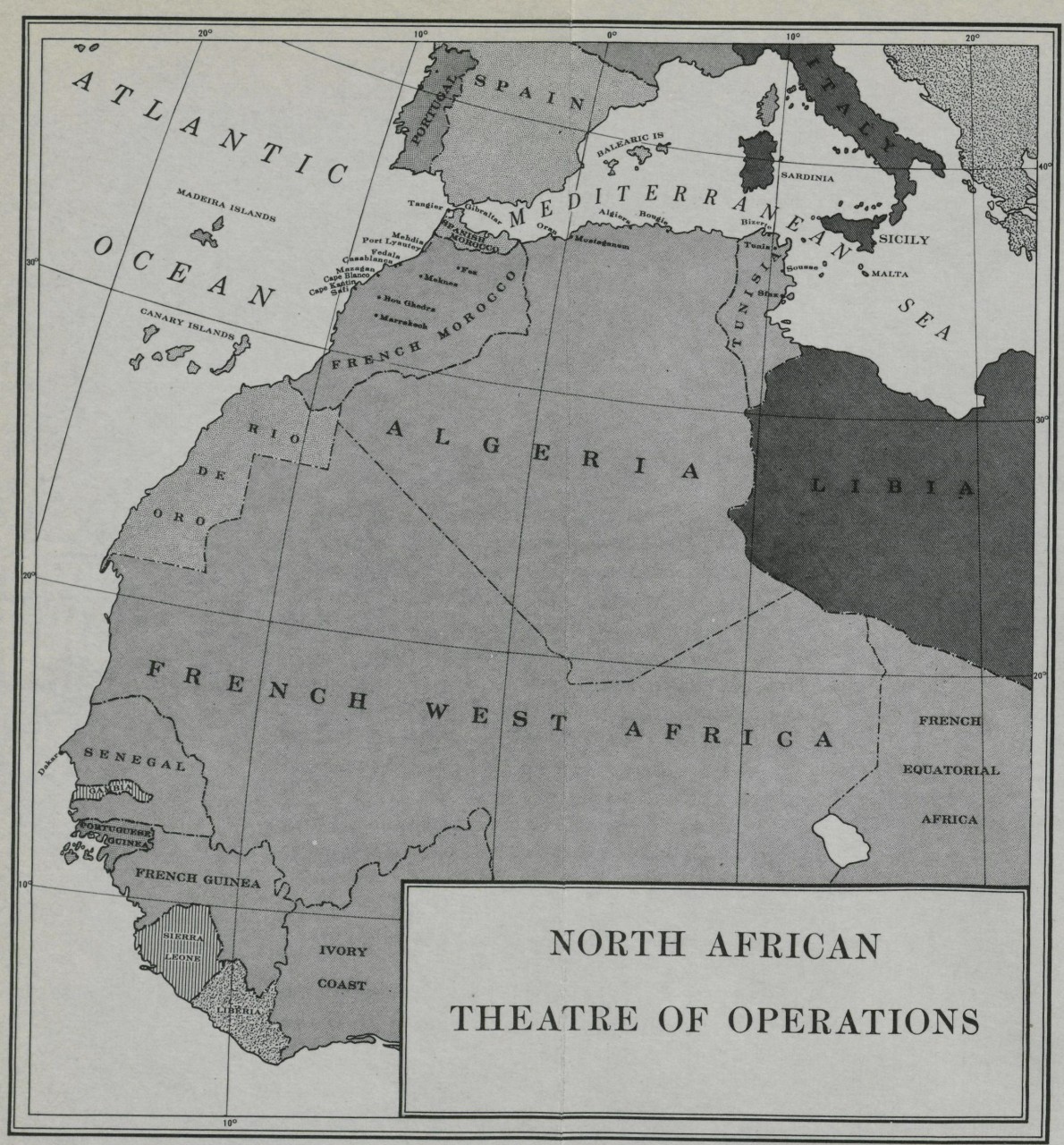
0-44-566293 Faces p. I
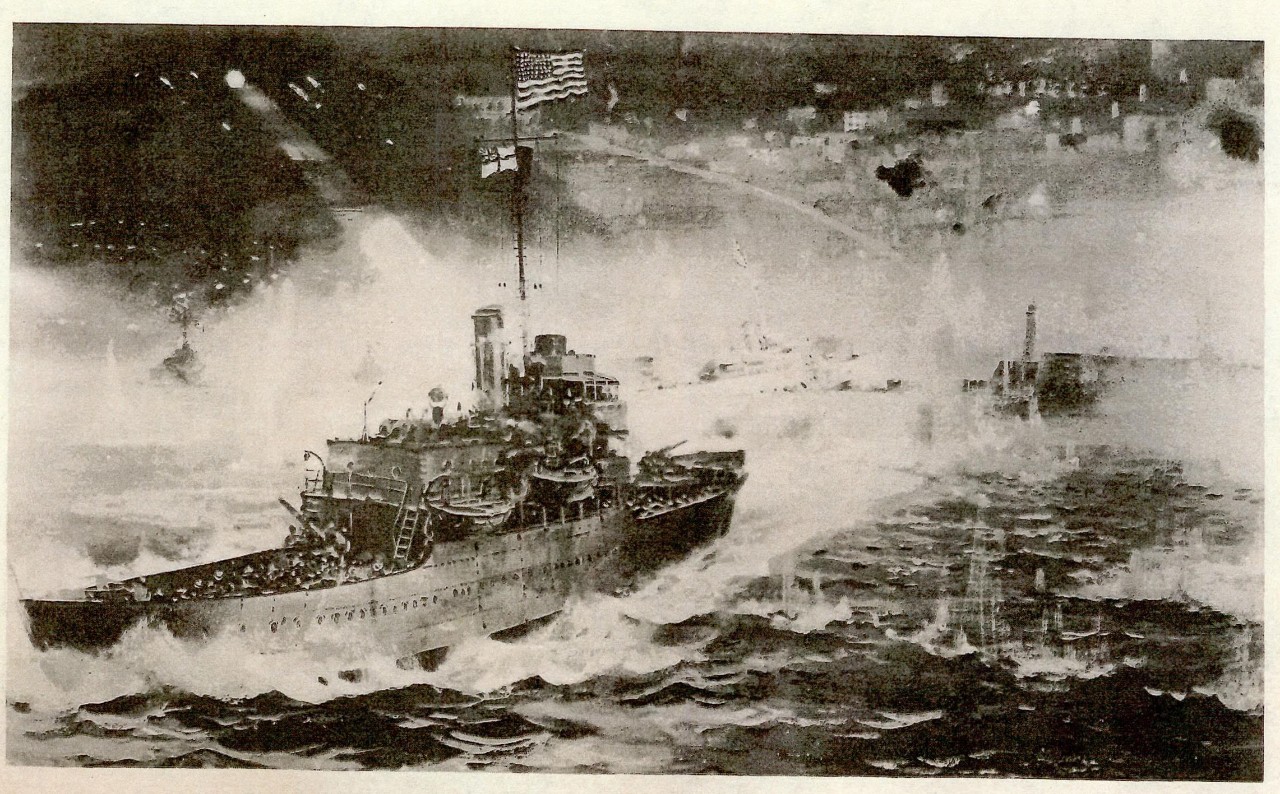
The Walney and Hartland entering Oran (reproduction of painting by eyewitness)
The Landings in North Africa
November 1942
In order to forestall an invasion of Africa by Germany and Italy, which, if successful, would constitute a direct threat to America across the comparatively narrow sea from western Africa, a powerful American force equipped with adequate weapons of modern warfare and under American command is today landing on the Mediterranean and Atlantic coasts of the French colonies in Africa. “The landing of this American army is being assisted by the British Navy and Air Forces, and it will in the immediate future be reinforced by a considerable number of divisions of the British Army.
“This combined Allied force, under American command, in conjunction with the British campaign in Egypt, is designated to prevent an occupation by the Axis armies of any part of northern or western Africa and to deny to the aggressor nations a starting point from which to launch an attack against the Atlantic coast of the Americas.
“In addition, it provides an effective second front assistance to our heroic allies in Russia.”
With these few words President Roosevelt announced the landing of American troops on African soil on Sunday, 8 November 1942.
This announcement to the American people was accompanied by one in French, broadcast in the early hours of 8 November, of which the English translation is as follows:
“My friends, who suffer day and night under the crushing yoke of the Nazis, I speak to you as one who was with your army and navy in France in 1918. “I have held all my life the deepest friendship for the French people- for the entire French people. I retain and cherish the friendship of hundreds of French people in France and outside of France. I know your farms, your villages and your cities. I know your soldiers, professors and workmen. I know what a precious heritage of the French people are your homes, your culture and the principles of democracy in France.
“I salute again and reiterate my faith in liberty, equality and fraternity. No two nations exist which are more united by historic and mutually friendly ties than the people of France and the United States.
“Americans, with the assistance of the United Nations, are striving for their own safe future as well as the restoration of the ideals, the liberties, and the democracy of all those who have lived under the tricolor.
I
“We come among you to repulse the cruel invaders who would remove forever your rights of self-government, your rights to religious freedom, and your rights to live your own lives in peace and security.
“We come among you solely to defeat and rout your enemies. Have faith in our words. We do not want to cause you any harm.
“We assure you that, once the menace of Germany and Italy is removed from you, we shall quit your territory at once.
“I am appealing to you and your realism, to your self-interest and national ideals.
“Do not obstruct, I beg of you this great purpose.
“Help us where you are able, my friends, and we shall see again the glorious day when liberty and peace shall reign again on earth.
“Vive La France éternelle!”
Operations in North Africa long antedated our entry into World War II. They had been limited, however, to Egypt and Libya. Their extension to preclude any Axis action in Morocco had been under discussion by the British high command for some time prior to 7 December 1941. The plan originally contemplated a landing of about 55,000 men in the vicinity of Casablanca. Upon our entry into the war the plan underwent several expansions. It was first enlarged to provide for landing not only near Casablanca but at Mehdia-Port Lyautey and Safi as well. It was thereafter further expanded to include the occupation of the entire North African coast as far as Tripolitania. This occupation would facilitate the safeguarding of Mediterranean convoys, thus enormously shortening the route to the Middle East and saving considerable tonnage previously employed in the route to the Middle East and saving considerable tonnage previously employed in the long passage around the Cape of Good Hope.
The various stages through which the project passed need not be examined. Agreement in principle was readily reached. The United States was to have charge of both the military and naval operations on the Atlantic coast of Morocco. Casablanca, therefore, became an essentially American objective[1]. Oran and Algiers, two cities the occupation of which was contemplated, were to be captured by a joint British and American force, of which the British were to supply all the naval units except a few transports. The landing forces were to be partly American, partly British. Logistics presented a formidable problem, but by July 1942, a plan was formulated providing in detail for an offensive in North Africa under American command, prior to December 1942.
__________
1 Consequently it will be treated more fully than the Mediterranean operations.
2
The strategical purpose of the operations were stated by the Combined Chiefs of Staff to be as follows:
(1) Establishment of firm and mutually supported lodgments in the Oran-Algiers-Tunis area on the north coast, in order that appropriate bases for continued and intensified air, ground and sea operations might be readily available.
(2) Vigorous and rapid exploitation from lodgments obtained in order to acquire complete control of the entire area, including French Morocco, Algeria and Tunisia, to facilitate effective air and ground operations against the enemy, and to create favorable conditions for extension of offensive operations to the east through Libya against the rear of Axis forces in the Western Desert.
(3) Complete annihilation of Axis forces opposing the British forces in the Western Desert and intensification of air and sea operations against the Axis on the European continent.
The “concept of United States participation” issued by the Joint United States Chiefs of Staff called the following military and naval forces:
(1) A Joint Expeditionary Force to seize and occupy the Atlantic coast of French Morocco.
(2) United States forces required in conjunction with British forces to seize and occupy the Mediterranean coast of French North Africa.
(3) Additional Army forces as required to complete the occupation of Northwest Africa.
(4) Naval local defense forces and sea frontier forces for the Atlantic coast of French Morocco and naval personnel for naval base maintenance and harbor control at Oran.
(5) The United States to be responsible for logistic support and requirements of all United States Forces.
The directive of the Joint United States Chief of Staff further provided that the United States should furnish the Commander in Chief, Allied Forces. This command was given to Lt. Gen. Dwight D. Eisenhower, U.S. Army, then our Commanding General, European Theater of Operations. General Eisenhower had already established his headquarters in London. He was supplied with a combined United States-British staff. Later Maj. Gen. Mark W. Clark, U.S. Army, was appointed Deputy
3
Commander in Chief. Vice Admiral Bertram H. Ramsay, R.N., was selected initially to be General Eisenhower’s principle naval subordinate but was replaced in mid-October by Admiral Sir Andrew Browne Cunningham R.N., who assumed the title “Naval Commander, Expeditionary Force.” The United States Navy was represented at Allied Force Headquarters by Rear Admiral Bernhard H. Bieri, Deputy Chief of Staff, United States Atlantic Fleet.
The extension of the original British plan to include action on the entire Barbary Coast had wider implications than were involved in the operation’s diversionary effect pm the Russian front. Allied strategy called for the formation and the gradual tightening of a ring around the Axis powers. The northern coast of the Mediterranean was an important segment of that ring and the occupation of French North Africa an essential prelude to the opening of a second front on the European continent. At the same time, countermeasures by the Axis would be forestalled.
That Germany might attempt to send forces across the Straits of Gibraltar was a possibility that could not be ignored. The threat to the South Atlantic area which would result from an Axis penetration into French Equatorial Africa made it imperative that access to that region be denied to our enemies at once. In this respect the attitude of Spain had to be taken into account.
Although not a belligerent, Spain was watching Allied strategy in North Africa with lively interest. Rumors that General Franco might attempt an occupation of French Morocco in the event that Allied forces occupied Dakar had been current for some time. That Spain would not be adverse to enlarging her Moroccan colony was well known, nut her ability to do so without Axis cooperation was questionable. The possibility of an Hispano-Axis bargain was, however, serious enough to render it imperative that sufficient forces be stationed on the French-Spanish Moroccan border to forestall and Spanish move.
As can be seen, the contemplated operations had to be on a very large scale. We were undertaking possibly the most ambitious combined operation in the annals of warfare. Careful preparation and, above all, absolute secrecy were essential if the operation were to be successful at a cost that would not be appalling.
4
The question of how much resistance the French North African colonies would offer was difficult to gauge.
The situation prevailing in the French Navy was a peculiar one. French naval officers have for generations been chosen largely from certain families, most of whom are Bretons and avowedly royalist. The traditions of “Grand Corps” are still very much alive. As a result French naval officers are inclined to think more in terms of the service than of the nation. The enlisted men, who like their superiors are mostly Bretons, have long been accustomed to follow the lead of their officers. Their ambition is to achieve a rating and retire with a pension. In order to do so, an unblemished record for discipline and subordination is necessary. Admiral Darlan was especially popular among the enlisted men because his efforts on their behalf at the time of armistice.
That the rank and file of the French Navy would resent any interference in French affairs, no matter how well intentioned, was a foregone conclusion among all competent observers. The traditional antipathy to the British, the “hereditary enemy” had been revived by the attack on Dakar and Mers-el-Kébir in 1940. British designs on Bizerte were suspected. The fact that Great Britain was now joined by the United States made little difference. It was generally accepted that Anglo-Saxon sea power was opposed to the French colonial system. The determined resistance the French naval units offered at Casablanca- and on the Algerian coast- was in marked contrast to the pro forma resistance offered by the land forces.
The situation in the French Army was slightly different in that it reflected the vies of the average Frenchman. Marshall Pétain was personally popular and his relations with Reich were condoned on the ground that no other course was open to him. The senior officers were as a rule loyal to the Marshal, anxious to make a honorable show of resistance and inclined to be antiforeign. The junior officers and enlisted men, however, were inclined to look favorable on the Unites States. For this reason it was deemed advisable throughout the entire French African campaign to stress the American complexion of the expedition.
The government officials as a class were resentful of all interference and concerned about their salaries and pensions. The civil population was neutral and mainly interested in bettering its economic condition. The natives, including the indigenous troops, were apathetic.
Generally speaking it may be said that in North Africa, France was a
5
“house divided,” in which respect it reflected the political situation in European France.
The occupation of French North Africa was accomplished by means of simultaneous assaults on Casablanca, Oran and Algiers. General Eisenhower exercised command over all elements of the three attacking forces, with the exception of the permanent British naval units in the Mediterranean. These remained under the control of the British Admiralty.
Geographically the three operations fall into two regions based on the seas to which they are related. From a military point of view those in the Mediterranean were primarily British and designed to supplement somewhat the British land operations proceeding from Egypt. On the other hand, the attack from the Atlantic to a certain extent owed its inception to the strategic needs of hemispheric defense. For purposed of clarity the Moroccan and Algerian expeditions will therefore be considered separately.
THE MOROCCAN EXPEDITION
In the Moroccan expedition the naval component was known as the Western Naval Task Force and was under the command of Rear Admiral Henry K. Hewitt, U.S.N. The Army component was known as the Western Task Force and was under the command of Maj, Gen. George S. Patton, U.S. Army. The mission assigned to the Naval Task Force was:
“To establish the Western [Army] Task Force on beachheads near Mehsia, Fedala and Safi, and support the subsequent coastal military operations in order to capture Casablanca as a base for further military and naval operations.”
The principle objective of the expedition was therefore the harbor of Casablanca, modern seaport on the Atlantic protected by an adequate breakwater and processing docks and other facilities. To accomplish the task it was considered advisable to occupy simultaneously three other harbors. The most important of these was Fedala, situated 14 miles northwest of Casablanca. Secondary landing places which were deemed necessary for the success of the operations were Mehdia, 65 miles north of Casablanca, and Safi, 125 miles south of Casablanca. The object of landing at Fedala and Safi was to facilitate the capture of Casablanca
6
from the land side. Mehdia was occupied because of the adjoining airfield at Port Lyautey.
Although capable of being expressed in a few lines, the mission assigned to the Western Naval Task Force presented serious difficulties.
Characteristics of the coast.
The coast of Morocco is generally rocky with occasional long shelving beaches which require transport to lie a considerable distance from the shore. Rocky outcrops add to the difficulties of making safe landings. The number if possible landing places is relatively limited. Fully navigable rivers are nonexistent. Such harbors as exist are artificial. Intelligence reports, however, indicated that several practicable beaches were located in the vicinity of the ports to be occupied.
The beaches are subject to heavy ground swells, high surf, and a considerable tidal rise and fall which render debarkation operations extremely difficult[2]. A swell of 16 feet, which in breaking doubles in high, is not uncommon. Very high surf and swell are frequently observed in spite of fair local weather. Low pressure over the Azores moving towards southern Spain will cause a heavy surf off Morocco in about one day. A depression passing south of Iceland, on the other hand, will not be felt until 2 or 3 days later. The worst swell and surf, however, result from a depression in the area between Bermuda and Newfoundland. After a lag of about 36 hours, surf, accompanied by gale winds, may be expected along the Moroccan coast. The chances of these disturbances naturally increase with the approach of winter weather. In view of the late date chosen for the North American expedition the meteorological factor was one of the utmost importance. In fact, immediately after the debarkations a surf developed which, had it occurred a day or two sooner, would have immeasurably increased the hazards of the landing.
Predictions require the continuous study of meteorological conditions over the entire Atlantic. The efficiency of the metrological service of the Navy contributed in no small degree to the success of the undertaking. In order that no source of information be neglected, five beacon submarines were dispatched to the Moroccan coast two days ahead of the main
__________
2 One of the probable reasons why our landings on the Moroccan beaches met with such light opposition was the fact that the French did not believe a landing through the surf possible and were expecting attacks on more sheltered spots, such as harors or, in the case of Media, a beach along the Sebou River.
7
body. Among their duties was the prompt reporting of meteorological conditions.
Fixed defenses
Although the French fortification plan was far from completed. The coastal area was protected by numerous fixed defenses. These consisted of (a) naval coast defense batteries, (b) emplaced army field artillery, (c) army or naval antiaircraft batteries, and (d) machine guns, usually mounted in pill boxes. The exact location and nature of all these batteries were not known in advance. The intelligence reports, however, proved remarkably accurate. Such slight inaccuracies as were discovered will be mentioned in dealing with operations. The defenses reported were as follows:
Mehdia.[3] – This town, situated at the mouth pf the Sebou River on the southern bank, had been fortified with two batteries. One, known as the Batterie Ponsot, consisted of two 138.6-mm. guns and was located halfway between the Kasba (walled native quarter) and the lighthouse. It commanded all sea approaches to the Sebou River. Estimated range: 18,000 meters. Another battery, known as the Batterie does Pases, consisted of two 75-mm. guns and was located on the river’s edge below the Kasba.
Fedala[4].- This village, mainly a pleasure resort, 12 miles northeast if Casablanca, had been fortified with four batteries. (a) The Batterie Port Blondin was located at Chergui about 3 miles northeast of the harbor of Fedala. It consisted of four138.6-mm. Estimated range: 18,000 meters. (b) The Batterie du Port, located just southwest of where Cape Fedala starts to jut out, consisted of two 100-mm. guns with an estimated range of 14,000 meters. It dominated the small harbor of Fedala. (c) The Batterie des Passes, consisted of two 75-mm. guns, was located on the tip of Cape Fedala. (d) An army antiaircraft battery of four 75-mm. guns was located just south of the village alongside the railroad tracks.
Casablanca area[5].- At the Table d’Aukasha, a headland about 5 miles northeast of Casablanca, a battery of four guns had been mouthed. These were reported to be either 164.7-mm or 138.6-mm. guns. Three miles southwest of Casablanca the El Hank promontory juts out into the Atlantic. Here two batteries had been mounted. Battery No. I consisted of four
__________
3 See charts opposite pp. 19 and 35.
4 See charts opposite pp. 24 and 25.
5 See charts opposite pp.24 and 25.
8
194-mm. guns aligned northeast and southwest to the west of Point El Hank lighthouse. Battery No. 2 consisted of four 138.6-mm. guns spread in a line between Battery No. I and the tip of the point. These two batteries were formidable. The former was said to have a range of at least 23,500 meters, the latter a range of about 18,000 meters. The guns were mounted on a central pivots and could be trained both east and west. The fire control and magazines were modern.
Casablanca Harbor[6].- The harbor of Casablanca is formed by two jetties located at right angles to each other, the Jetée Delure and the Jetée Transversale. The former extends along the ocean in a northeasternly directions for a distance of 2,600 meters. The entrance to the inner harbor is close to the 1,500 meter point on the Jetée Declure, opposite the end of the Jetée Transversale. The area thus enclosed is approximately bisected by a spacious wharf, the Môle du Commerce. The outer harbor is formed by the coast, the Jetée Transversale and the portion of the Jetée Delure projecting beyond the entrance to the inner harbor. Two rocky outcroppins located near the coast about 1,300 meters from the Jetée Transversale are within the red sector of the Roches Noires lighthouse.
The harbor area had been fortified with air raid protection mainly in view. On the Jetée Delure, at the 1,000 meter point, a battery of four 40-mm. AA guns had been installed. Further along, at the 1,700 and 2,100 meter points, blockhouses had been constructed. They were believed to contain 37-mm. and 13.2-mm. machine guns. On the spur extending toward the Jetée Transversale four 13.2-mm. AA machine guns had been mounted. At the angle formed by the Jetée TRansversale and the shore two batteries had been mounted, each equipped with a searchlight. The westerly battery was believed to contain four 75-mm. AA guns, the easterly battery four 13.2-mm. AA guns. On the end of the Jetée TRansversale a bettery of two 75-mm. guns and one 13.2-mm. AA gun had been mounted. On the roof of the adjoining Phosphate Building another battery of four 13.2-mm. AA guns in towers had been erected.
The uncompleted battleship Jean Bart, moored at the southeastern end of the Môle du Commerce heading northwest, may be considered as part of the fixed defenses of Casablanca. Her normal armament consisted of eight 15-inch guns in two turrets (range 35,000 yards) of which only four had been installed, fifteen 6-inch guns, of which only five had been
__________
6 See charts opposite pp. 24 and 25.
9
installed, twelve 37-mm. guns and twenty-four 13.2-mm. AA machine guns.
Safi.[7]- The harbor of Safi had been fortified by two Navy coast defense batteries, the Batterie Railleuse and the Batterie des Passes.
The Batterie Raileuse was located on the Pointe de la Tour, a promontory jutting our into the Atlantic 2 ¾ miles northwest of Safi. Here the French had placed four 130-mm. guns on circular concrete emplacements. Estimated range: 19,000 yards; estimated rate of fire: 8 rounds per gun per minute. The fire of this battery was controlled by a fire control station equipped with a modern range finder. Four .50-caliber AA machine guns had also been mounted.
The Batterie des Passes consisted of two 75-mm. guns and was situated about 2,000 yards north of the city.
About 2 miles south of Safi an army battery had been emplaced. It consisted of three 155-mm. guns. Its exact location was not determined until operations began.
Other fixed defenses need not be considered as they played no appreciable part in the operations.
Mobile Defenses
The fixed defenses of the Moroccan coast were supplemented by mobile defenses drawn in Morocco was 13 infantry regiments, 8 cavalry regiments,[8] and 4 artillery regiments plus 3 batteries. The exact composition of the French land forces need not detain us.[9] Suffice to say these forces were variegated, colorful, and picturesque and could undoubtedly have put up a stiff resistance had they so desired. The only ones to do so were the professional soldiers of the Foreign Legion.
The artillery consisted of two regiments of African artillery, two regiments of Colonial artillery and three batteries of the Foreign Legion. Most of the field pieces were 75’s, but some were 65’s. In addition there was one regiment of antiaircraft artillery. These mobile units caused considerable trouble by compelling our transports to keep well out of range and by contesting the advance of the landing parties. They frequently
__________
8 The famous Chasseurs d’Afrique have been motorized.
9 A French infantry regiment normally consists of 3,120 men, a cavalry regiment of 1,140 men, an artillery regiment of 1,683 men. The strength of batteries varies. The 75’s usually have 98 men to a battery, the 105’s 108 men. The motorized batteries of 75-mm. guns muster about 170 men.
10
bolstered the fixed defenses by taking positions in emplacements usually prepared in advance. Owing to their mobility- some were motorized, others were horse-drawn- their location could not be determined beforehand.
The French air forces in Morocco were too inconsiderable to be able to affect operations. The total number of planes, both Army and Navy, in the area was estimated at 168. During the landing operations at Fedala and Mehdia some Italian planes were identified among those strafing the beaches. In addition to the air base at Port Lyautey, numerous air fields were scattered throughout Morocco, weakly defended by antiaircraft units.
The French naval forces
Intelligence reports credited the French with the following vessels based on Casablanca.
Jean Bart, battleship 1
Gloire, Primauguet, light cruises 2
Albatros, Le Malin, Milan,[10] flotilla leaders 3
Alcyon, Brestois, Fougueux, Frondeur, Simoun, Tempête, destroyers 6
Actéon, Archiméde, Aurote, Céres, Conquérant, Iris, Méduse,
Orphée, Pallas, Psyché, Tonnant, Vénus, submarines 12
Boudeuse, sloop 1
This list, except for some unimportant errors in names, proved substantially correct.[11]
These vessels, with the exception of the Jean Bart, were in full commission and fully manned. Well-trained, well-equipped, thoroughly disciplined and the leadership is energetic and able,” is how one report summed up the situation.
ORGANIZATION OF THE UNITED STATES
AMPHIBIOUS FORCE
The organization of the Amphibious Force command by Rear Admiral Hewitt, designated Task Force HOW[12], varied at different
__________
10 Considerable confusion has crept into the reports due to the similarity of these last two names.
11 By the time our forces reached Casablanca, the Gloire and one submarine had been detached, one destroyer and two sloops added.
12 Numbers identifying task forces have been omitted from all Combat Narratives in the interest of security. Navy flag names for the first letter of surnames of commanding officers have been substituted.
11
times as the operations progressed. Roughly speaking, the Task Force went through three states: (a) departure, (b) passage, (c) attack, the details of which will be found in Appendix I. The basic idea was the formation of a Covering Group to contain the French Fleet at Casablanca and, if necessary, the French units at Dakar, while three Attack Groups effected landings at Mehdia, Fedala, and Safi.
The expeditionary force which participated in these operations was built around two Army divisions, the Sixth and the Ninth. Both were reinforced by special detachments. This force was command devolved as soon as satisfactory beachheads were established.
Care had been taken to make this force as letter-perfect in amphibious operations as circumstances permitted. The doctrine adopted by the United States Army was the result of tests conducted for a period of 3 years prior to the North African campaign. The unit chosen for these maneuvers was the First Division, United States Army.[13] During the winter of 1939-40 this division began its experimental work at Culebra Island, Puerto Rico, and continued it in northern waters. Gradually evolving principles which form the “basic training” of the Army.
Briefly stated, the basic training, besides thorough physical conditioning, involved instruction in such details as the protection of critical items such as gas masks, rifles, and ammunition wile wading through surf, and the manner in which safe landings from boats to shore can be made. All Army contingents forming part of the Task Force had received this training prior to reporting to the transports. Whenever possible, as in the case of the Third Division which had been trained on the West Coast, this training was undergone on actual beaches. When this was not possible, a simulated landing was made. Automobiles riding over artificially undulating ground took the place of small boats. Beaches marked off were then occupied and unloading operations performed with as much realism as practicable.
Once at Hampton Roads the units were placed on transports and sent up Chesapeake Bay to Solomon Islands, where they remained on an average of 3 weeks performing actual landings. The training usually included three “dress rehearsals.”
__________
13 This division constituted the U.S. Army contingent in the Mediterranean landing which will be considered presently.
12
The system adopted was undoubtedly the best that could be devised. It was deficient, however, in one important respect. No surf could be devised. It was deficient, however, in one important respect. No surf comparable to that encountered on the Moroccan coast was available. The heavy loss of landing craft which was the cause of so much trouble and anxiety had not been taken into consideration. No doctrine of boat salvage was perfected.[14] The North African landings had been scheduled perilously near the season of winter storms. In fact, one broke right after our landings were completed. Our unpreparedness to meet the meteorological risk was such that our avoidance of a costly failure has been described by many officers who participated as “providential.”
DEPARTURE
The shipping problem was a difficult one. The Army contingent to be transported amounted to 1,920 officers and 35,385 men. The equipment and material were in proportion. Space had to be provided for 250 tanks. The landing craft were bulky and numerous. On 1 June 1942, there were but 8 ships assigned to and operating with the Amphibious Force, United States Atlantic Fleet. This number was gradually increased by assignment of newly constructed vessels, by the transfer of 5 ships from the West Coast and by the conversation of 11 ships during August and September, with the result that by 1 October 26 transports and 7 cargo ships had been assembled at Hampton Roads.
By 23 October loading operations were completed and the Task Force organization was put into effect. In order to avoid congestion, the Covering Group was dispatched to Casco Bay and the Air Group to Bermuda just before the main body sailed. The departure from the United States was set for 2 successive days. Detachment ONE, consisting of units assigned to the Mehdia and Safi landings, began threading its way through the swept channel at Hampton Roads about 1000 on 23 October.
Detachment TWO, consisting of units intended for Fedala landings,
__________
14 “Boats that had been broached were abandoned at the critical time when a little judgement might have saved them, and having been abandoned to the mercy of the surf, soon were hopelessly battered to pieces. No doctrine had been laid down nor had men been instructed in the salvage of equipment that was undamaged and still serviceable.
“Two or three men with a few tools could have effectively salvaged enormous quantities of clocks, boat compasses, anchors, fire extinguishers, tools, propellers, etc. As it was, a few machine guns were saved but the lack of transportation facilitates and utter lack of guards to prevent pillaging at night by natives prevented any worthwhile efforts in this line.” (From report of a ranking officer.)
13
sortied 24 hours later. The Covering Force put sea from Casco Bay on 24 October. The air Group, however, did not leave Bermuda until the 25th.
Just prior to sailing, the transport Harry Lee, fully combat-loaded, developed engine trouble. Her commanding officer, Capt. James W. Whitfield, performed the difficult task of transferring men and materials to the Calvert in the remarkably short time of 48 hours. With an escort consisting of the destroyers Boyle (Lt. Comdr. Eugene S. Karpe) and the Eberle (Lt. Comdr. Karl F. Poehlmann), the Calvert sailed from Hampton Roads on 25 October and joined the main body in mid-Atlantic on 30 October.[15]
A picturesque touch was furnished by the S.S. Contessa. Considerable difficulty had been encountered finding a vessel of sufficiently light draft to negotiate the shallow, 12-mile passage up the Sebou River to Port Lyautey. Unless the planes our forces intended to land at that airport were to be immobilized through lack of gasoline and bombs, some means must be found to deliver these and other aviation supplies promptly. A survey of the available transports failed to disclose one that did not draw more than the channel depth, 17 feet. The Contessa, an old 5,5000-ton British-built fruit vessel, then en route to New York, was accordingly contacted by wireless and directed to Newport News. Although operated by the United States Maritime Commission, she flew the Honduran flag. Her captain, William H. John, was British, the first-mate Italian-American, the second mate Norwegian, the third mate American. The first engineer was British, the second German-American, the third Honduran. In her crew were Filipinos, Swedes, Danes, Estonians, Spaniards, Portuguese, Mexicans, Peruvians, Belgians, Brazilians, Finns, Arabs, and Australians.
On reaching Newport News the crew of the Contessa scattered before the vessel could be impressed into service and many men could not be reached. In order to man the ship, the jails of Norfolk were combed. With this motley crew her captain nevertheless volunteered to sail her unescorted over the submarine-infested Atlantic. A Reserve officer, Lieut. A.V. Leslie, was put on board as a “liaison officer” with authority to assume command should the crew become obstreperous. The crew,
__________
15 This detachment was designated Task Group HOW 15.
14
however, proved exemplary. On 26 October the Contessa sailed indedendently from Hampton Roads.[16]
The largest armada in history was now on its way.
THE ATLANTIC CROSSING
The cruising formation of the Task Force[17] was normally as follows: The Protective Screen (consisting of the former Covering Group reinforced by additional destroyers) took station about 14 miles ahead of the convoy, the Air Group about 12 miles astern. The escort ships (Convoy Screen) formed an outer and an inner screen. The vessels of the outer screen maintained station approximately 10 miles ahead of the main body or at the extreme limits of visibility (about 8 miles) on the quarter or beam of the convoy. The vessels of the inner screen patrolled sectors approximately 6,500 yards ahead, 4,000 yards on the beam or 2,000 yards astern of the convoy. The convoy itself steamed in 9 columns preceded by the Augusta, the Force Flagship. The New York and the Texas headed the two outer columns. The escorting vessels not otherwise assigned were stationed around or among the transports with a line of lighter vessels to the rear to deal with trailing submarines.
In routing the Task Force across the Atlantic extreme care was taken to mystify the enemy as to the actual designation. Detachment ONE took an initial southerly course as if heading for the West Indies. When well clear of the coast this course was changed to east and later to north. Detachment TWO took a northeasterly course as if heading for the British Isles. The two groups effected their junction in the afternoon of 26 October. The Air Group proceeded northeast from Bermuda and joined the main body in the afternoon of 28 October, in approximately longitude 51ᵒ W., latitude 40ᵒ N. Here the course was changed sharply to the southeast, as if the ultimate destination were Dakar. This general
__________
16 The cruise of this vessel sounds like a story by Conrad. After a hectic voyage during which she lost her way, the Contessa turned up at Safi a few hours prior to that landing. She was thereupon headed up to Mehdia, escorted by the Cowie. Up the winding channel, over sand bars, past obstructions, the Contessa scraped her way in spite of dented plates and leaking steams. Two miles south of Port Lyautey she ran hard aground and, before she could be floated, the ebb tide swung her around until she was pointing down stream. She had accomplished her mission, however. Lighters were rushed out from the airport, which had just been occupied, and her invaluable cargo was safely disembarked.
17 Unless otherwise specified, the term Task Force is applied to the Western Naval Task Force and the term Task Force Commander to Rear Admiral Hewitt.
15
southeasterly course, with slight variations necessitated by the fueling of the combat ships, was continued until a point was reached approximately due south of the Azores and west of Canary Islands. There the course was again changed to the northeast, in the general direction of the Straits of Gibraltar. Care was taken, however, to avoid possible unfriendly air searches from the Azores and the Canaries. Passing to the north of Madeira, the destroyers fueled again on 6 November, after which the entire Task Force proceeded to a point northeast of Casablanca, preparatory to separating according to objectives.
Once off soundings, the true destination of the expedition was revealed to the personnel, thereby putting an end to considerable speculation and arousing great enthusiasm. The “useless chatter” over the TBS that resulted brought a pointed admonition from Admiral Hewitt to whom it sounded “more like a Chinese laundry at New Year’s than a fleet going to war.” Other precautionary measures were taken in the interest of security. Nothing was to be thrown overboard during daylight. Bilges were not to be pumped until after twilight. All cans were to be well punctured before disposal.
Stringent regulations were adopted to deal with any craft sighting the Task Force. “Neutral merchant vessels and aircraft which are met at sea shall by their presence be considered as having established prima facie evidence of aiding the enemy,” read the instructions to the screen. All such vessels were to be boarded and set on the quickest course that would take them out of sight. If necessary to insure secrecy, they might be detained in an Allied port. Flagrant violations of the rules against unneutral service might lead to capture and even sinking. Aircraft were to be shot down.
The amount of drilling in small boat technique given the men during the crossing varied with the individual commanders. One ranking Army officer reported that on his transport “very little” training was done en route and on the other “apparently less.” On the other hand, another officer noted that on his transport “all boat crews and soldiers familiarized themselves with the plan, harbor and facilities. Everyone rehearsed in their detailed duties.”
Radio silence was strictly enforced, but at home the broadcasters were busy, so much so that many officers were afraid all their elaborate precautions would be nullified. When finally the magic word “Casablanca: came over the air “the armchair jockeys who pontificate on the radio
16
and in the press to the menace of our lives and the detriment of our efforts” were roundly denounced. “One need not have the perspicacity of the Three Wise Men,” one irate officer reported, “to see that bit by bit injudicious admissions as to the location of likely operations have gone so far as to bring the name of Casablanca into the news. And here we are at sea, still hundreds of miles from our objective and the ocean lousy with U-bots.” No wonder the fleet zigzagged so continuously that its track looked like that “of a reeling drunk in the snow,” to quote one eye-witness. During one of these gyrations the Brooklyn was compelled to reverse engines to avoid colliding with the Hambleton. “I believe in a two-Navy ocean for you and me,” was the good-natured comment the cruiser made to the destroyer.
On 31 October a radio message was picked up. “Going down slowly 35-06 North, 16-59 West. Many wounded and dying. Please send help” – a grim reminder of the serious business in hand.[18] In spite of frequent alarms no authenticated submarine attack was recorded. This is all the more remarkable and indicative of the efficacy of the protective measures adopted, as numerous enemy scouting lines had been formed across the route that was being traversed and the Task Force numbered no less than 99 vessels. One stationary line was reported along latitude 40ᵒ N., from Spain to the Azores. Another extended from the African coast westward to the Cape Verde Islands, thence south to Dakar. A third was said to extend initially from the west of the Azores to west of the Cape Verde Islands and to be retiring northeastward as the convoy approached. It is probable that the convoy was sighted by submarines as early as 25 October; yet no attacks developed.
The passage was an uneventful one. On 1 November, the Augusta radar spotted an unidentified aircraft crossing the convoy track from port to starboard, probably a clipper. On 2 November, the Doran reported that her number three magazine had been flooded, apparently with malicious intent. The saboteur, who was probably mentally deranged, was apprehended. On 3 November, a Ranger plane on antisubmarine patrol crashed. The personnel were rescued but the plane sank. On 4 November, the Miantonomah was forced to drop out because
__________
18 This distress signal undoubtedly was sent by the S.S Alaska (nor. Cgo. 5,681 tons), which was torpedoes about 1900Z, 30 October, at 35-06 N., 16-59 W., and sent distress signals on the 30th and 31st. When torpedoed, she had just picked up 55 survivors from the S.S President Doumer hit at 1865Z. The Alaska ultimately made port.
17
of excessive roll. The Raven was detailed to escort her, the two vessels to rejoin as soon as practicable. This was not until 4 days later. The voyage was drawing to an end, and as a result of the proximity of land, coastwise shipping was beginning to appear. On 5 November, a Portuguese streamer was sighted by the screen in time to be avoided by an emergency turn to port. The next day a Spanish streamer was picked up by the screen but, as she did not sight the convoy, was allowed to proceed. On 6 November fishing craft and coastal steamers were thereafter encountered. All were rounded up.
As the African coast was approached “the progress of the political offensive fluctuated from day to day. One day it seemed that the French were going to resist, then word came that the Army and Air forces would not oppose us, and then that the attitude of the French Navy was in doubt. Everyone hoped that they would save their bullets for the Nazis, but French war psychology is completely inexplicable and we could take no chances.”
On the night of 6-7 November, weather dispatches from Cominch, the War Department and the beacon submarines[19] off the Moroccan coast were received. From these reports the fleet meteorologist was able to state that both wind and swell would decrease and that favorable weather conditions would prevail during the next 48 hours. The Force Commander therefore decided to put the attack plan in operation and signals to that effect were dispatched to all units. D-day Was set for 8 November and H-hour for 0400.[20]
The good fortune that had attended the expedition in its approach maneuvers was well summed up by one officer who reported as follows: “Against no other inhabited civilized coast could an approached have been made to a point within 16 miles of the main base, in darkness, using radar of all types, whistles and light maneuvering signals, fathometers and radio telephone without bringing down instant and strenuous opposition… Without any intention to detract in the slightest from the success that was achieved, I must say seriously and emphatically that I do not believe
__________
19 Task Group HOW II consisted of: Barb(F), Lt. Cmdr. John R. Waterman, off Safi, Blackfish, Lt. Comdr. John F. Davidson, off Dakar, Herring, Lt. Comdr. Raymond W. Johnson, off Casablanca, Shad, Lt. Comdr. Edgar J. Macgregor, III, off Mehdia, Gunnel, Lt. Comdr.. John S. McCain, Jr., off Fedala.
20 All times given hereafter are Zed time.
18
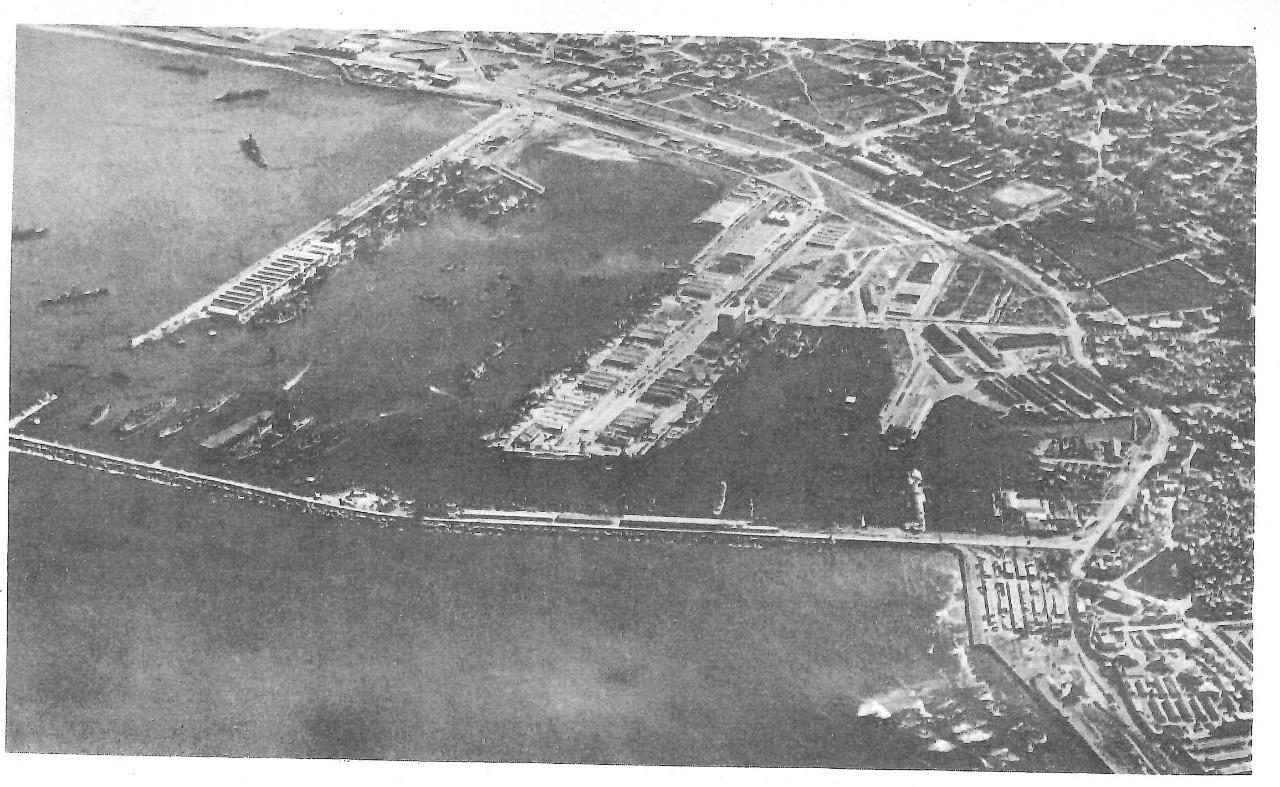
Casablanca Harbor
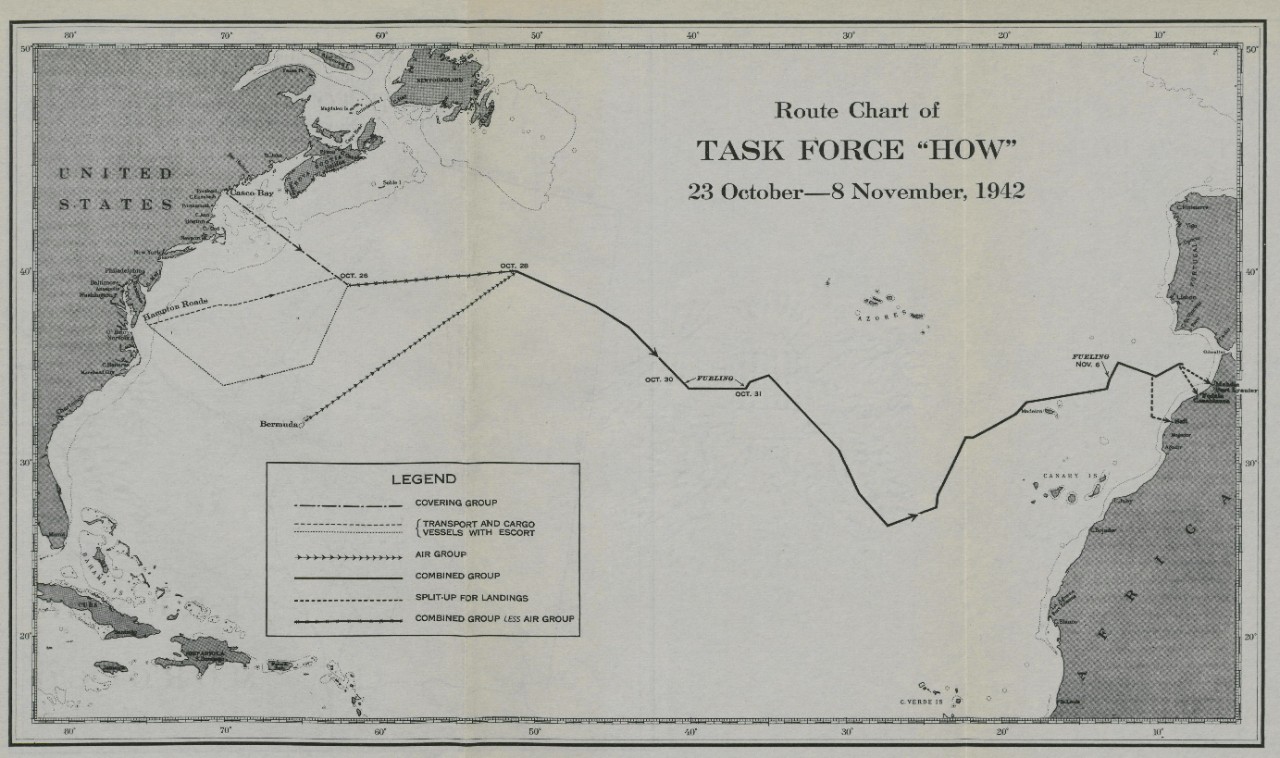
0-44-566293 Faces p. 18
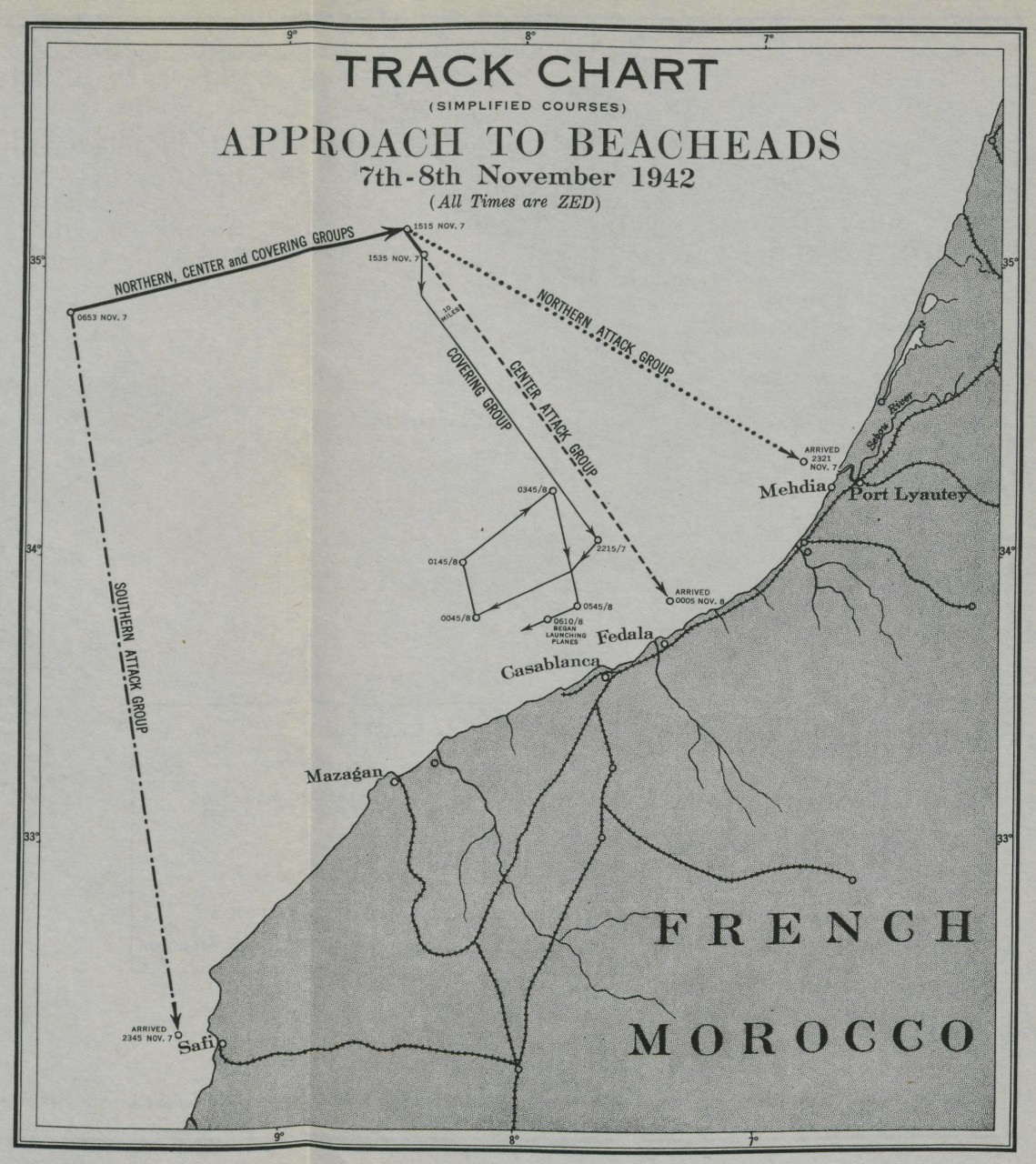
0-44-566293 Faces p. 19
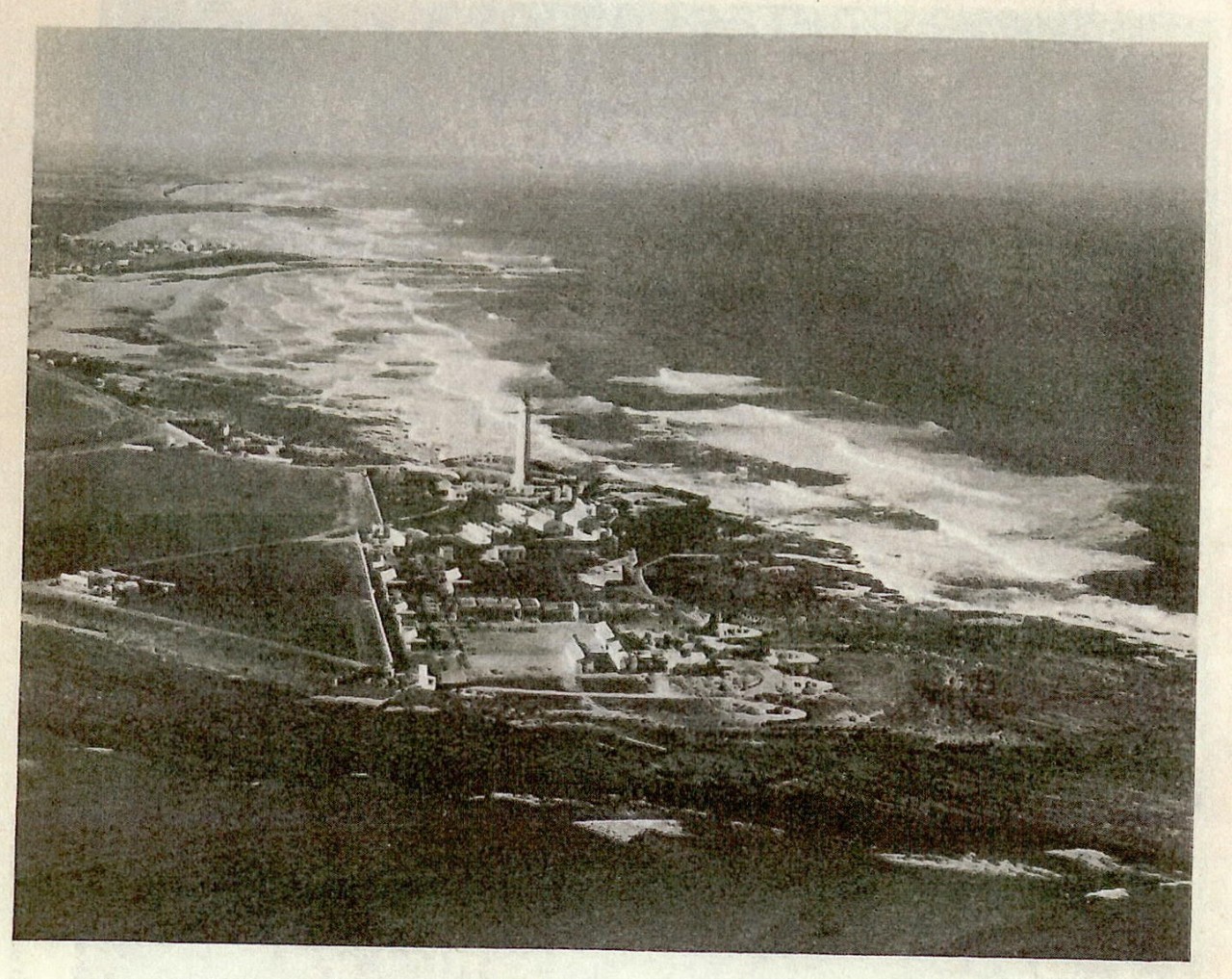
El Hank lighthouse
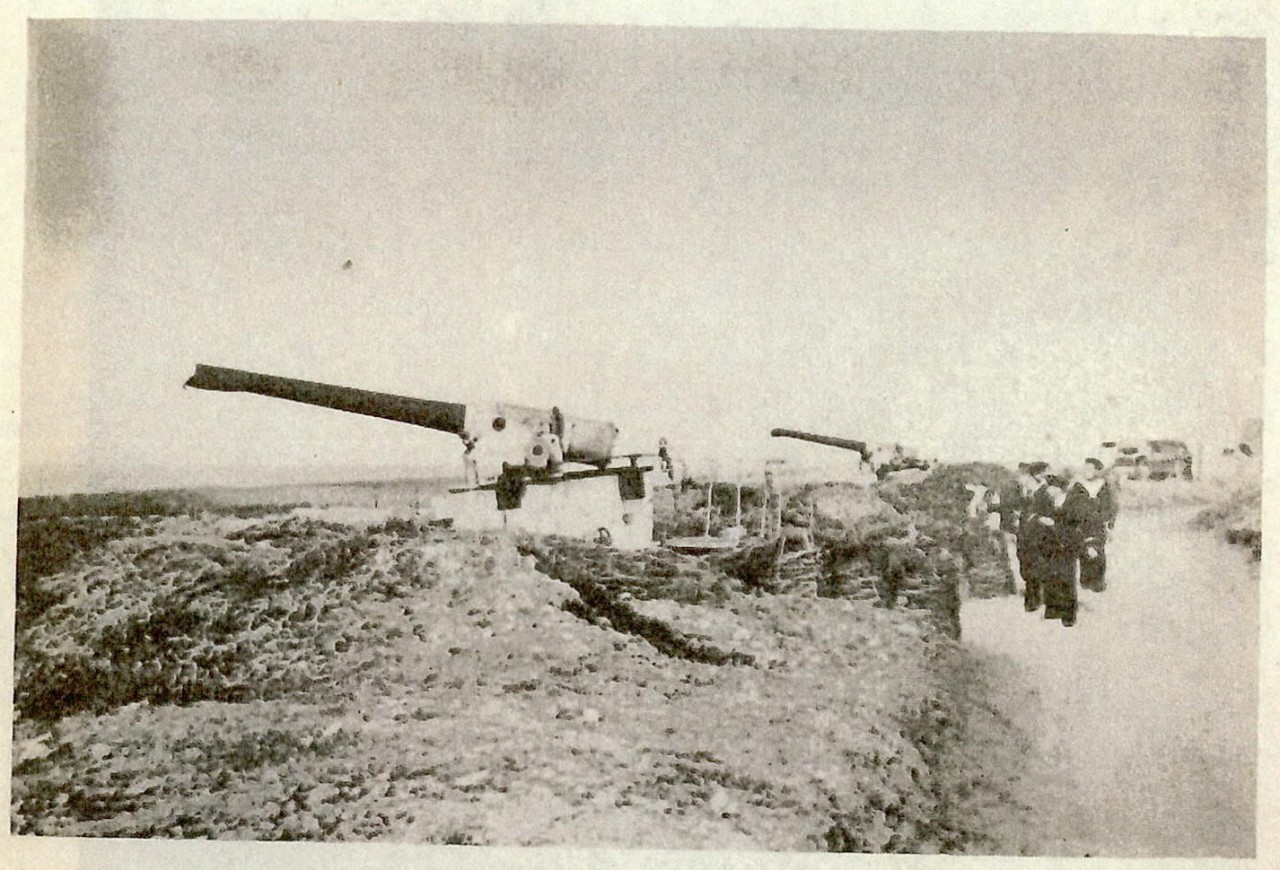
Naval battery at Mehdia
that under identical conditions of organization and training this feature of the operations could be repeated once in ten tries."
THE BATTLE OF CASABLANCA
Intelligence indicated that the French naval forces and land batteries on the Moroccan coast would probably offer resistance. A battle plan had accordingly been adopted in which targets were assigned to specific vessels of the Covering Group. That group now consisted of the Massachusetts (F), Tuscaloosa, Wichita; the destroyers Wainwright, Mayrant, Rhind, and Jenkins and the oiler Chemung. The Massachusetts had given the task of destroying the Jean Bart and the major caliber shore batteries. The forward turrets were to fire on the French battleship and the after turret on the heavier battery on Point El Hank. The Tuscaloosa had been assigned to submarines, cruisers, and other naval craft in Casablanca Harbor, in that priority. The Wichita was to open fire on the lighter battery on the tip of Point El Hank, then shift to submarines, cruisers, and other craft, thence to Table d’Aukasha.[21] The destroyers were to provide antisubmarine screen for the heavy ships, destroy enemy submarines should they sortie, provide defense against air torpedo and bombing attacks, and destroy enemy light vessels and shore installations as might be directed.
In the event that the Task Force Commander should receive an indication of the surrender of the port of Casablanca, or of the desire of the armed forces therein for the peaceful entry of the American armed forces, the commander of the destroyers (Capt. Moon in the Wainwright) would, upon signal, proceed with utmost regard for the mine fields, enter the harbor, and take the necessary steps to immobilize French naval vessels and shore batteries. This special mission was never called into operation in view of the hostile attitude of the French forces.
Admiral Giffen was in command of the Covering Group, subject, however, to Admiral Hewitt who was in command of the entire Task Force. The various organizations and subdivisions of the Task Force have been criticized as unnecessarily complicated. Without going into that mooted question, it should be pointed out that the detailing of an appropriate force to deal with the French naval units, leaving the fire support units
__________
21 The Jean Bart was moored to the southeastern end of the Môle du Commerce, the other vessels were berthed alog the Jetée Delure.
of the attack groups to give direct protection to the landings, was tactically sound and certainly proved effective. The French fleet was the main objective of the Covering Group, although in effecting its destruction that group inevitably came into contact with the shore defenses. The operations of the Covering Group, but they constituted a separate action designated to give indirect protection to the landing operations of all three attack groups by forestalling interference by the French naval units based on Casablanca.
The Battle of Casablanca falls into three phases. The first began with the opening moves for position and continued until the sortie by the French fleet which was completed at about 0830. The second phase is concerned mainly with the destruction of the French fleet, which was practically complete by 1300. The third and last phase is concerned with the engagement with the El Hank batteries and covers the period between 1300 until the retirement of the Covering Group at about 1600.
FIRST PHASE
7 November
| 0653 | Southern Attack Group released. |
| 1515 | Northern Attack Group released. |
| 1535 | Center Attack Group released. |
| 2215 | Covering Group changes and beings maneuver on parallelogram. |
| 2400 | Casablanca receives first alert. |
8 November
| 0300 | Casablanca receives second alert. |
| 0610-0624 | Nine planes launched. |
| 0641-0642 | Planes from Massachusetts encounter antiaircraft fire and hostile aircraft. |
| 0702 | Massachusetts open fire on enemy planes |
| 0703 | Gun flashes observed from El Hank and Jean Bart. |
| 0704 | Massachusetts opens fire on Jean Bart on first run. Tuscaloosa and Witchita follow. |
| 0720 | Massachusetts divides fire between El Hank and Jean Bart. |
| 0741 | Reserve run started. |
| 0751 | Wichita opens fire on Table d’Aukasha |
| 0818 | Cruisers concentrate on harbor mouth |
| 0833 | Covering Group ceases firing. |
The morning of 7 November found the Task Force proceeding in a general southeasterly direction. At 0655 the Southern Attack Group was
20
released and proceeded to its destination, Safi. Immediately thereafter the remaining groups changed course to 076.5ᵒ T., as if heading for the Straits of Gibraltar. At 1515 the North Attack Group was released and proceeded to its designation, Mehdia. At 1535 the Center Attack Group was released and, after some variations, ultimately settled down to a basic course of 145ᵒ T. In the meantime, the Covering Group, after a short run to the south, took an approximately parallel course of 144ᵒ T., which placed it about 10 miles to the southwest of the Center Attack Group is a position to cover it from any interference by the French fleet based on Casablanca. The plan called for the arrival of the three attack groups before their objectives about midnight when debarkation was to begin.
At 2215 the Covering Group changed course to 246ᵒ T. and proceeded to cover an irregular parallelogram designed to keep it between the Center Attack Group and Casablanca while debarkation was being effected and to bring it to a position to open fire on Casablanca at sunrise (0656) should it become necessary. After completing these four courses the Covering Group, at 0542 on the 8th took a course 245ᵒ T. and began the launching of planes. Between 0610 and 0624 nine planes had been launched as follows:
ANTISUBMARINE PATROL
| Tuscaloosa | 2 SOC-3 |
| Wichita | 1 SOC-3 |
SPOTTING
| Massachusetts | 2 OS2U |
| Tuscaloosa | 2 SOC-3 |
| Wichita | 2 SOC-3 |
The normal formation of the Covering Group was as follows: The heavy ships proceeded in column, distance 1,000 yards, the Massachusetts (F) in the van, followed by the Tuscaloosa and the Witchita in that order. The heavy ships were screened by the four destroyer in a semicircular formation about 3,000 yards ahead of the flagship, the Wainwright and Mayrant to starboard, the Rhind and Jenkins to port.
In the meantime the French naval authorities at Casablanca had received a first alert shortly midnight, followed by a more serious one at about 0300 of the 8th. Nevertheless, no reconnaissance patrols were undertaken. Whatever routine patrols were maintained were so
21
ineffective that our arrival off Casablanca was a distinct surprise. When, shortly before midnight on 7 November, our forces came within range of Point El Hank, the light was found burning. It was not extinguished until shortly after midnight.
It soon became apparent that the intelligence predictions to the effect that the French fleet and land batteries would offer considerable resistance were about to be realized. Intercepted messages from the Southern Attack Group thereupon began to maneuver itself into a position for the first run past Casablanca. At 0640, the course being 090ᵒ T, the group began closing the range.
At 0641 one of the spotting planes from the Massachusetts reported that it was under antiaircraft fire from the beach. One minute later the other plane reported that it had encountered hostile aircraft, followed at 0655 by a similar report from the first plane. At 0700 six fighter planes were observed ahead of the flagship at a very low altitude (about 1,200 feet) pursuing several of our SOC-3’s and one of our OS2U’s. The order was therefore given to the flagship to engage the enemy aircraft.
At 0703 gun flashes were observed from the direction of El Hank and the Jean Bart, followed by several large splashes near the Massachusetts. Indeed, it is believed that the El Hank battery straddled the flagship on the first salvo. Five or six very large splashes, presumably from shells fired by the Jean Bart, were observed about 600 yards short, on the starboard bow of the flagship. The engagement, which up till then had been limited to aircraft, now became general. The cruisers had been previously directed to open fire when the flagship did so without further signal.
On the morning of 8 November the wind was from the southwest, force one to two; sea moderate with slight swell. In general, weather conditions were excellent except for surface haze, particularly near shore. As the morning wore on, however, sun glare and reflection added to the difficulty of spotting and observation. Little could be done to improve conditions insofar as sun glare was concerned except by staying to the
22
northeast of the harbor, from which point the batteries of El Hank could not be bombarded.
At 0704 the main batteries of the flagship opened fire on the Jean Bart, range 24,400 yards, bearing 131.5ᵒ T. Thereafter, during the first run, the range to the Jean Bart varied from 23,200 yards at 0711, to 29,600 yards at 0740. During this period one hit on the Jean Bart, and two on the Môle du Commerce were noted. No radar ranges or bearings were obtained since the fire control radars on the flagship became inoperative after the second or third salvo. Air spot was also uncertain during this period because of the smoke, antiaircraft fire, and enemy fighters. Indirect fire based on a bearing obtained on the El Hank Lighthouse was used. After about 15 minutes, however, the main battery of the Jean Bart ceased firing and did not fire again during the day.[22]
At 0720 the flagship divided her fire. Turret No. 3 shifted to the El Hank battery while the forward turrets continued firing at the Jean Bart. The range of Point El Hank at this time was 22,900 yards, bearing 173ᵒ T.
During this opening period of the action the course of the Covering Group was 050ᵒ T. and thereafter, until 0730, speed varied from 20 to 27 knots. Various courses were steered, the mean course being 055ᵒ T. From 0730 until the end of the first run at 0741 the course was 090ᵒ T. Small changes in course and speed were made at frequent intervals in order to make it as difficult as possible for the enemy fire control. In general, course changes were made towards the last splashes (i.e., “chasing the splashes”). Later, this became impracticable in views of the fact that the heavier ships, particularly the flagship, were often straddled.
At 0705 the Tuscaloosa opened fire on the submarine berthing area in Casablanca Harbor, and at 0719 she shifted fire to the shore batteries at Table d’Aukasha, the opening range being 27,000 yards, minimum range 24,800 yards. Plane spot was used. After 20 minutes the batteries were silenced.
The Wichita opened fire at 0766 on El Hank, range 21,800 yards (using reduced charges) and at 0727 shifted fire (with full charges) to the submarine area in the harbor, range 27,000 yards.
At this stage of the operations enemy planes appeared in considerable numbers. At one time what were believed to be several French torpedo
__________
22 Turret No. 1, the only one containing guns, had become jammed.
23
planes were observed. These, however, did not come within antiaircraft range and made no attacks.
At 0741 the course was changed to south, preparatory to a reverse run to the westward, and at 0748 the course was steadied at 270ᵒ T. The forward turrets of the Massachusetts resumed fire on the Jean Bart. The initial range was 26,000 yards. It varied thereafter from 25,000 yards at 0756 to 31,600 yards at 0828.
At 0803, the course being, then 280ᵒ T., the flagship resumed firing at Point El Hank with turret number three, initial range 24,000 yards, the range thereafter increasing to 28,900 yards at 0818 and decreasing to 27,400 yards at 0831. Between 0828 and 0833 three salvos frim all three turrets were fired at Point El Hank at a mean range of about 27,000 yards.
The Tuscaloosa commenced firing on a second run at 0759 on targets in the harbor (initial range 22,500 yards), shifting at 0810 to Point El Hank (range 28,000 yards). Firing ceased at 0823 as the harbor targets were then out of range.
The Wichita opened fire at Table d’Aukasha at 0751, checked firing in a few minutes when a plane reported that the batteries there were not firing, and at 0806 resumed fire on the ships in the harbor, mean range 24,500 yards.
Both cruisers had been ordered at 0818 to concentrate on the harbor entrance after the planes had reported that the enemy submarines were preparing to sortie.
No hits were made on ships of the Covering Group during the first phase, although there were many splashes close aboard.
At 0830 a message was intercepted to the effect that the Army was encountering no resistance and that the Navy fire was damaging the city. Cease fire was therefore ordered at 0833 pending clarification of the situation. The Covering Group started to withdraw on course 340ᵒ T., although the secondary battery of the Jean Bart was firing what appeared to be two destroyers were observed standing out of Casablanca Harbor. The French were making a sortie frim Casablanca, thereby initiating the second phase of the battle.
24
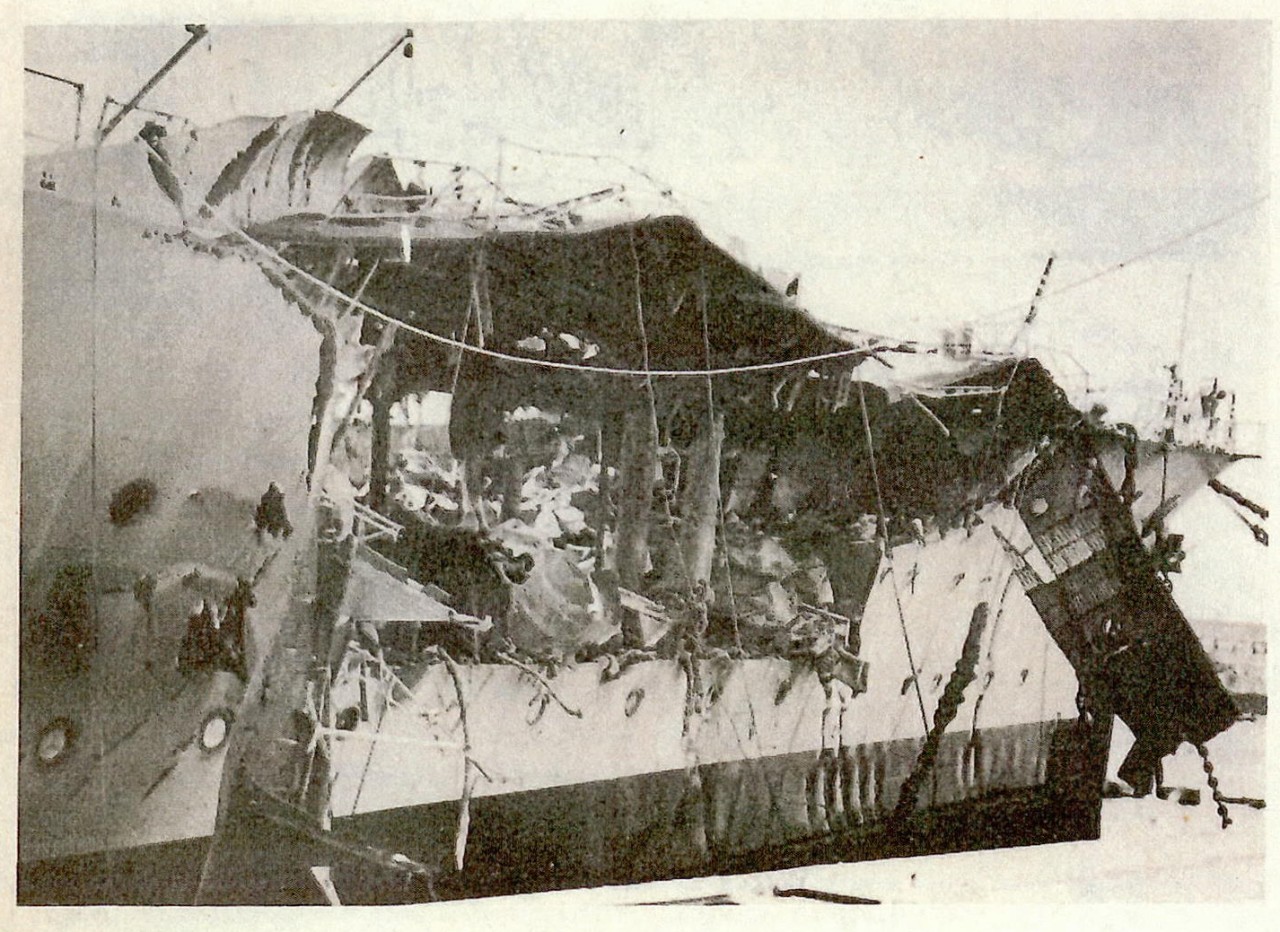
Damage to Jean Bart, bow
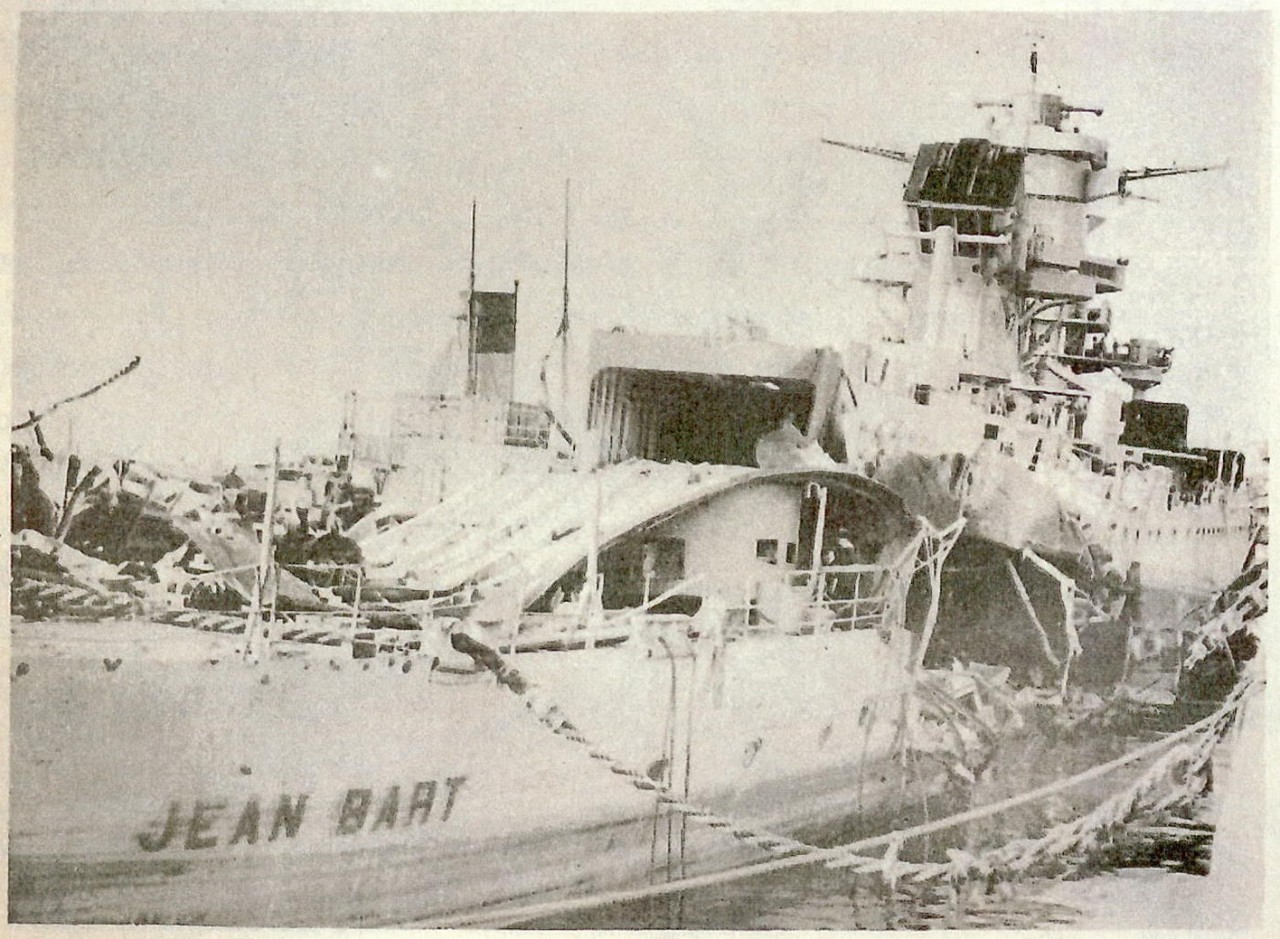
Damage to Jean Bart, stern
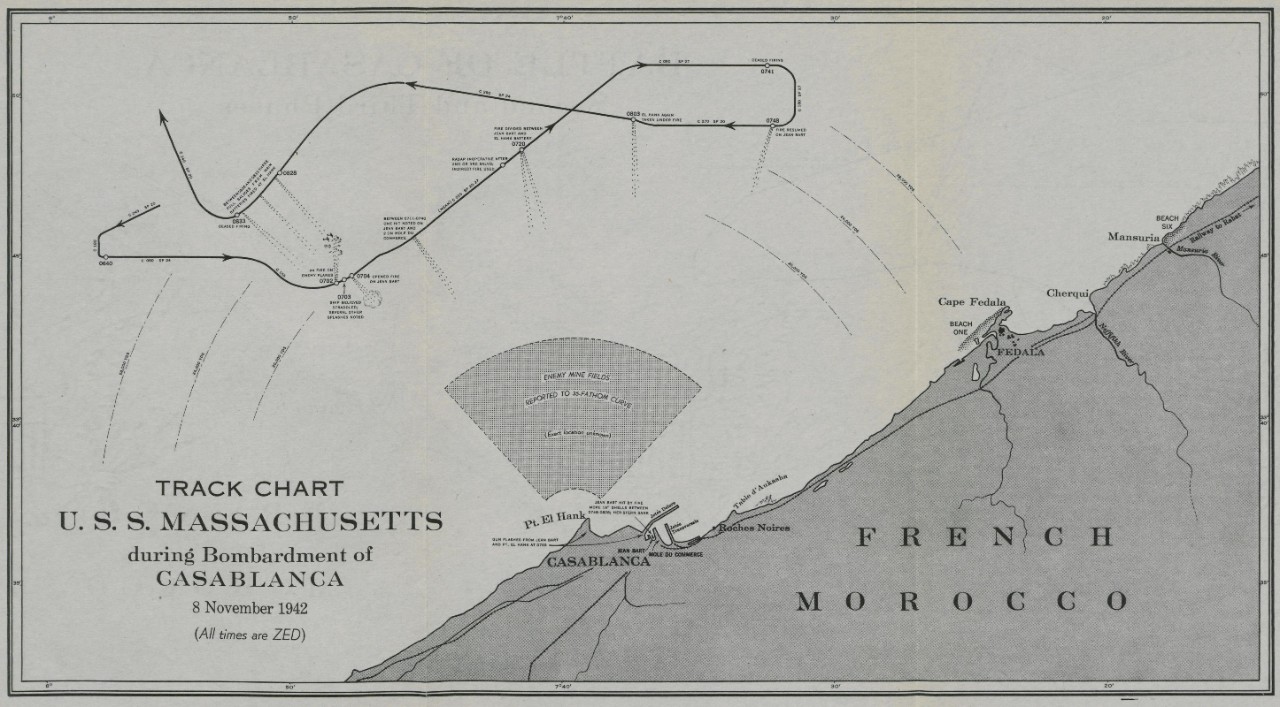
0-44-566293 Faces p. 24
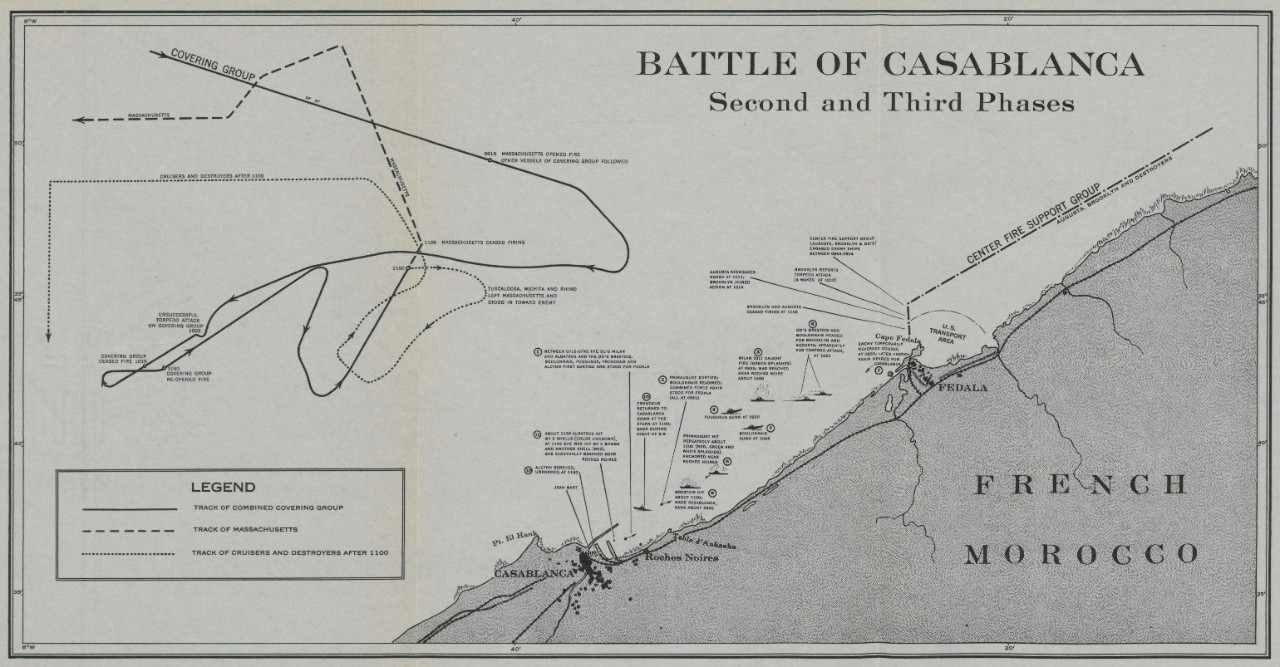
0-44-566293 Faces p. 25
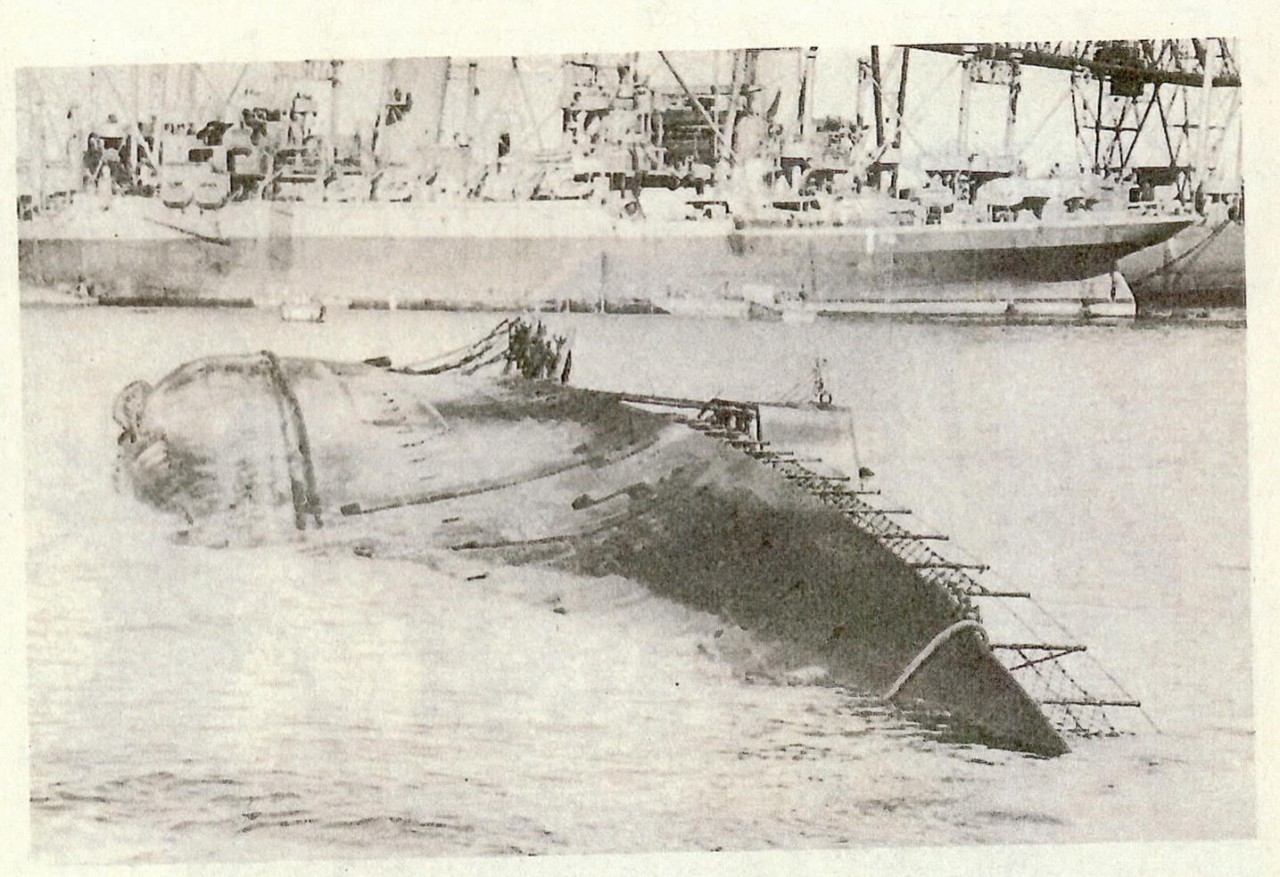
Wreck of the Frondeur
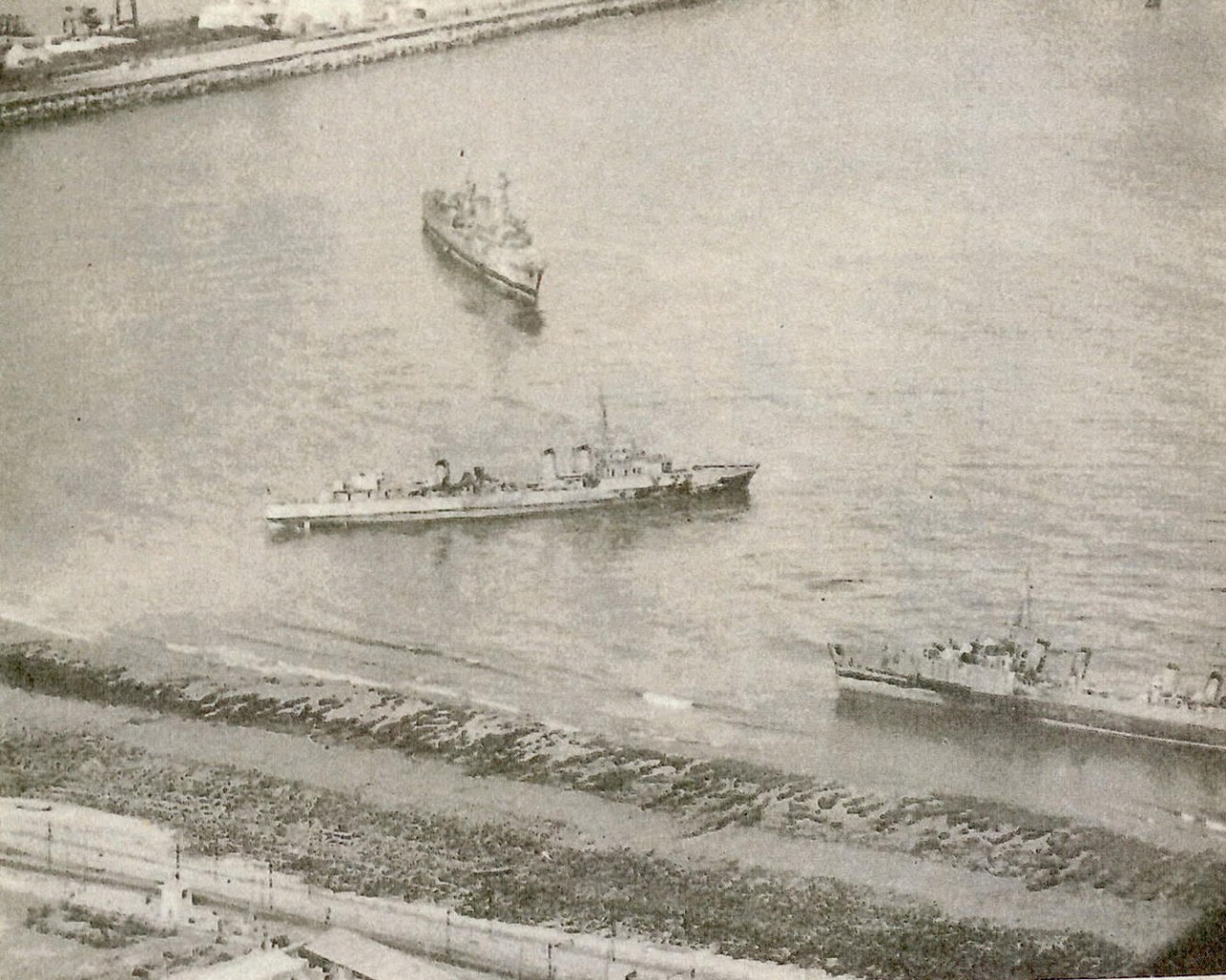
The Primauguet, Albatros, and Milan beached outside Casablanca
The outstanding event of the first phase had been the wrecking of the Jean Bart, which had been hit by 16-inch shells from the Massachusetts,[23] besides being struck by two small bombs. As a result her stern settled until she rested on the bottom.
SECOND PHASE
| 0610-0730 | French submarines sortie. |
| 0715-0745 | French destroyers sortie. |
| 0818 | Augusta plane reports movement. |
| 0820 | Milan opens fire. |
| 0843 | Augusta opens fire, followed by Brooklyn. |
| 0918 | Massachusetts opens fire, followed by Wichita and Tuscaloosa. |
| 0925 | Massachusetts disables Milan and Fougueux. |
| 1000 | Primauguet sorties. Fougueux sinks. |
| 1003-1021 | French submarines attack. |
| 1045 | Boulonnais sinks. |
| 1100 | Massachusetts withdraws to save ammunition. Brestois, Frondeur and Primauguet hit. |
| 1106-1142 | Tuscaloosa, Wichita and Rhind engage enemy vessels attempting to regain Casablanca. Wichita hit by shell. |
| 1145 | Cruisers of Covering Group sweep coast to southward. Albatros damaged. |
| 1300 | Cruisers rejoin Massachusetts and withdraw to northwest. |
The second phase of the action was the destruction of the French naval units which sortied from Casablanca.
The French warships in Casablanca Harbor proved to be the battleship Jean Bart, the light cruiser Primauguet, the flotilla leaders (contretorpilleurs) Milan (F), Albatros, Le Malin, the destroyers Alcyon, Boulonnais, Brestois, Fougueux, Frondeur, Simoun, Tempête, the submarines Amazone, Amphitrite, Antiope, Conquérant, Méduse, Oréade, Orphée, Psyché, sidi-Ferruch, Sybille, Tonnant, and the sloops Commandant Delage Gracieuse, Grandiére.[24] They were under the command of Rear Admiral Gervais de Lafond.
As has been noted, the French fleet in the harbor had for some time been subject to a devastating bombardment. The Jean Bart had been wrecked by the fire of the Massachusetts. The submarines Amphitrite, Psyché and Oréade had also been sunk at their moorings by the
__________
23 Two of these shells are known to have exploded. Two orders struck at such angles that the base of each was deformed and the fuze and explosive content forced out before detonation. However, one of these “duds” was the shells which jammed turret No. 1 in train and thus prevented the ship from firing for several crucial hours.
24 Cf. intelligence report above.
25
bombardment. The flotilla leader Le Malin, while moored to the Jetée Delure, was hit by a shell from the Massachusetts which struck the jetty, tunneled through, and entered the port side of the vessel without exploding, causing a bulge outward on the starboard side. The Le Malin did not sortie, nor did the destroyers Simoun and Tempéte, then undergoing repairs.
Between 0610 and 0730 the submarines Amazone, Antiope, Conquérant, Méduse, Orphée, Sidi Ferruch, Sybille and Tonnant had sortied. The subsequent operations of these vessels cannot be definitely stated. Their ultimate fate is all that us known beyond doubt. The Méduse was beached near Mazagan. The Tonnant reached Cadiz and was scuttled by her crew on 15 November. The Amazone and the Antiope managaged to make Dakar. The Conquérant, Sidi Ferruch and Sybille were never reported. The Orphée was the only submarine to return to Casablanca.
Between 0715 and 0745 the French destroyers put to sea and headed northeast in the following order: Destroyer Division II (Milan, Albatros), Destroyer Division 5 (Brestois, Boulonnais), Destroyer Division 2 (Fougueux, Frondeur, Alcyon). Each division was in column and the columns in echelon. The Primauguet did not sortie at this time.
At 0818 a plane from the Augusta reported the movement to the Task Force Commander, who relayed the information to the Covering Group at 0822 and to the Air Group 0840. At 0859 the Covering Group was ordered to head for Fedala, speed 27 knots, and at 0915 received orders to destroy the French vessels.
In the meantime the cruisers of the Center Fire Support (Augusta, Brooklyn) together with four destroyers (Wilkes, Swanson, Ludlow, Rowan) were streaming at 27 knots to intercept the oncoming French vessels.[25] At 0820 the Milan opened fire on the Wilkes. Her shots were short. At 0835 Destroyer Division TWO opened fire. The Augusta replied at 0843, followed at 0848 by the Brooklyn. Firing continued until 0904 at ranges from 13,000 to 24,000 yards. At 0855 the French destroyers temporarily reversed their course but soon returned to the attack, whereupon the Brooklyn resumed fire at 0909 and the Augusta
__________
25 No track chart of the French ship movements is available. The track chart of the Center Fire Support is too involved to reproduce. The evolutions of those vessels covered a small area and were designated to keep them within range of the French as long as possible without prejudice to the protection of the transport area.
26
0915. The French vessels broke the engagement about 0920 and headed back to Casablanca.
On the way they were engaged by the Covering Group. At 0918 the Massachusetts opened fire, followed by the Wichita at 0919 and the Tuscaloosa at 0925. The French returned the fire at once. Their fire control was excellent. The Massachusetts was hit twice, with slight damage. Another shell passed through the flagship’s colors. These hits. However, may have come from El Hank battery.
It was during this period that the French sustained their first losses. At 0925 the Massachusetts reported that the flotilla leader with which she had been engaged was seen with only her bow out of water. This undoubtedly was the Milan, which had been hit by three shells below the water line and two or three near the bridge and had caught fire twice. She was ultimately (1400) beached near Roches Noires. The flagship then shifted to another target which appeared to be a destroyer. After three salvos the target completely disappeared. She was probably the Fougueux, which sank about 0930 in latitude 33ᵒ 42’ N., longitude 07ᵒ 37’ W. At 1016 the Covering Group ceased firing.
At this point the Center Fire Support reengaged the retreating enemy, the Brooklyn opening fire at 1015 and the Augusta at 1025. At 1030 the Covering Group resumed firing. A “melee engagement” with the French destroyers ensued during which, at 1045, the Brooklyn received her only hit by a shell which, although it did not explode, injured six men.
At this stage of the action the Primauguet sortied from Casablanca, rallied the Boulonnais, which had damaged her steering gear and had fallen behind, and proceeded once more up the coast toward Fedala with the other destroyers. The French vessels soon found themselves under the combined fire of the Covering Group and the Center Fire Support. Hits began to accumulate. At 1045 the Boulonnais sank in latitude 33ᵒ 40’ N., longitude 07ᵒ 34’ W., mainly as the result of fire from the Augusta. The remaining destroyers (Frondeur, Alcyon) formed on the Brestois. At about 1100 this vessel took a bad list and with difficulty managed to return to port where she capsized off the Jetée Delure at 2400. The same fate befell the Frondeur which returned to port about the same time down by the stern. She sank at her berth during the night. It is impossible to assign the hits on these three vessels. Their destruction was
27
probably the work of several ships. The color splashes reported by the French would so indicate.[26]
At 1102 the Center Fire Support ceased firing except for occasional long range shots by the Brooklyn.
By 1100 the Massachusetts had expanded 60 percent of her 16-inch ammunition and the preservation of the remainder was considered essential against a possible sortie by the Richelieu from Dakar. The cruisers of the Covering Group had expended an even higher percentage, but it was felt that their attendant upon further depletion of the flagship’s main battery ammunition. Accordingly, at 1102, the commanding officer of the Tuscaloosa was ordered to take the Wichita and the Rhind under his command and close with the enemy light forces. At 1106 the flagship ceased firing and hauled away to the northward while the cruisers and the Rhind stood in and engaged the enemy vessels which were attempting to regain the harbor. Firing continued until 1142. It was while engaging the enemy at close quarters that the Wichita was hit by a French shell (1128) which injured 14 men.
By this time the only French vessels afloat were the Primauguet, Albatros and Alcyon. Shortly after 1100 the Primauguet was badly hit, five shells striking below the water line and an 8-inch shell in No. 3 turret. She came in and anchored off Roches Noires. (Between 1400 and 1700 she was bombed and strafed and her whole forward half wrecked. A direct hit on the bridge killed the captain, the executive officer and 7 other officers.) About one-half hour later (1130) the Albatros was hit by 2 shells, 1 of which was below the water line forward.[27] At 1145 she received 2 bomb hits amidships. Completely helpless, she asked for a tow. While being towed back to Casablanca she was shelled and strafed. She was eventually beached at Roches Noires. Of a crew of 200, 25 were reported killed and 80 wounded. The inly surface vessel to return safely to Casablanca was the destroyer Alcyon which made port about 1130.
At about noon the three sloops Commandant Delage, Grazieuse and Grandiére, which had remained in the harbor during the engagement,
__________
26 The color splash of the AP ammunition used by the Massachusetts and the Brooklyn was green, that of the Augusta red. The destroyers did not use color splashes. The bombardment ammunition of our cruisers was also free from color.
27 The French timetable, from which these times are taken, only gives approximate times.
28
sortied to pick up the survivors of the Boulonnais, Fougueux, and Milan. While so doing they became engaged with the Augusta and the Brooklyn at 1326. The Graniére was slightly damaged by bombs at 1330.
At about 1145 a message was intercepted from the Task Force Commander stating that an enemy cruiser was laying a smoke screen southwest of Casablanca and heading down the coast. The cruisers of the Covering Group, screened by the Rhind, were order to sink her. No trace of this cruiser was found so at 1300 our cruiser headed back to rejoin the flagship.
With the withdrawal of the Covering Group the second phase of the battle ended. It had witnessed the practical annihilation of the French fleet.
NOTE: The sortie of the French fleet had been the occasion for some submarine activity. At 1003, just after the course had been change from 250ᵒ T. to 230ᵒ T. (see tracked chart of Massachusetts), the wakes of four torpedoes were sighted by the executive officer of the Massachusetts about 60ᵒ on the port bow at a distance of less than 1,000 yards. By skillful maneuvering the flagship passed between numbers three and four in the spread, counting from the left. Number four torpedo passed a few feet outboard of the starboard paravane. All ran very shallow. It is believed that they were fired by a submarine at a range of between 4,000 and 5,000 yards. Emergency signals were made by flag hoist to the ships astern. After avoiding the torpedoes, the ship changed course to 240ᵒ T. At 1018 the course was changed to 090ᵒ T. in order to overtake what appeared to be a submarine on the surface and a ship on the port quarter. At 1021 another torpedo wake was sighted and passed about 100 yards to port. In the meantime, at 1010, an unsuccessful submarine attack was made on the Brooklyn. The wakes of four torpedoes were observed, as well as the bubbles from the tubes.
THIRD PHASE
| 1326 | Covering Group begins search for enemy vessels reported proceeding to Fedala. |
| 1341 | Massachusetts located one destroyer. El Hank open fire. |
| 1355 | Cruiser of Covering Group continued search, advancing to mouth of Casablanca Harbor. |
| 1450 | Land batteries at Casablanca compel retirement. |
| 1558 | Massachusetts fire salvo at El Hank, then retires with Covering Group. |
29
The third phase of the engagement began with a search for French units which were reported steaming along the coast with the probable intention of interfering with our landing operations. The action soon developed, however, into an attempt to silence the persistent batteries at Point El Hank which had maintained an intermittent fire during the entire battle. These batteries, as well as the other fixed defenses, were manned by naval personnel, which probably accounts for their determined resistance.
At 1302 a message was received from the Task Force Commander that two cruisers and a destroyer had been reported standing up the coast from Casablanca to Fedala. At this time the Covering Group cruisers and the Rhind had not yet rejoined from their sweep to the southwest in pursuit of another French cruiser which had been reported as having slipped through. At 1326 the Covering Group set course 080ᵒ T. toward Fedala and increased speed to 27 knots, At 1340 the Massachusetts opened fire in a light vessel, bearing 136ᵒ T., range 22,000 yards. If the French timetable is correct, the only vessel that could possibly have been in the neighborhood of Fedala was one of the three sloops. Only two salvos, however, were fired at this target, as the El Hank batteries opened at 1341 with excellent aim. All turrets were shifted accordingly to that target at 1345. The range was 19,000 yards, increasing gradually to 23,000 yards when firing ceased at 1350.
About this time the Task Force Commander ordered the Covering Group to destroy before nightfall the light forces which appeared to be making sorties frim Casablanca. At 1355, accordingly, the cruisers, plus the Rhind, stood in toward the harbor, this time from the direction of Fedala in ordered to avoid gunfire from El Hank. An enemy vessel, undoubtedly the Brestois, was shelled near entrance at range of 17,000 yards. No gunfire was observed from the French ships but the shore batteries again forced retirement at about 1450. At that time two other enemy vessels were observed outside the harbor, near the entrance. One of them (obviously the Milan) was on fire, another (probably the Albtros) was beached.
At 1423 the Massachusetts received orders from the Task Force Commander to preserve ammunition for a possible sortie of the Richelieu from Dakar and, as a result, broke off the action. There were, however, several loaded 16-inch guns on the flagship and it was decided to unload them on Point El Hank. This was done at 1558 at a range of about
30
30,000 yards. After one ranging shot a six-gun salvo was fired. Although over, the Salvo apparently hit explosive or inflammable stores. As an unusually large explosion was noted.[28]
Shortly thereafter the flagship was joined by the cruisers and the group stood out to sea, thereby terminating the third phase of the battle.
Summary
The performance of the Covering Group in clearing the way for the troop landing had been an outstanding one despite the failure of the radar to function properly on the larger units of the fleet. The concussion of the large caliber guns soon put the greater number of the radar range finders out of commission. As a result the expenditure of ammunition was much greater than had been anticipated.
The following table is illuminating.
| Ship | Battery | Percent Expended |
| Massachusetts | 16 inch 5 inch |
67 2.25 |
| Tuscaloosa | 8 inch 5 inch |
85 1 |
| Wichita | 8 inch 5 inch |
83 7 |
| Wainwright | 8 inch 5 inch |
25 |
| Rhind | 5 inch | 8 |
| Mayrant | 5 inch | 30 |
| Jenkins | 5 inch | 6 |
It will be noted that the Massachusetts, Tuscaloosa, and Wichita had expended so great a portion of their heavy caliber ammunition that they would have been seriously embarrassed if compelled immediately to go into action against the larger units of the French Navy.
A similar state of affairs existed on some of the other vessels of the fleet. The Brooklyn, which had been operating off Fedala, reported a total ammunition expenditure of 75 percent.
The performance of the French naval forces, both ships and batteries, throughout the entire engagement was excellent. Their gunnery was accurate, straddles being frequently made on the first salvo. That more hits were not scored on our vessels was due to the skill with which they
__________
28 As only AP 16- inch shells had been issued to the Massachusetts, the damage inflicted on shore batteries was less than that obtainable had HC shells been employed. The Massachusetts, however, had to be prepared to fight the Richelieu as well as the Jean Bart.
31
maneuvered and to the high angle of fall of the French projectiles at long range.
The opinion of the officers of the Massachusetts, which had been principally engaged in the destruction of the Jean Bart, was that the French ship fired only five or six salvos.[29] In all probability she was receiving electric power from the shore, and fairly early in the engagements this power was temporarily cut off by a shell from the Massachusetts. During the engagement she put up a smoke screen generated from the dock and kept it over her throughout the day. As a result the Jean Bart was not definitely silenced until the afternoon of the 10th, when she was bombed 1,000-pound bombs, one of which struck her starboard side aft. In spite of the destruction wrought by these bombs, the vessel’s 15-inch guns and fire-control apparatus were still serviceable.
Toward the end of the first run the officers in the Massachusetts believed that the batteries at El Hank were out of commission but this supposition proved to be erroneous. The shells from the American vessels probably temporarily compelled the crew of the batteries to seek shelter. After our vessels ceased firing the French repaired whatever slight damage had been caused and continued firing whenever the American vessels came within range.
In the Battle of Casablanca our surface ships enjoyed excellent air support. The Ranger, accompanied by the Cleveland and screened by the Ellyson, Corry and Hobson, was operating off Casablanca. The Suwannee and Chenango, screened by the Forrest and Fitch, were in the same vicinity. The Suwannee conducted combat air and antisubmarine patrols for the carriers as well as for the ships off Fedala.
At 0615 the Ranger launched 18 fighter planes to neutralize the Rabat-Sale airport, and at 0635 17 scout bombers to attack submarines and surface ships at Casablanca and the batteries at El Hank and Table d’Aukasha. At 0700 the Suwannee launched 8 TBF’s to destroy submarines and surface ships at Casablanca, while the Ranger sent 18 fighters to the same area. These planes supplemented the bombardment by our surface ships, and when the French vessels sortied our planes attacked
__________
29 In view of the fact that the Jean Bart had never had any target practice and could not use her larger range finder because of the neighboring building, her accuracy of fire was remarkable. Her rate of fire, however, was slow. So was that of the other French vessels.
32
them with bombs and by strafing. The latter was particularly effective against the lighter vessels, and our airmen believed it played an important part in turning them back to the harbor. At 1252 the Task Force Commander ordered our planes to cease attacking the French warships in the harbor, but to continue attacks to cease attacks on those outside. At 1306 the Ranger launched planes to destroy enemy vessels standing out of the harbor, but with orders not to block the channel. An hour later 16 fighters were launched to attack the light forces which appeared to be making sorties.
Meanwhile the shore batteries had been bombed repeatedly. By evening the Jean Bart had been hit at least once, and undetermined damage had been inflicted on other vessels. The Ranger alone had launched 205 flights, which “secured complete air superiority and gravely damaged Vichy naval units and shire batteries in the Casablanca area, which was the center of the military defense of French Morocco.”
In closing this summary of the naval action of 8 November, it should be noted that the rank and file of the French Navy fought doggedly, courageously, and skillfully against heavy odds.[30] What is less obvious, however, is their motive for so doing. It is probably to be found in the high sense of professional honor that had always characterized the French naval service. Our forces had not heard the last of the French Navy. Two days later, on 10 November, the Gracieuse and Commandant Delage sortied again and started to shell our troops northeast of Casablanca. The Augusta, supported by the Edison and Rowan, engaged them, firing 10 salvos between 1139 and 1156, at ranges of 16,000 to 18,000 yards. The Commandant Delage was hit, whereupon the French sloops withdrew. This sortie may well have been for the purpose of enticing some of the American vessels within range of the guns of the Jean Bart, which were one more in working order.
__________
30 Unofficial estimates place the French losses at about 500 killed and 800 wounded. Among the seriously wounded was Rear Admiral Gervais de Lafond. The moral of the French naval forces has been summed up by one ranking officer as follows: “Honestly demands that the lassitude, notwithstanding their bravery, of the French, and the providential good luck attending the United States forces, be recognized as heavy contributing factors. No other enemy, equipped with air and submarines, would have failed to detect the approaching force by or before dark the day before their appearance off shore, or failing that, could have been alerted 6 hours before daylight by the presence of enemy ships 16 miles from his principle base, and failed to used his 11 submarines before daylight and his air force by or before daylight.”
THE ATTACK ON MEHDIA AND THE PORT LYAUTEY
AIRFIELD (NORTHERN ATTACKS)[31]
The operations against Mehdia and the adjoining airfield at Port Lyautey had as their object the securing of that harbor and airfield with a view of employing them in the subsequent attack on Casablanca, 65 miles to the south.
The United States force engaged was the North Attack Group (Task Group HOW 8), Rear Admiral Kelly, consisting of the following units:
Fire Support: Texas (F), Savannah, Roe, Kearney, Ericson.
Transports: Algorab, Henry T. Allen, Susan B. Anthony, Anne Arundel, George Clymer, Electra, Florence Nightingale. John Penn. A/S Screen and Minesweepers: Livermore, Eberle, Parker, Raven, Osprey.
The destroyer Dallas was on a special assignment to proceed up the Sebou River to Port Lyautey. The oiler Kennebec, with two specially constructed fire support craft on board, was attached to the Northern Attack Group. The seaplane tender Barnegat, Comdr. Felix L. Baker, joined from the United Kingdom on 7 November and was assigned to the Port Lyautey operation.
The functions of the naval force were to be as follows:
(1) To land the troops at designated beaches at H-hour (0400).
(2) To unload equipment and land same ashore.
(3) To serve as fire support for the Army units ashore.
(4) To screen and support the transport area and to maintain anti-surface, submarine and air patrols.
The Army contingent (Task Group ZEBRA) forming part of the Northern Attack Group was under the command of Brig. Gen. Lucian K. Truscott, Jr. and consisted of the following units:
Sixtieth Infantry, Ninth Division, reinforced.
Ranger Detachment, United States Army.
One light armored battalion combat team, Second Armored Division.
Total: 526 officers, 8,573 enlisted men, 65 light tanks.
Following the general pattern of the campaign, command of the landing forces devolved on the Army as soon as satisfactory beachheads were established.
__________
34
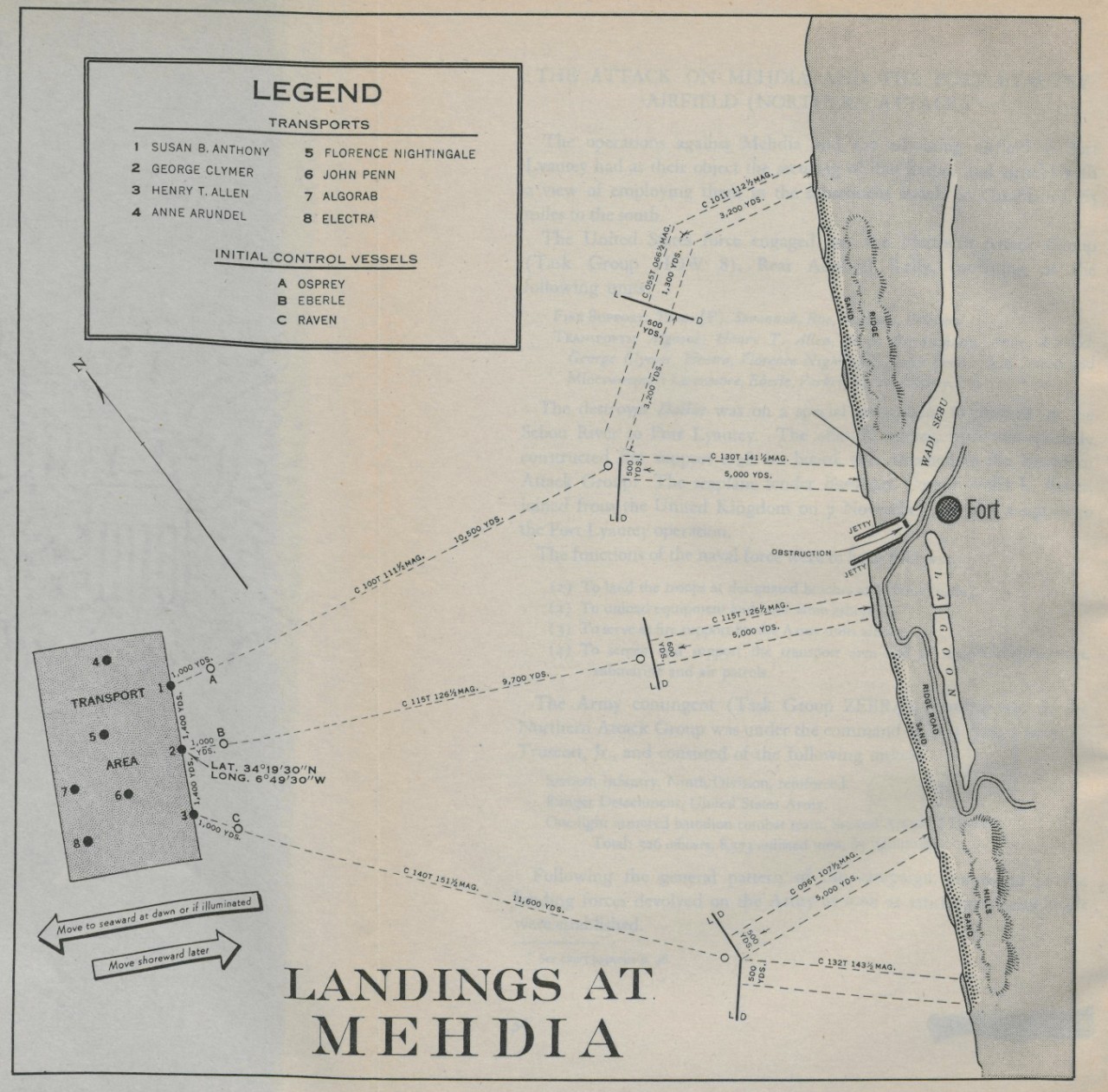
0-44-566293 Faces P. 35
7 November
1900 Roe detached to locate beacon submarine.
2150 Roe retired after failing to locate submarine.
2321 Northern Attack Group reaches transport area.
8 November
0200 Dallas embarks Ranger detachment and Fighting French detachment.
0411 Fire support vessels take station.
0515 First landing made
0605 French open fire on landing parties.
0607 Six planes launched.
0629 Shore batteries at Mehdia open fire on Roe. Roe replies.
0652 Savannah and Roe attack by enemy planes.
0710 Orders for general offensive given.
0720 Enemy air offensive increases. Landing parties strafed.
0747 Twenty F4F’s arrive to give air coverage.
0755 Savannah opens fire on Kasba.
1140 Dallas attempts to enter river. Forts compel retirement.
1343 Texas opens fire on Port Lyautey. Kasba penetrated.
1621 Shore batteries silenced. Savannah ceases fire.
9 November
0750 Savannah opens fire on enemy tanks.
1027 Savannah ceases fire as American tanks advance.
10 November
0600 Dallas enters river.
0737 Dallas lands Ranger detachment at Port Lyautey.
1107 Port Lyautey airfield occupied. Kasba isolated.
The airfield of Port Lyautey is situated about 9 miles up the Sebou River at the end of a long bend. The town itself is about 2 miles further upstream. Port Lyautey was undefended except for some mobile artillery and antiaircraft guns. The river mouth at Mehdia, however, was defended by the two batteries previously mentioned. Besides these fixed defenses the French had mounted two field pieces on flatcars that could be moved up and down the south bank of the river as needed. A lagoon 3½ miles in length runs parallel to the coast and added considerably to the strength of the French position. The original plan of attack called for landings on five beaches and a run past the batteries of Mehdia and up the river by the Dallas.
35
At 1900 on 7 November the destroyer Roe departed from the formation to locate the beacon submarine off the entrance of the river. Although she was challenged once, no action developed. In spite of a thorough searched the submarine could not be located. Due to shortage of time and the necessity of obtaining fixes, the search was discontinued shortly after 2150, and the Roe approached the mouth of the river and reported several fixes by voice radio to Admiral Kelly. This done, the Roe took station about 2,000 yards from the river jetties. At 2321 the transports arrived in the transport area located about 7 miles off the mouth of the river.
On Sunday, 8 November, weather conditions were: wind from the northeast, force 5 to 12 knots, partly cloudy, sea smooth.
At approximately 0200 on 8 November, the Dallas received on board the Ranger detachment from the transport Susan B. Anthony. Mr. René Malavergne of the Fighting French, former chief pilot of the Sebou River, came on board with the Rangers preparatory to piloting the Dallas up the river, her mission being the capture of the airport at Port Lyautey.
At 0310 the Texas and the Savannah intercepted radio press reports from Washington announcing the landing of American and British forces in the vicinity of Oran and Algiers. The hour of the Algerian debarkations had been set 3 hours ahead of the Moroccan landings were delayed nearly until morning twilight in order to enable these attack groups to continue as long as possible the deception as to real destination. In spite of these announcements a complete surprise was effected.
At 0411 the destroyers of the Fire Support took their stations; the Roe to the south of the river mouth, the Kearny to the north of the river mouth, the Edison in reserve.
In the meantime the assault troops had been placed in the landing boats, the operation having been begun shortly after midnight. Three methods of debarkation had been provided for, depending upon weather conditions. In the first the ships were to anchor at their positions in the transport area. This was considered the ideal method but was not used became of the increasing wind. The second method provided that the ships should keep under way. Making a lee first to port then to starboard. The third method provided that the sips should anchor long enough to hoist out boats and lighters and then lie to with a lee to starboard. The second method was the one adopted.
The boats used in the North African landings represented the latest
36
developments in amphibious equipment at the time, although many of the designs have since been suspended. The type used are too numerous to be described in detail, ranging all the way from small rubber boats with outboard motors and having a capacity of 7 men, to craft capable of carrying 120 men. All were flat-bottomed so as to permit running well up on the beaches. The larger ones were snub-nosed and equipped with ramps forward that lowered so as to form a runway for motor vehicles. Some type were armored and mounted 30- and 50- caliber machine guns. The specially constructed fire-support craft carried on the Kennebec, Merrimack, and Winooski were equipped with two multiple rocket projectors which permitted lobbing a shower of explosive on the enemy position immediately prior to the arrival of the assault troops.[32]
Owning to the weight involved, loading had to be made into waterborne craft. This procedure proved troublesome and risky as the men, even those in the first waves, were carrying full equipment. The metal nets down which the men climbed into the boats were found to be slippery and frequently cut the hands. The rope nets stretched easily and occasionally fouled the propellers of the boats.
The Navy retained control of all boats during debarkation. In view of the many novel features of the landing craft employed, some Army reports have advanced the theory that the command of the landing boats should devolve on the Army as soon as they leave the side of the transports.
The debarkation plan called for the formation of wave of combat-loaded landing craft around the three easterly transports, the Henry T. Allen, the George Clymer and the Susan B. Anthony. Once assembled,
__________
32 In Morocco the landing were effected mainly by the following type:
LCP (L). Landing Craft Personnel (Large). Displacement: 12,500 lbs. Dimensions: 36 ft. by 10 ft. 6 in. Draft: 3 ft. Capacity: 30 to 36 men or 6,700 to 8,100 lbs. cargo. Speed: 10 m.p.h. Endurance: 200 miles. Armament: two .30-caliber machine guns.
LCP (R). Landing Craft Personnel (with ramp). Specifications same as above except for 2 inches additional beam and 42-inch ramp forward.
LCS (L). Landing Craft Support (Large). Displacement: 25 long tons. Dimensions: 46 ft. 11 in. by 12 ft. Draft 3 ft. forward, 4 ft. aft. Capacity: Crew only, 1 officer and 11 enlisted men. Speed: 11.4 m.p.h. Endurance 70 miles. Armament: one 2-pdr.; twin .50 –caliber MG; one 4” smoke mortar; 1 smoke apparatus. Armor: 6-, 9-, and 14-mm. non-magnetic. Propulsion: two 165-hp. Diesel engines.
LCS (S). Landing Craft Support (Small). Displacement: 20,000 lbs. Dimensions: 36 ft. 6 in. by 10 ft. 9 in. Draft: 3 ft. Capacity: 3 or 4 in addition to crew of 6. Speed 16 m.p.h. Endurance: 60 miles at full speed. Armament: two .50-caliber and three .30-caliber MG. Armor: ½ in.
the boats of the first wave were to form a controlled V behind each of three escort vesselsstationed at initial control points 1,000 yards from the transport area, the Osprey for the Anthony group, the Eberle for the Clymer group and the Raven for the Allen group. From these initial control points the groups were to proceed to final control points at designated lines of departure distant 10,500, 9,700 and 11,6000 yards respectively from the initial control points and approximately 5,000 yards from the shore. By H minus 25 the V headed by the Osprey was due on the northern line of departure and at H minus 20 the Eberle and her V on the enter and the Raven and her V on the southern line of departure. The run from the lines of departure to the beaches was to be made under the cover of Fire Support and the landing craft support boats.[33]
The succeeding waves were to follow at 10-minute intervals, each keeping the preceding waves in sight and exercising care not to “pile up.” This schedule, had it been maintained, would have landed the first wave at H-hour and the seventh wave at H plus 1 hour. The disembarkation operations, however, were attended with considerable delay and confusion owing to the darkness. As a result the first waves did not land until 0515, one hour and a half late.
The most southerly of the beaches chosen for the landings was clear of the lagoon. Here aerial reconnaissance had disclosed what seemed to be a concrete pill box. When this proved to be a tomb, that landing was countermanded. About one-half mile to the north another beach had been chosen. These two landings were accordingly consolidated. The main attack, however, was to be delivered immediately south of the Sebou River. Here a causeway leads from a bathing resort across the lagoon to Mehdia. Two landings were also to be made north of the river with the object of occupying two heights, one below the bend of the river and one at the bend. The two last-named landings were also consolidated at the last minute. These eliminations reduced the area to be attacked to three beaches, one 3 miles below the mouth of the Sebou River, one some 4 miles to the north of the river, and one close to the southern river jetty. The first two landings were practically unopposed so that the central attack at the river mouth is the only one we need consider. Here some of the sharpest fighting of the campaign occurred.
Although the 10-minute schedule could not be maintained, 7 waves were successfully landed before the shore batteries compelled the retirement
__________
33 See diagram. This plan being typical, those for the other landings will be omitted.
38
of the transports to a position out of range. Eighteen boats were usually employed on each of the 7 waves, the total number of boats available on the transports being 162.
The action began at 0523 when a searchlight was observed near the Kasba,[34] followed by small arms fire. Mindful of the instructions not to precipitate a conflict with the French if it could possibly be avoided, the commander of the Task Force directed the Roe to ignore the fire. At approximately 0605 the Eberle reported that a shore battery had fired one salvo at the landing boats. The Eberle was thereupon ordered to return the fire. The searchlight was promptly extinguished. At 0607 the Savannah catapulted four planes, two for spotting and two for antisubmarine patrol. Two Texas planes were also put in the air. At 0629 enemy shore batteries opened fire on the Roe, the first salvo landing about 500 yards on the port bow. The row returned the fire, at a range of about 5,000 yards. Three more salvos were fired by the shore batteries, after which they ceased for about 10 minutes, then resumed firing, the salvos coming closer to the Roe, which immediately reversed course.
At approximately 0630, the Texas broadcast in French the first American Army communique in North Africa, consisting of two proclamations by General Eisenhower. The first was addressed to the French authorities in North Africa. The English translation is as follows:
__________
34 This name, although applicable only to the walled native quarter, strictly speaking, is used throughout the reports to designate the fortification of Mehdia.
39
“ ‘By night, turn on a searchlight and direct it vertically toward the sky. I repeat, by night, turn on a searchlight and direct it vertically towards the sky.
“ ‘ Moreover, for reasons of military security, we are obliged to give you the following orders. Any refusal to follow them will be interpreted as proof of hostile intention on your part. Here are the orders:
“ ‘ “To all naval and merchant marine units: First, stay where you are. Secondly, make no attempt to scuttle your vessels.
“ ‘ “To Coast Guard units: Withdraw from the neighborhood of your cannon and your stations.
“ ‘ “To Aviation Units: Do not take off. All airplanes mist remain in their usual places.
“ ‘ “General Orders: In general you must obey all orders given to you by my officers.”
“ ‘We come, I repeat, as friends, not as enemies. We shall not be the first to fire. Follow exactly the orders which I have just given you. Thus you will avoid any possibility of a conflict, which could only be useful to our enemies. We summon you as comrades to the common fight against the invaders of France. The war has entered the phase of liberation.’ “
The second proclamation was addressed to the people of North Africa. The English translation is as follows:
“The President of the United States has asked me as commanding officer of the American Expeditionary Forces to convey to all the people in Morocco and in North Africa the following message:
“ ‘No nation is more closely bound by historic ties and deep affection to the people of France and their friends than the United States of America.
“ ‘Americans are striving not only for their own safe future, but also for the restoration of the ideals, the liberties, and the democracy of all those who have lived under the Tricolor.
“ ‘We come among you to save you from conquerors who would remove forever your rights of self-government, your religious freedom, and your rights to live your own lives in peace.
“ ‘We come among you solely to destroy your enemies and not to harm you.
“ ‘We come among you with the assurance that we will leave just as soon as the menace of Germany and Italy is removed from you.
“ ‘I am appealing to your sense of realism, self-interest and ideals. Do not obstruct this great purpose.
“ ‘Help us and the day of a world of peace will be hastened.’ ‘’
In spite of these attempts to explain our intentions to the French people of Morocco, French resistance continued. At 0652 the Savannah and the Roe were attacked by two French DeWoitine fighters. Enemy shell splashes from shore batteries began falling within 150 yards of the Savannah. The Roe was straddled by three salvos, and thereupon increased speed to 30 knots and commenced zigzagging. The nearest salvo
40
landed about 50 yards astern. At 0710 orders were accordingly given the northern attack group for a general offensive.
At 0720 two enemy planes strafed the landing boats. The Kearny, Ericsson, and Osprey opened fire on them immediately. Aerial fighting rapidly increased in intensity. At 0730 the Savannah reported that 10 French fighter planes were in the air. The commander of the Task Group thereupon requested air support and by 0747 at least 20 F4F’s had arrived in the area from the carriers.
By 0950 a beachhead had been established south of the river mouth. Progress from then on was arduous. The garrison of the Kasba, which consisted largely of the Foreign Legion, was contesting every inch of ground. By noon, however, the Army had advanced as far as the lighthouse, having crossed the causeway over the lagoon on the run. The small number of casualties suffered in that charge was due to the failure of the French to cover that approach. This may have been due to an inability to depress the guns sufficiently.
In the meantime the Dallas had received orders to attempt to run past the batteries at the river mouth, if not fired on, and at 1140 proceeded cautiously toward the jetties. No firing had been observed from the Kasba for several hours. The French batteries had been under fire from the Savannah intermittently ever since 0755. As the Dallas approached the mouth of the river the Kasba resumed firing. The Dallas thereupon turned and headed out. A second attempt at 1215 was equally unsuccessful. The Savannah continued to bombard both fixed defenses and mobile batteries until 1621, expending 892 rounds of 6-inch and 236 rounds of 5-inch ammunition, by which time the enemy batteries were definitely silenced.
At 1343 the Texas opened fire on ammunition dumps near Port Lyautey. Fifty-nine rounds of 14-inch bombardment ammunition were expended, apparently with only slight effect.
Antisubmarine patrols reported no submarine activity. At sundown the Texas, Savannah, and a group of destroyers took up screening positions. No news had been received from the Army on shore although, as was subsequently learned, a detachment of about the Army on shore had succeeded in getting a foothold in the old Arab Kasba late in the afternoon.
On 9 November weather conditions were: wind northeast, strength 5-8 knots, partly cloudy, sea smooth, medium swell from the northwest. D plus 1 day was to witness a vigorous French counterattack. It began
41
with the capture of the small detachment which had penetrated the Kasba.
At approximately 0750 plane spotters reported enemy tanks on the road coming from Rabat. The Savannah opened fire, putting three of the tanks out of action. The remainder thereupon retreated. The Savannah continued firing, causing the tanks to disperse. In the meantime, spotting planes reported that they were bombing these tanks with excellent results. At 1027 the Savannah ceased firing, as American tanks had advanced into the area. Artillery activity continued throughout the late forenoon and the early afternoon with American artillery on shore now joining. At around 1430 Brig. Gen. John K. Cannon, the Army air commander, arrived in the area in an Augusta plane and conferred with Admiral Kelly with a view to coordinating aerial and naval bombardments.
On 10 November the weather conditions were: wind northeast, strength 5-8 knots, partly cloudy, sea smooth, moderate swells from the northeast. During the night of 9-10 November, a Navy crew in a small boat from the George Clymer had succeeded in cutting the cable supporting the net extending across the mouth of the Sebou River. While so doing the Navy boat was subject to rifle and machine-gun fire from the south bank of the river. The fire was returned. Although the boat was hit, there were no casualties. Thereupon, at 0430, the Dallas again attempted to enter the Sebou River. Due to extremely low visibility and lack of radar, the river jetties were not located until 0600. When these were sighted the French river pilot succeeded in bringing the Dallas through the jetty passage despite seas breaking over the stern and the ship yawing. The commanding officer of the Dallas was outspoken in his praise of the performance of the French pilot, which was all the more extraordinary as he was hampered by shallow water and a narrow channel. While proceeding up the entrance of the river the Dallas was continually touching the muddy bottom. Although the speed indicated in the engine room was 25 knots, the ship was actually only making 5 knots, because of the mud. Fortunately, she did not become fast.
On making the turn of the river just north of the Port Lyautey airport, the Dallas had to maneuver between two scuttled steamers. This was done successfully, and at 0737 she took her position just off the landing clock at the airport and disembarked the Ranger detachment. While these groups were being put ashore, an enemy battery of two 75-mm.
42
guns, located in the vicinity of the bridge over the Sebou River northeast of Port Lyautey, opened fire. Some shells landed within 10 yards of the ship. The Dallas returned fire with her 3-inch battery.
While the Dallas was thus engaged, a Savannah spotting plane located the enemy battery and dropped two bombs, scoring direct hits which started an ammunition fire and silenced the guns. The Ranger detachment meanwhile had encountered machine-gun fire upon landing, but was nevertheless able to occupy the airport with little delay.
At 0842, in response to a request from the Army, the Texas opened fire with 14-inch bombardment ammunition on the road leading to Meknes, using turrets No. 2 and 4, range 17,000 yards. This fire was maintained until 1131. In all 214 rounds were expended. The object of the bombardment was to destroy enemy trucks which were moving out of Port Lyautey eastward. Spotting planes reported that the fire was well-grouped and had scored five direct hits on the road, thereby stopping all movement. Several French trucks were observed to be damaged and abandoned.
In the meantime, spotting planes which were covering the Dallas reported that the bridge over the Sebou River had been blown up, apparently by a French demolition party, and that oil tanks near the bridge were on fire.
Following the bombardment by the Texas of the Meknes road the following message from Rear Admiral Kelly was broadcast by the Texas to the people of Port Lyautey:
“We have had to capture the fort at Mehdia. We have had to take your airfield at Port Lyautey. We have been forced to bombard the roads east of your city. We have had to bomb your trucks marching to reinforce you.
“These measures have been taken for only one reason: because your officials continue to oppose our purpose which is to assist in restoring France to Frenchmen and to Frenchmen alone. Such was the promise of the President of the United States. This promise will be kept.
“Why continue this unfortunate and useless resistance? You know that the United States because of its great power will not cease until it had broken the resistance of your chiefs.
“Join with us. Stop this useless waste of lives and use them later in the fight against your real enemy- Germany.”
Admiral Kelly’s broadcast met with no response. Operations continued. At 1107 the first United States planes landed at the Port Lyautey airfield. Meanwhile the Army was isolating the Kasba. In response
43
to a request from General Truscott, who was in charge of the attack, the Savannah bombarded tanks and troops concentrations in and around that fortress, firing 14 rounds of 5-inch and 60 rounds of 6-inch ammunition between 1308 and 1409. The fort was captures by a combination of dive bombing and bayonet assault. “The final assault,” to quote an Army memorandum, “had touches of Beau Geste, the attack employing the most modern weapons against a 1918 enemy defending a walled fort. Notwithstanding the fact that the attacker disposed of a highly mechanized Task Force, the older weapons were not outmoded.”
The northern attack was supported by the Sangamon, screened by the Hambleton and Macomb. In order that the Sangamon might devote herself entirely to covering the landing, the Suwannee provided combat and antisubmarine patrol from the Casablanca area. At 0600 on the 8th the Sangamon started launching planes for the attack upon the Port Lyautey airfield. There was considerable difficulty because of the very light wind, and one plane went over the bow into the sea. Because of this, the catapult became almost the standard method of launching for the rest of the operation.
Throughout the day the Sangamon operated in the area about 35 miles west of Mehdia. Her planes encountered considerable antiaircraft fire, but by evening many of the defense had been knocked out, and no fire was observed when planes flew low at 1700. At 1055 the Ranger, operating off Casablanca, received an urgent request for fighter support at Port Lyautey, and at 1142 sent 12 fighters to that area. Reconnaissance to a distance of 50 miles around Mehdia failed to reveal any troops or vehicle movement toward the coast.
At sunset the carrier retired to the westward, returning at dawn. Similar operations were conducted during succeeding days. On the 9th, reconnaissance flight discover vehicle movements converging in Port Lyautey. Our planes strafed a column, burning 7 truck and putting 15 to 20 out of commission. Near-hits were scored on two tanks. This attack, added to the Savannah’s fire, effectively turned back the enemy force. Operations on the 10th were of a more routine nature. An antiaircraft battery at Mehdia was bombed, and two more half way between Mehdia and Sale were destroy.
An outstanding feature of the air activity was its smooth coordination with the efforts of the ground forces. A British observer wrote:
“From the air point of view the operations were probably the most successful
44
thing anyone has ever seen. The support given by the naval aircraft was quite astounding to me, on the ground, [compared] to what I had ever seen before. I never before had seen a regimental commander with his wireless direct to the airplane at the same time as to the airdrome. Each commander had a set to the aircraft and to the carrier, the result being that the support was given roughly within a period of half an hour. In one outstanding case, and a very vital case, support was given within 4 minutes. That case, was when General Truscott was making his final attack on the Citadel, vicinity of Mehdia Fortress. They were using 75-mm. howitzers to reduce the fortress. They [Truscott’s naval air liaison officer] picked up the receiver of their set and said to the air, ‘Can you help?’ There happened to be a patrol of dive bombers in the air and they came within 4 minutes. This resulted in the Citadel being taken without casualties.
“There was also another case of really splendid air support, a tremendously successful one in which the armored forces requested support on a road block. It was forthcoming in 13 minutes and so well delivered that the armored column was well under way and advancing within another quarter of an hour.”
Although the capture of the Kasba was effected late in the afternoon it was not known in the fleet until sunrise of the following day.
At 0400 on 11 November, General Truscott issued the order “Cease firing.” Armistice negotiations had been begun. At 2208 a message was received from the Task Force Commander: “Hostilities in French Morocco have ceased. Be especially vigilant against Axis submarines.” That the cessation of warfare was welcome to the French land forces soon became apparent. Spotting planes of the Texas reported having observed troops on the Meknes road who waved their handkerchiefs and clapped their hands as the planes flew over. It will be noted that the attitude of the French Army was considerable at variance with that of the French Navy. From then on the spirit of the French soldiers was most friendly, prisoners helping in the unloading of our transports.
The difficulties encountered in debarkation were serious. The steadily mounting surf had rendered the ocean beaches dangerous, a situation that was partially overcome when a beach on the left bank of the river became available after the silencing of the shore batteries. Ultimately the docks and cranes at Port Lyautey proved useful, although the river passage was so narrow that the Osprey and the Raven had to be used as lighters while the transports were kept anchored at about 1,500 to 2,000 yards from the mouth of the river. This disposition, of course, necessitated a sharp antisubmarine screen and occasional alerts interfered with the work. Debarkation operations had, moreover, been seriously hampered by the
45
high percentage of landing craft lost. Of the 162 boats used, 70 were damaged or destroyed, a loss of 43.4 percent.
After the capture of the Airport, all the Army P-40’s flew from the Chenango to Port Lyautey. The Northern Attack had completely attained its objective.
THE ATTACK ON SAFI (SOUTHERN ATTACK)
The operations against Safi had as their objective the securing of that port as an unloading point for the tanks carried in the seatrain Lakehurst with a view to employing them in the subsequent attacks on Casablanca, 135 miles to the north. In addition to the problem of reducing Safi, there were troops, artillery, and an air force at Marrakech and a strongly held bridgehead over the Oued (River) Rebia just north of Mazagan (80 miles north of Safi) to be dealt with.
The United States force engaged was the Southern Attack Group (Task Group HOW 10), Rear Admiral Davidson, consisting of the following units:
FIRE SUPPORT: Philadelphia (F), New York, Mervine, Knight, Beatty.
TRANSPORTS: Calvert, Dorothea L. Dix, Harris, Lakehurst, Lyon, Titania.
A/S SCREEN AND MINESWEEPERS: Cowie, Doran, Quick, Cole, Bernadou, Howard, Hamilton, Monadnock, Cherokee.
The oiler Merrimack, with two specially constructed fire-support craft on board, was attached to the Southern Attack Group.
The functions of the naval force were to be as follows:
(1) To establish the Army Task Unit on shore by simultaneous assaults on the harbor and on four beaches at H-harbor.
(2) To capture the port of Safi and to establish a beachhead of 10,000 yards preparatory to further operations for the capture of Casablanca.
(3) To support military operations by naval gunfire and aerial bombing and reconnaissance.
The Army contingent (Task Group XRAY) forming part of the Southern Attack Group was under the command of Maj. Gen. Ernest N. Harmon and consisted of the following units:
Forty-seventh Infantry, Ninth Division, reinforced.
One light armored battalion combat team.
One medium armored battalion combat team.
Total: 327 officers, 6,096 enlisted men, 54 light tanks, 54 medium tanks.
46
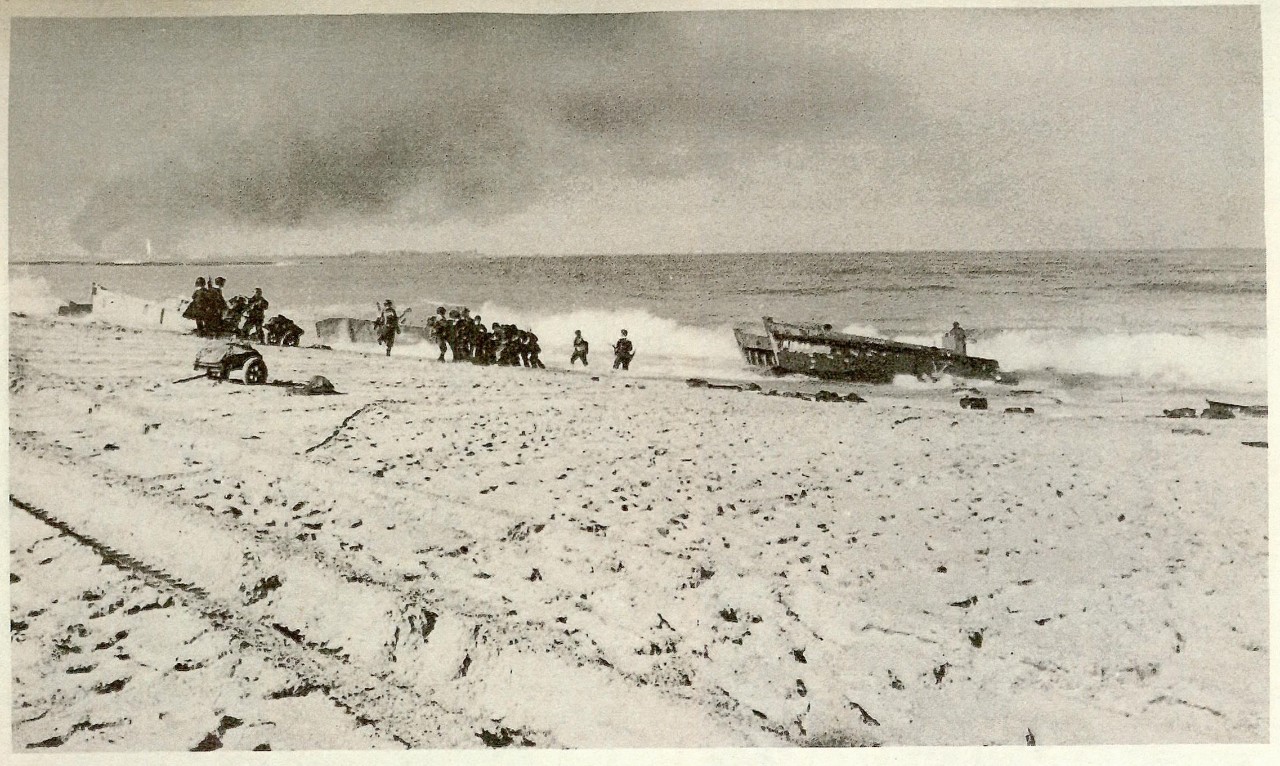
Landing operation at Fedala
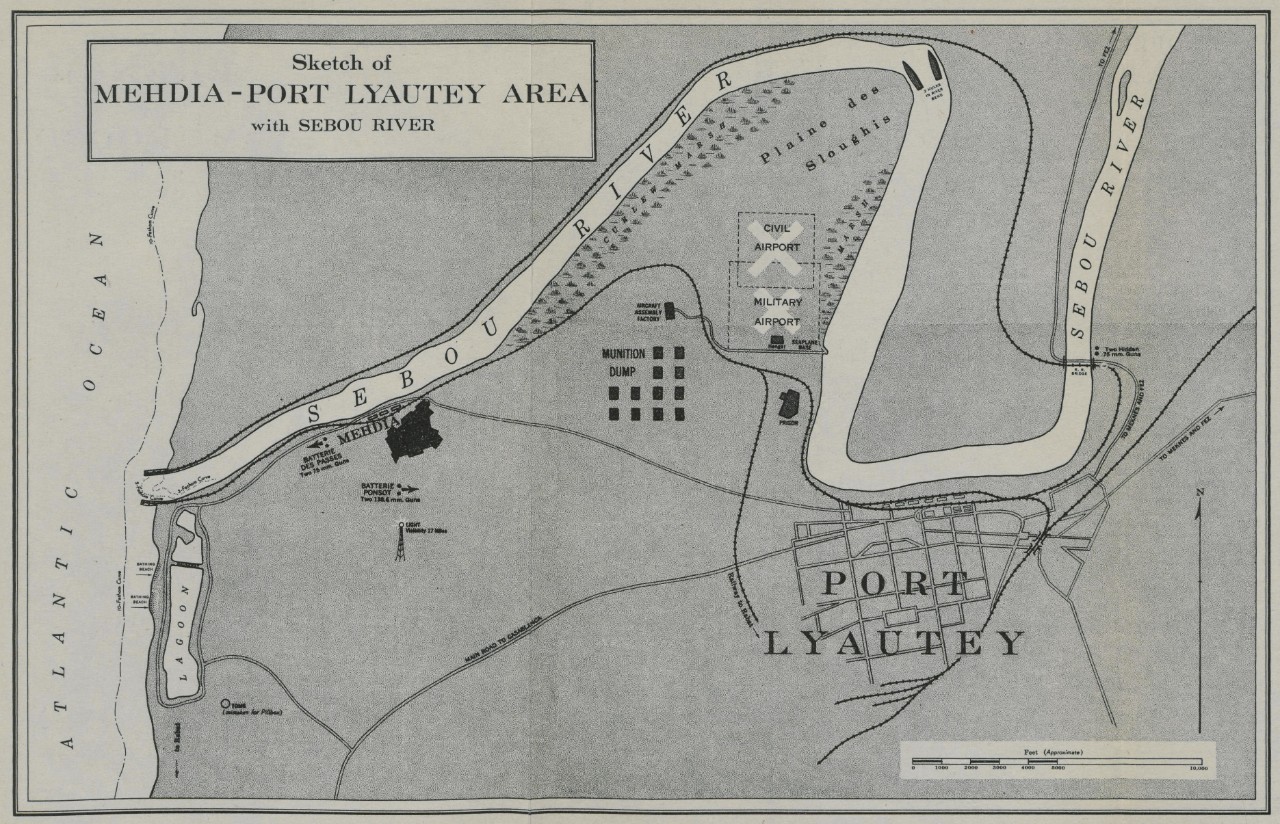
0-44-566293 Faces p. 46
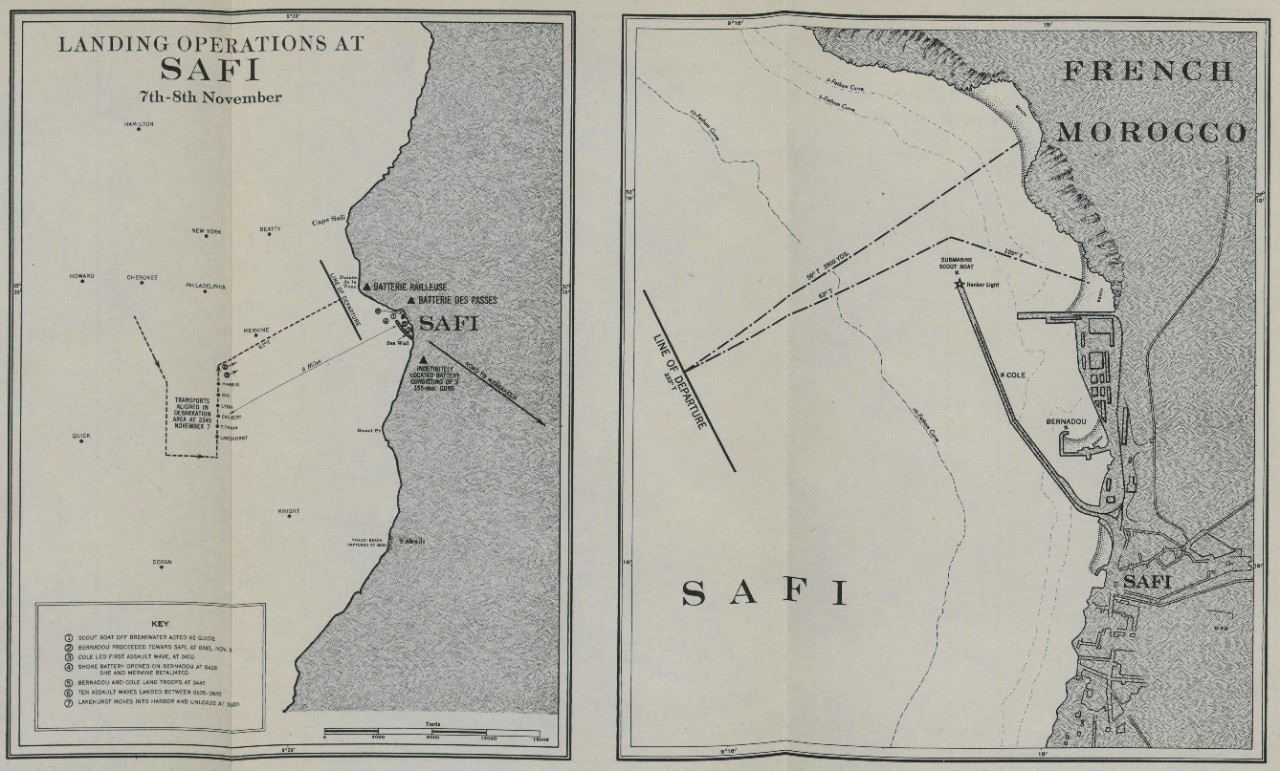
0-44-566293 Faces p. 47
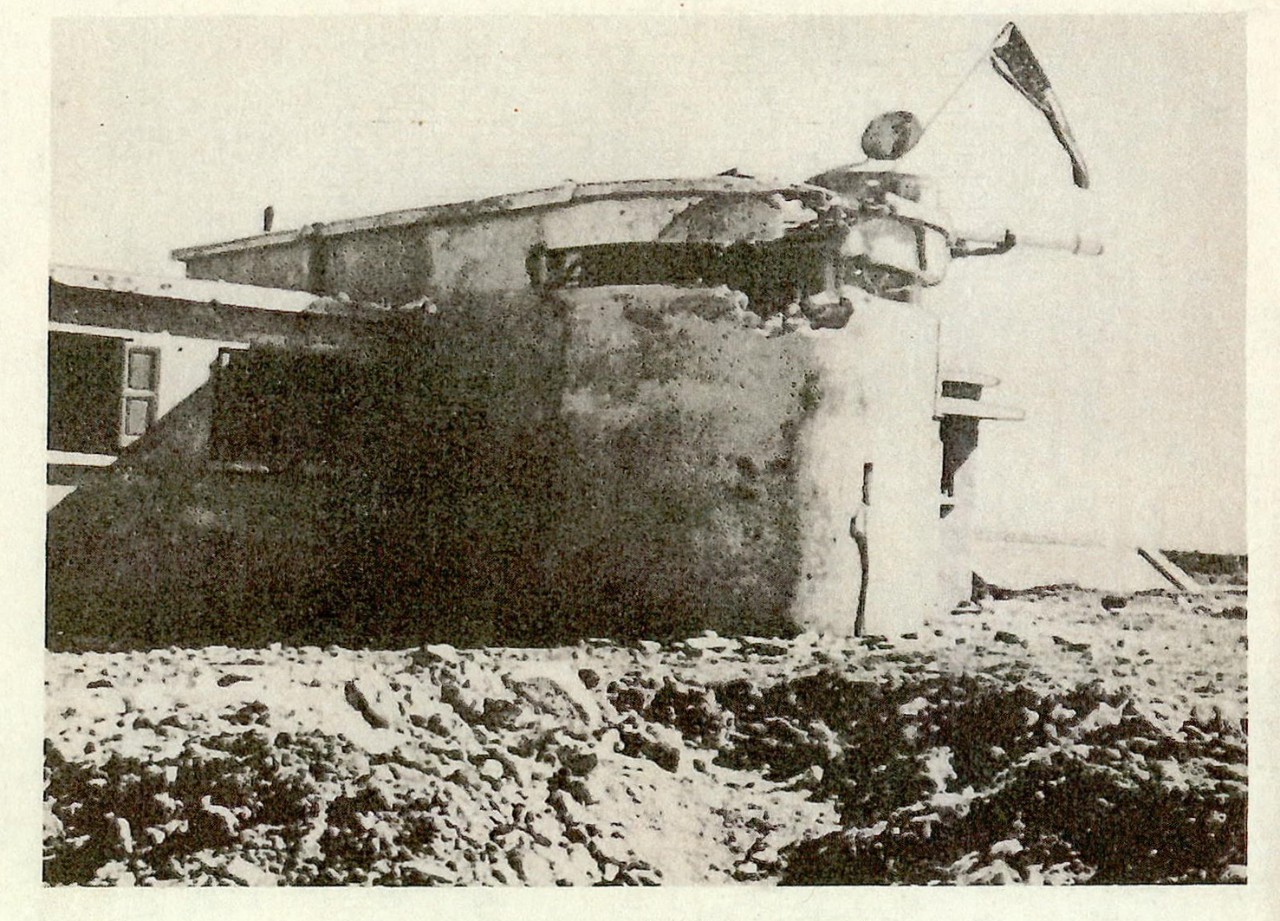
Batterie Railleuse, wreck of fire-control station
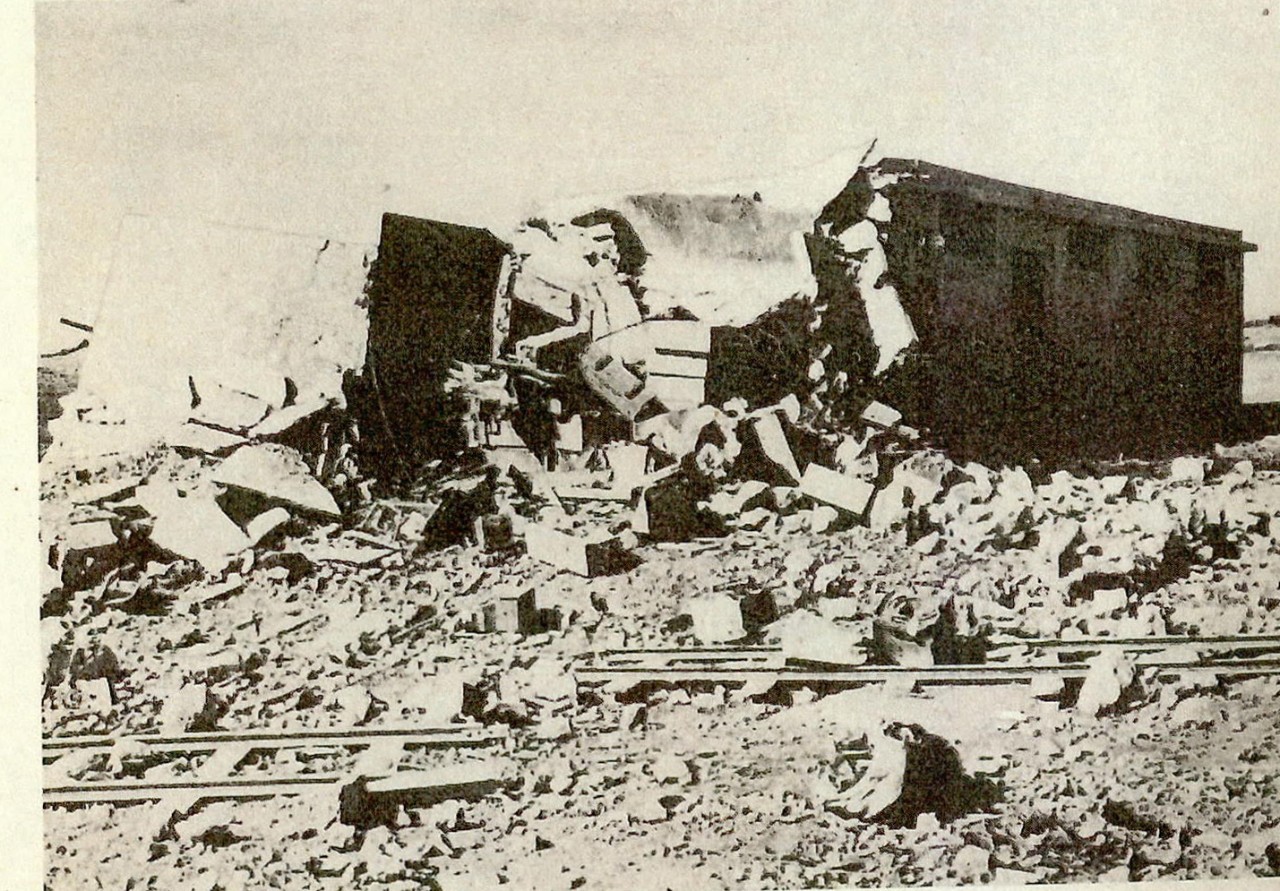
Batterie Railleuse, direct hit on storehouse
7 November
2345 Transport reach debarkation area.
8 November
0345 Bernadou proceeds to Safi breakwater.
0400 Cole leads first assault wave.
0428 Shore battery opens on Bernadou. Mervine retaliates.
0439 Signal to engage is broadcast. New York and Philadelphia open fire on
Batterie Railleuse. Battery temporarily silenced.
0445 Bernadou lands troops. Cole lands naval contingents.
0505-0640 Ten assault waves landed.
0640 Batterie Railleuse resumes fire. Silenced by New York and Philadelphia.
0920 Yahudi beach captured.
1035 Philadelphia opens fire on battery south of Safi. Guns silenced.
1130 Army captures battery south of Safi.
1206 Batterie Railleuse captured.
1500 Lakehurst moved into harbor and unloads tanks. Army occupies Safi.
Transports complete unloading.
9 November
0641 Enemy planes attack Lakehurst.
1500 Planes from Santee bomb troop concentrations and Marrakech airdome.
10 November
0815 Planes from Santee destroy trucks, gun emplacements, and one plane
At Bou Ghedra.
1150 Philadelphia plane bombs Méduse beached at Cape Blanco. Doran dispatched
to capture same.
1743 Landing field at Safi occupied. Army advances on Mazagan.
1930 Philadelphia, Cowie and Knight proceed along coast supporting Army.
11 November
0745 Mazagan, Azzamour surrender.
The harbor of Safi is a miniature of Casablanca: a long sea wall extending in a northeasterly direction, a “Jetée Transversale” projecting at right angles to the coast. At the far end of the body of water thus enclosed, a stone mole completes the similarity. Along the sea wall, cranes and unloading facilities had been installed. These were urgently needed by our forces as the tanks transported on the Lakehurst were too heavy to be unloaded through the surf.
47
In order to secure this equipment a bold stroke was planned. Two destroyers, the Bernadou and the Cole, stripped so as to offer the minimum silhouette possible, were to enter the harbor one-half hour before the beach landings. The Bernadou carried a contingent of specially trained assault troops (companies L and K of the Forty-seventh Infantry) and the Cole carried a contingent of naval personnel. The former were to occupy strategic points in the harbor, the latter to seize the shipping and unloading facilities. The area had been well fortified, as the intelligence reports correctly stated.
Coordinated with the assault on the harbor, landing were to be made on four beaches. These were situated as follows: Yahudi Beach was 8 miles south of Safi, while the other three beaches were situated in the vicinity of Safi, one opposite the end of the sea wall, another about half a mile northeast of that point, and one well within the breakewater. The last name beach was to be occupied after the Bernadou and the Cole had accomplished their mission.
At 2345 on 7 November the transports reached the transport area situated about 8 miles from Safi with the harbor light bearing approximately east-northeast. The Fire Support Group was placed in operating areas estimated to afford the best positions and the greatest freedom of movement for their particular fire support missions. The New York, for instance, was in a good position to deliver an enfilading fire on the Batterie Railleuse from the northwest. The Philadelphia was placed where she could support the New York and range the battery south of Safi as well. The Mervine, Beatty, and Knight were located where they could deliver a close-in fire on the beaches and at the same time be protected by the fire of the larger units.[35]
At daybreak on 8 November weather conditions were: wind northwest, force 2, slight swell.
A delay of a half-hour in the scheduled landings was occasioned by the late arrival of the attack troops and supplies. As at Mehdia the darkness had resulted in some confusion. The landing on Yahudi Beach was consequently postponed until daybreak.
At 0345 on 8 November the Bernadou departed from the transport area, followed at 0400 by the Cole, leading the first assault wave of landing boats. They had been preceded by a scout boat under the command of Ens. John J. Bell, assigned the task of locating the beacon submarine,
__________
48
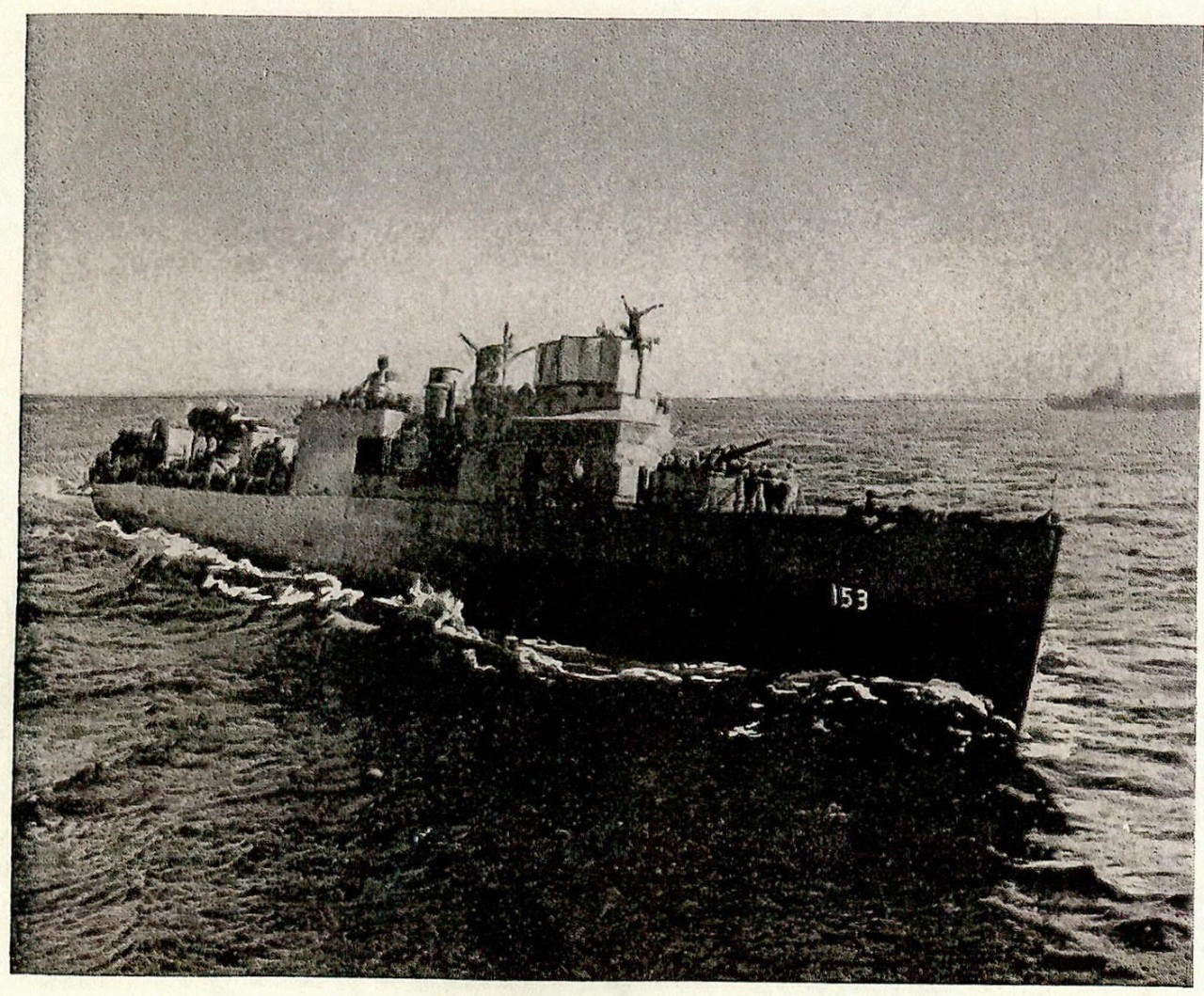
USS Bernadou, APD which led assault on Safi
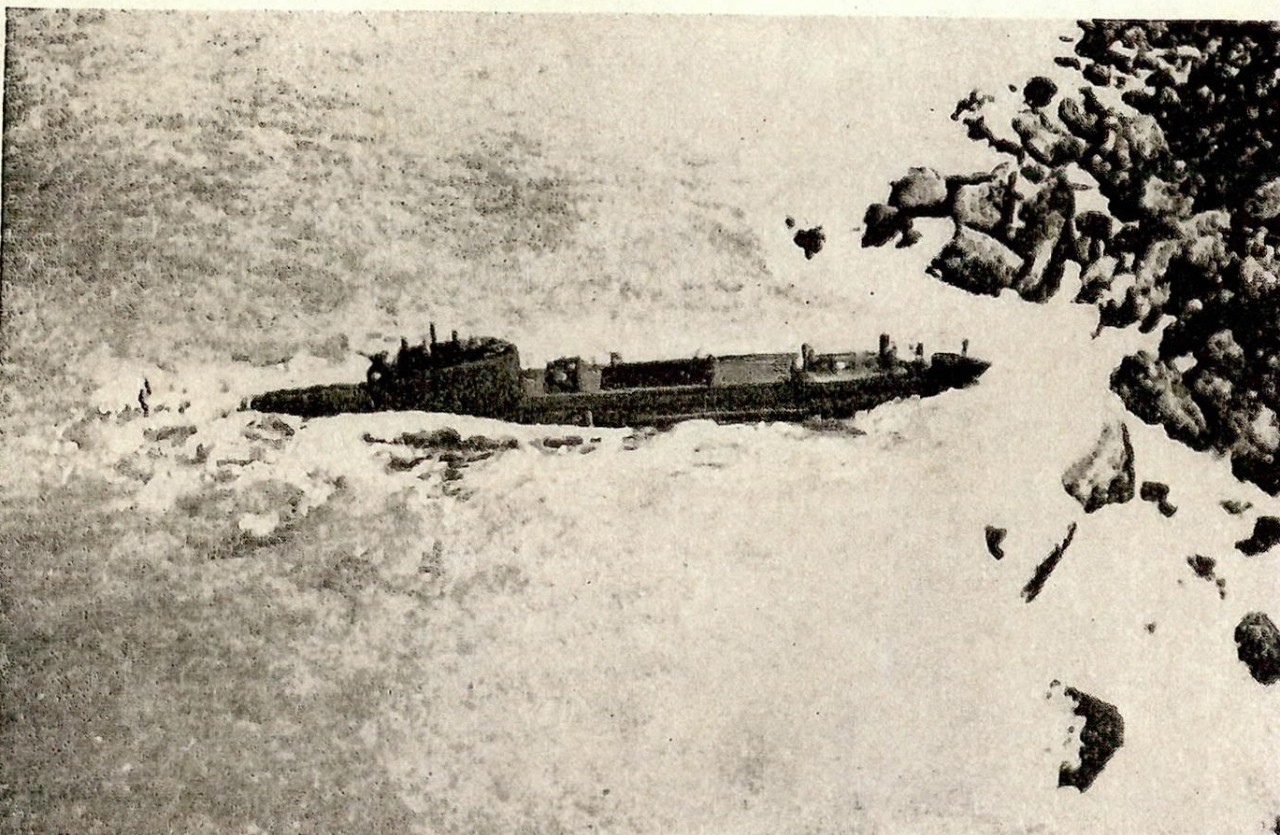
Wreck of the Meduse
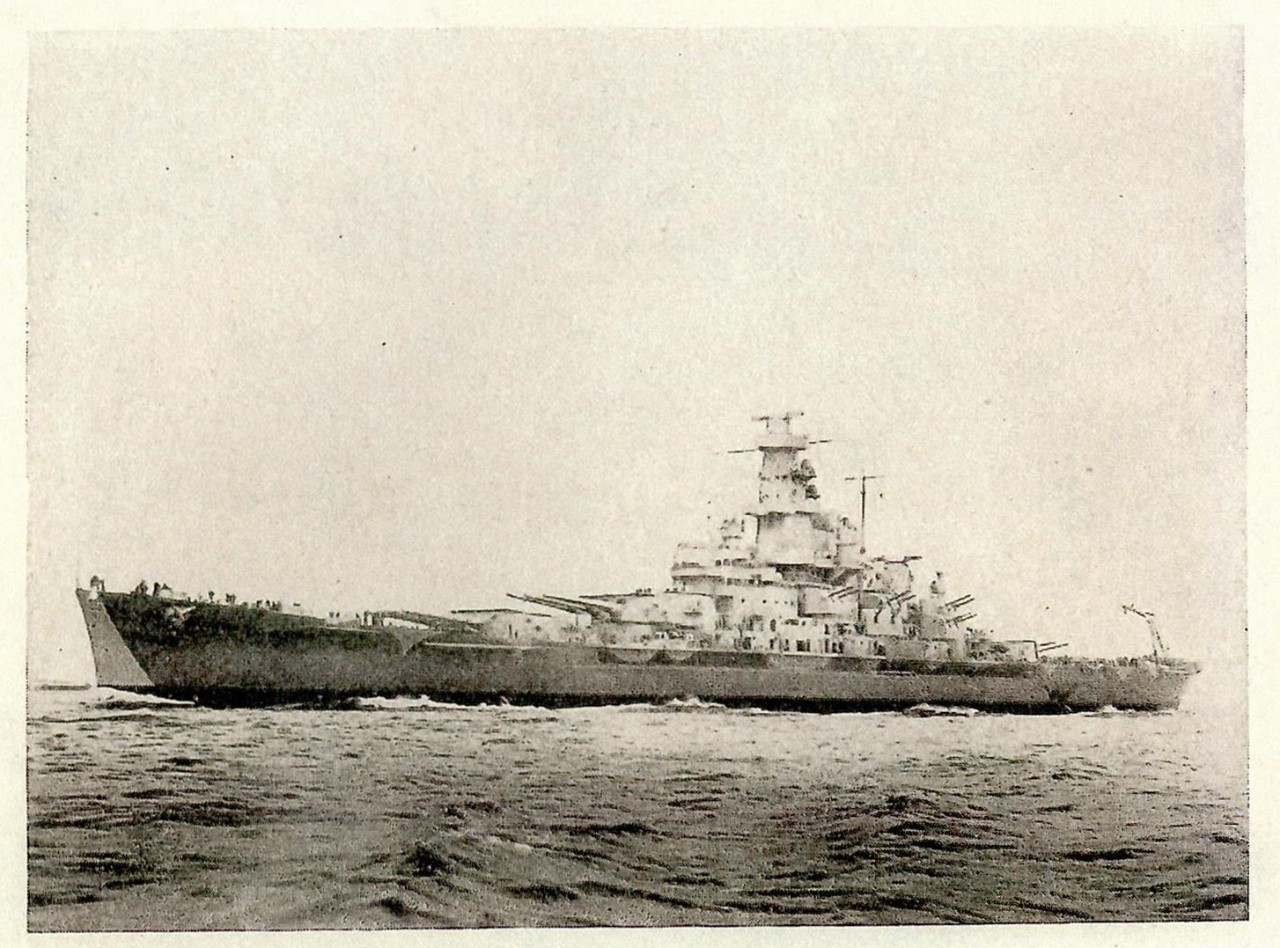
USS Massachusetts
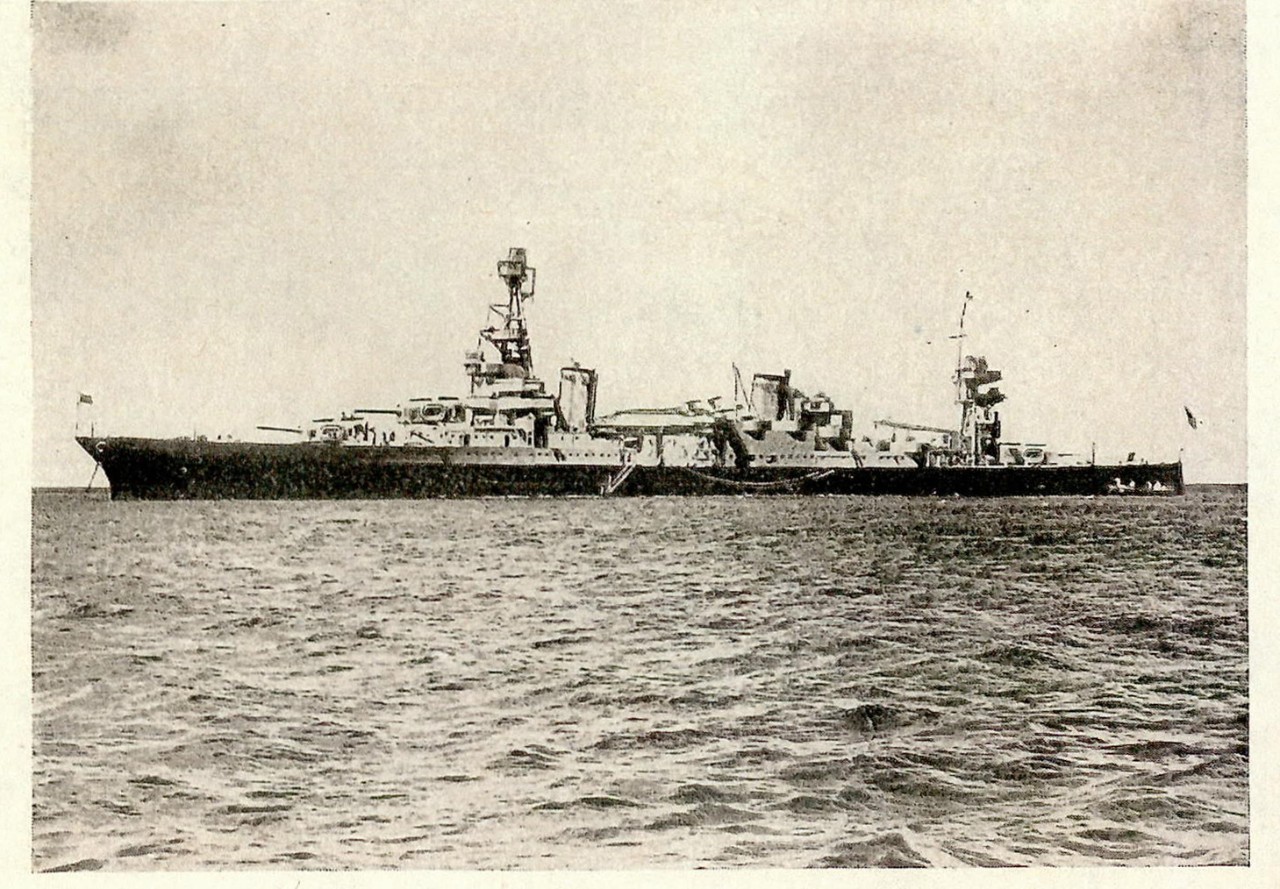
USS Augusta
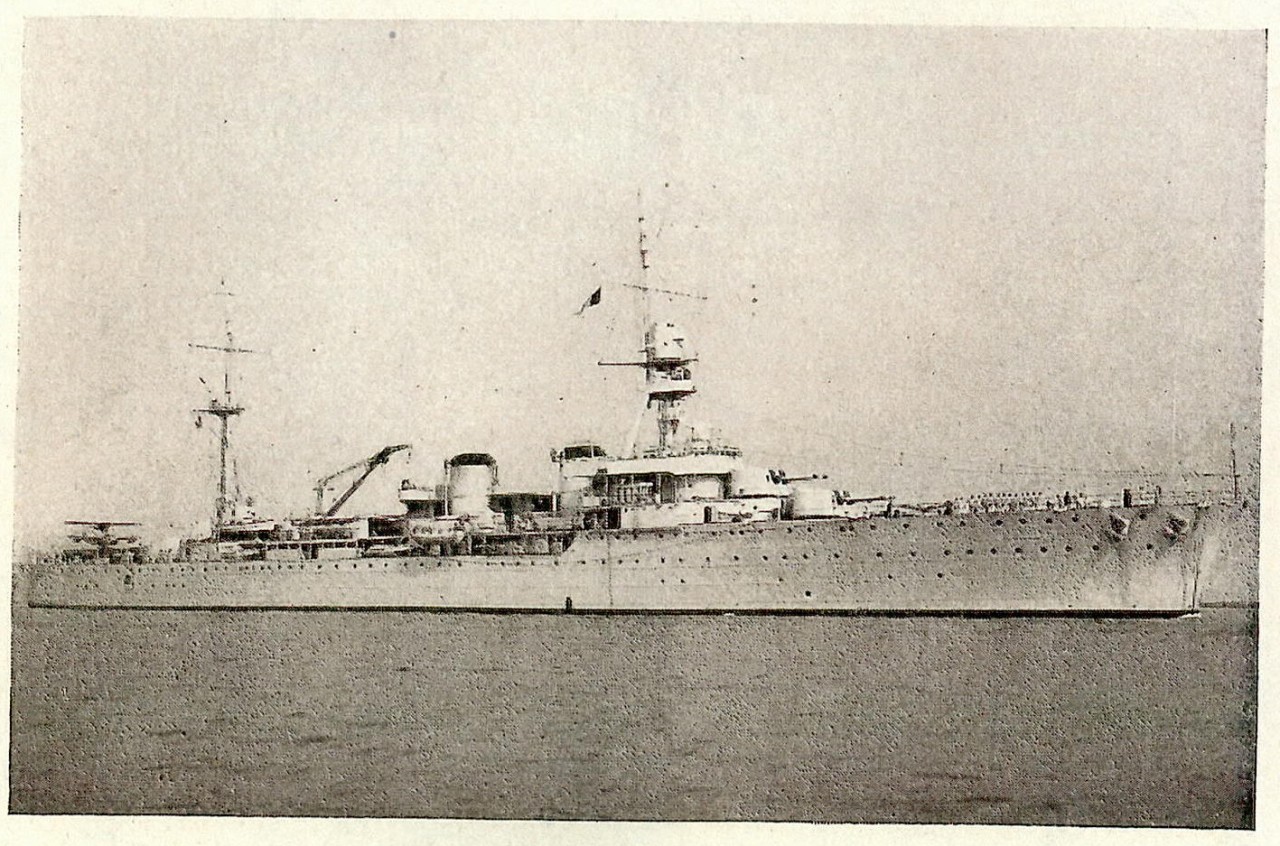
The Primauguet
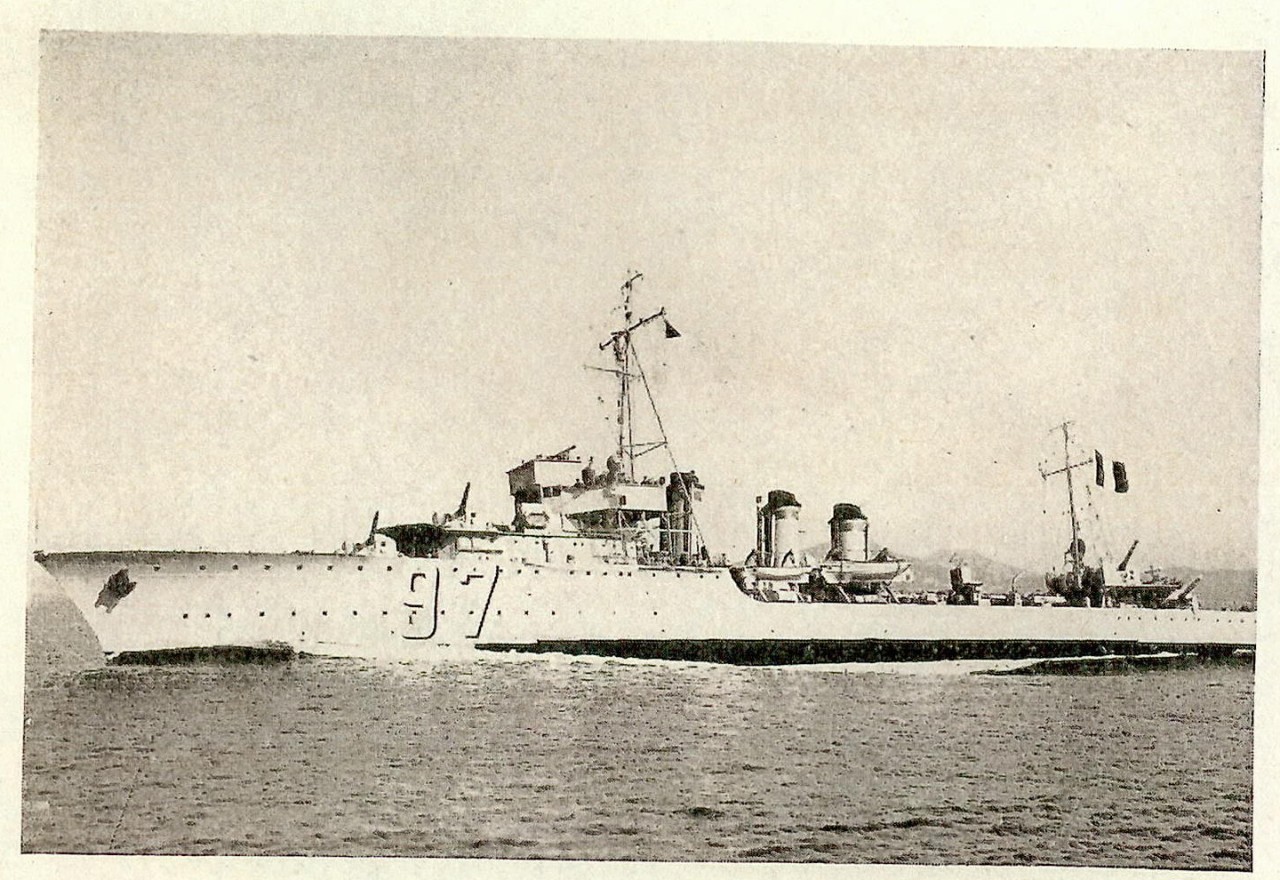
The Brestois
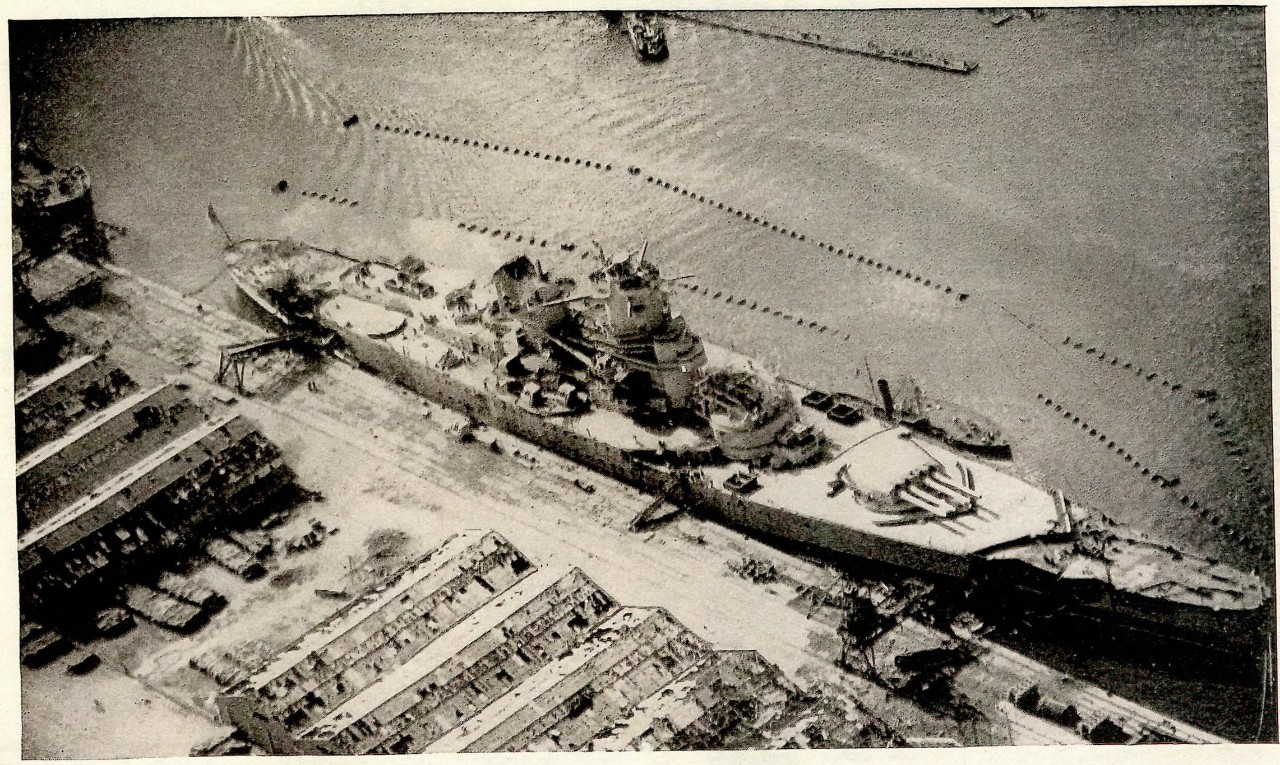
The Jean Bart berthed at the Mole du Commerce
of marking the turning of the Bernadou and the Cole into the harbor, and of directing the troops to their respective beaches.
At 0410, as the Bernadou approached the breakwater, she was challenged by a flashing light. She replied with the same signal and as a result no action was taken on shore until 0428 when the Batterie des Passes opened fire. Two minutes after the French opened fire the Mervine and Bernadou retaliated with several extremely accurate salvos. Within 6 minutes the French guns were silenced and no further opposition from 75’s or machine guns was encountered. The Mervine then directed her fire on the Batterie Railleuse which had just opened on the Bernadou and Cole, which had reached the inner harbor.
At 0439 the signal to engage was broadcast by the group commander to all units of the Southern Attack Group. The New York and Philadelphia at once delivered a smothering fire on the Batterie Railleuse. One shell struck the ground on the crest of the 300-foot cliff just in front of the enemy fire control station (probably around 500) and ricocheted through the observation slot in fire control tower, demolishing the director and killing the fire control officer. This temporarily silenced the battery and undoubtedly saved the Bernadou and Cole from severe damage. The action was fought in complete darkness and only the intermittent flashes of the enemy’s gun could be used as a point of aim.
The Batterie Railleuse did not resume fire until about 0640. Some six or eight shells fell in close proximity to the New York. Those aimed at the Philadelphia were from 1,000 to 2,000 yards short. The Philadelphia closed to within 15,000 to 16,000 yards and open fire with her main battery. Once again the Batterie Railleuse was subjected to the combined fire of the New York and the Philadelphia, which by this time was very accurate because of plane spots. In a few minutes the battery was definitely silenced. Subsequent examination showed that although no direct hits were made on individual guns, numerous hits by 14- and 6-inch shells were made on the fire control tower, turrets and magazines. Photographs taken after the action indicate that the battery had undergone a quick and complete neutralization. The guns were subsequently destroyed by the garrison before surrender.
The French fire had not prevented the landing operations at Safi from being carried out according to plan. At 0445 the Bernadou grounded alongside the mole and landed her troops. (She was refloated at 1400, slightly damaged.) Naval contingents from the Cole landing about the
49
same time captured three small vessels, two of which were tugs, and the harbor cranes. The Cole had experienced difficulty in finding her way in the darkness but was set right by Ens. Bell in the scout boat. These two landings had been effected without casualties, which was remarkable in view of the fire power the enemy had brought to bear on Safi Harbor. Except for occasional plane strafings, the landings on the Safi beaches were unopposed. By 0700 a combat patrol from the Santee arrived on the scene and dispersed the few enemy planes in the neighborhood.
Had the French possessed means of illuminating our ships and boats, the casualties undoubtedly would have been heavy. In the darkness, however, they failed to detect the approach of the landing parties or to gauge the nature and strength of the attack. In all, 10 waves were landed between 0505 and 0640.[36] On 8 November, in the region of Safi, the morning twilight began at 0536 and sunrise was at 0700. These landings were made, therefore, before sunrise and some actually before morning twilight. The troops intended for Yahudi Beach were not landed until 0920. There some slight resistance was encountered.
At 1000 the Army captured the radio station of Safi in which operation they were assisted by accurate gunfire from the Cole. Records captured there showed that the garrison had received a danger signal from Casablanca at 0230 and a final alert at 0327.
During the daylight landing, several splashed of medium caliber shells were observed in the vicinity of the beach opposite the harbor entrance. The source of this fire proved to be the battery of 155-mm. guns 2 miles south of Safi. At 1025 the commander of the Southern Attack Group directed the Fire Support to neutralize this battery. The Philadelphia quickly maneuvered into an effective firing position and at 1035 commenced firing with her main batteries, assisted by plane spots. After her first salvo a plane was ordered to locate the target positively by flying at a low altitude. This was accomplished despite the fact that the battery was cleverly camouflaged. The Philadelphia’s second salvo was a straddle and subsequent salvos were on the target.
At 1130 the battery south of Safi had been taken, while the Batterie Railleuse fell at 1206. All batteries having been reduced, the Lakehurst moved into the harbor and by 1500 was unloading the heavy tanks. The Titania followed at 1530. The remainder of the transports moved closer
__________
36 The debarkation procedure, being essentially the same as the employment in the Media landings, will not be described again.
50
to the port. The discharge of cargoes was facilitated by the establishment of a double antisubmarine screen and an antisubmarine patrol maintained by planes from the Santee, which had taken station 40 to 60 miles offshore, assisted by planes from the New York and the Philadelphia. Four of the aircraft from this group made forced landings at Mazagan. The pilots were taken prisoner but released on 11 November when the Army captured that town.
At 1330 the captain of the Santee reported that the breezes were too light for carrier operations. An evening reconnaissance of roads and railroads toward Mogador and Marrakech to a depth of 25 miles was therefore executed by seaplanes from the Philadelphia. They located 25 aircraft on the Marrakech field.
At 1530 disposition for the night was taken. The Philadelphia, New York, Quick, Howard, and Hamilton served as covering unit; the Mervine, Knight, Beatty, Doran, Bernadou, Cole and Cherokee constituted the screen, while the Santee, Monadnock, Merrimack, Rodman, and Emmons, maintained continuous air reconnaissance. At the end of D-day General Harmon was able to report that the town of Safi had been secured.
The night passed without incident. The speed of unloading was, however, much reduced without incident. The speed of unloading was, however, much reduced because of darkness and the impossibility of landing supplies through the surf on the shelving beaches during low water.
At daylight on the 9th a warning was received from Army headquarters advising of a possible raid by 40 planes. All aircraft of the antisubmarine patrol were promptly launched for reconnaissance. Shortly thereafter a thick fog settled. One enemy plane made an attack through the overcast on the Lakehurst, alongside the merchant pier. One bomb struck the pier, killing 5 men and wounding 10, besides destroying a light antiaircraft gun and 2 vehicles. The plane, a twin-engined bomber,[37] was shot down by antiaircraft gunfire from the transport. No attack in force was made.
About the same time a report was received from the antisubmarine patrol that a submarine, probably the Méduse, had been bombed off Cape Kantin.
The fog lifted at about 0800. Shortly thereafter a report was received
__________
37 The twin-engined French bombers mentioned in the reports were either Glen Martins or L.E.O. planes. The exact type is seldom given.
51
that a reconnaissance plane of the Santee had dropped two bombs on the Marrakech airfield after having been attacked by antiaircraft fire. This resistance, however, was not considered sufficient to warrant offensive action on our part. A flight of 11 bombers and 2 fights from the Santee, which had taken off at noon, was recalled. Shortly thereafter, however, another report was received to the effect that 4 two-motored bombers on the Marrakech airfield were turned over their engines. At 1500 another flight of bombers and fighter was therefore launched by the Santee.
The decision to permit the bombing and destruction of the grounded aircraft was reached as a result of the attacks by them on the previous day and by the further consideration that, as our forces advanced to the northward to assist in the attack on Casablanca, it would be folly to leave these enemy planes in the rear.
The expected counterattack by the garrison of Marrakech was heralded by the appearance of a relief column of 14 trucks east of Bou Ghedra.[38] At 1300 Army headquarters requested the destruction of this column by Santee planes. Three were accordingly detached from the combat patrol bound for Marrakech. Fourteen trucks were found and attacked, 12 being set on fire. Shortly thereafter other trucks loaded with troops were reported still farther east. About 40 vehicles were attacked and damaged by the combat patrol en route to and returning from Marrakech. At the Marrakech airfield 20 planes were destroyed or damaged and 1 hangar wrecked. All the Santee planes returned safely.
At 1450 the New York was dispatched to Fedala to assist in the operations at the point. The Howard and the Hamilton were sent with her as antisubmarine screen. At 2300 the Cherokee was likewise detached with orders to report to the Task Force Commander at Fedala.
Activity of all kinds diminished somewhat during 10 November. The Merrimack arrived at daylight and commenced fueling destroyers. Meanwhile the Philadelphia fueled from the Santee about 60 miles offshore. The operation was interrupted by a submarine attack. Two torpedoes, fired at long range, passed between the Philadelphia and her escort, the Doran.
At 0803 a plane from the Santee reported shooting down an enemy two-engined bomber over Bou Ghedra and at 0815 Santee planes destroyed three enemy trucks, strafed gun emplacements and shot down another bomber near Bou Ghedra.
__________
38 Fifteen miles east of Safi on the Marrakech road.
52
At 1150 a plane from the Philadelphia reported having bombed a beached submarine at Cape Blanco. The Doran was sent to investigate.
By 1743 the landing field at Safi was ready and reported having captured the submarine. She proved to be the Méduse.
While these operations afloat were proceeding, the Army was advancing towards Mazagan and requested support from the naval units. At 1930 the Philadelphia, escorted by the Cowie and Knight, proceeded northward, and at 2330 the Cole, escorting six landing craft, sailed from Safi for Mazagan.
The disposition for the night was as follows: the Philadelphia, Cowie, and Knight were to proceed northward along the coast and provide deep fire support up to 10 miles inland. The naval units were to transport the fuel and supplies necessary for the Army tank column and were to be ready to furnish air support if needed. The naval units remaining at Safi were to maintain the regular air and submarine patrols.
Early in the morning of 11 November the Bernadou proceeded to Mazagan with troops and supplies. At 0300 a dispatch was received for General Harmon directing him to be in a position to attack Casablanca by noon of the 11th. This message was duly relayed. At 0605 a further dispatch was received: “Casablanca may capitulate within the next few hours.” At 0710 a dispatch was received from the commander of the Task Force, “Cease firing.” This order was meant to apply only to the forces at Casablanca. The Southern Attack Group was directed to carry out the operational plan.
At 0850, however, a message was received from the Army: “Stop bombing over Mazagan. No fight if no bombs.” This was evidently the result of the appearance over Mazagan of reconnaissance planes from the Philadelphia and the Santee. At 0950 a report was received from General Harmon that Mazaan,[39] Azzamour and the bridges over the
__________
39 “Your airplanes arrived at the psychological moment and caused hasty precipitation of enemy resistance which was threatening to become ugly. They gave up immediately. The credit for the surrender of Mazagan should be given to the Santee and her squadrons.” (From the reports of the air liaison officer at Mazagan.)
The operations of the Air Group, being necessarily scattered over the entire theatre, have not been covered in detail in this narrative. The Ranger alone made 420 launchings on 61 separate missions and her planes dropped 48 tons of high explosives besides firing 20,900 rounds of machine-gun ammunition. Nine 1,000-lb. and 500-lb. bombs were dropped at the Jean Bart and seven 1,000-lb., fourteen 500-lb., and twenty 100-lb. bombs were dropped at the El Hank batteries. In aerial combat the Ranger shot down 16 enemy planes and destroyed 71 grounded ones. Twenty-one tanks and 86 military vehicles were immobilized or set on fire. These results were accomplished with the loss of only 1 killed and 10 missing. On the morning of the 12th, however, the Ranger had a narrow escape from 5 torpedoes launched by a wolf pack of submarines. The Santee launched 143 flights, which dropped 96 bombs and fired 5.308 rounds of ammunition. Two French aircraft were shot down, 48 damage on the ground and over 40 trucks damaged or destroyed.
As an indication of the spirit animating our airmen the following incident is stirring. As H-hour approached one rear seat gunner was offered $230 for his place in the first flight. He declined the offer. When the plane landed on board the carrier he was found dead in the cockpit.
53
Oued Rebia had surrendered at 0745. Finally, at 2348, a dispatch previously mentioned was received: “Hostilities in French Morocco have ceased. Be especially vigilant against Axis submarines,” In this connection it should be noted that our forces did their utmost to avoid coming into conflict with the French and withheld their fire until fired upon. The action of the Safi garrison, however, precipitated a struggle that promptly spread to other areas.
To summarize, it may be said that the operations at Safi were successful beyond reasonable expectation. Extreme accuracy of gunfire was obtained even during darkness. As a result Safi was captured with trifling losses. The performance of the New York in silencing the fire of the heavy battery at Safi with the deliberate fire of one turret gave marked satisfaction. Mention should also be made of the Mervine which countered the fire of a French 75-mm. battery with several extremely accurate salvos, Within 6 minutes all enemy fire was silenced and no further opposition from this battery or the machine guns at the mouth of the harbor was encountered.
Last, but not least, the prompt landing of the tanks from the Lakehurt had a decided effect on the entire campaign. The French had nothing oppose them. When they appeared before Casablanca, having bypassed Mazagan and hurried northward, the French garrison was in a serious plight. Its surrender was a foregone at the time the armistice intervened to prevent further fighting.
Owning to the fact that the harbor of Safi was made available for disembarkation without delay, the losses in small boats in the Southern Attack were slight-only 9 out of 121 used, of which 8 were subsequently salvaged.
54
THE ATTACK ON FEDALA (CENTER ATTACK)
The attack on Fedala was the principal one of the expedition, having for its object a landing in force at that point, to be followed by a rapid advance on Casablanca and an ultimate junction with forces converging from the north (Mehdia) and from the south (Safi). The debarkation of the Center Attack Group, which was larger than the other two combined, was indirectly protected by the Covering Group which engaged the French fleet and batteries in and around Casablanca while the land forces were being put ashore. The effect on the batteries themselves proved slight but the bombardment prevented the French garrison at Casablanca from effectively opposing the landings, while the destruction of the French fleet prevented its interfering with the debarkations. Direct protection to the landings was furnished by the fire support vessels in accordance with the basic plan.
The United States force engaged was the Center Attack Group (Task Group HOW-9), Captain Emmet, consisting of the following units:
FIRE SUPPORT: Augusta (FF),[40] Brooklyn, Rowan, Wilkes, Swanson, Ludlow.
TRANSPORTS: Leonard Wood (D), Ancon, Arcturus, William P. Biddle, Tasker H. Bliss, Charles Carroll, Joseph T. Dickman, Joseph Hewes, Thomas Jefferson, Oberon, Procyon, Edward Rutledge, Hugh L. Scott, Elizabeth C. Stanton, Thurston. A/S screen and minesweepsers: Woolsey, Edison, Bristol, Boyle, Murphy, Tillman, Maintonomah, Hogan, Palmer, Stansbury, Auk.
The oiler Winooski, with two specially constructed fire support craft on board, was attached to the Center Attack Group.
The Army contingent (Task Group YOKE) forming part of the Center Attack Group was under the command of Maj. Gen. Jonathan W. Anderson and consisted of the following units:
Third Division (Seventh, Fifteenth, Thirtieth Infantry Regiments reinforced).
Third (armored) Reconnaissance Battalion.
First Battalion, Sixty-Seventh Armored Regiment.
Total: 1,067 officers, 18,716 enlisted men, 77 light tanks.
7 November
2115 El Hank light sighted.
2353 Transports reach transport area.
8 November
0525-0540 Four assault waves landed.
0604 Shore batteries open fire on patrol vessel and beaches.
____________
40 The Augusta, besides being one of the fire support vessels, was Admiral Hewitt’s flagship.
55
0610 Wilkes, Swanson, Murphy, and Ludlow return fire.
0620 Order for general offensive received.
1430 Fedala surrenders.
9 November
0800 French airplanes bomb beaches.
1105 Channel swept to Fedala.
10 November
1700 Debarkation of troops and vehicles completed.
11 November
1953-1954 Joseph Hewes and Winooski torpedoed.
2045 Joseph Hewes sinks.
2118 Hambleton torpedoed.
12 November
1730 Hugh L. Scott, Edward Rutledge torpedoed. Both sink.
1737 Tasker H. Bliss torpedoed.
13 November
0230 Tasker H. Bliss sinks
After parting company with the Covering Group, the Center Attack Group proceeded toward its transport area which was situated about 8 miles northeast of Cape Fedala.
At 2100 on 7 November the radar search for the coastline of Fedal was begun by the Augusta. An initial contact was made at 2137. Meanwhile, at 2115, a flashing light, bearing 205ᵒ T., was sighted. This was identified as El Hank light at Casablanca, distance about 36 miles. Speed was reduced to about 9 knots. At 2255 Cape Fedala was identified by radar and a plot of the coast begun. At 2301 speed was reduced to 6 knots. At 2353 the formation reached the transport area and stopped. The formation had struggled badly and units of the screen were accordingly dispatched to round up the stragglers.
The Boyle had meanwhile been detached to establish contact with the beacon submarine, but failed to do so. In fact, the submarine was not sighted or heard from by radio until after daybreak, when at about 0630 (8 November) she was seen to surface at a distance of about 3,000 yards from the Leonard Wood.
The transport area selected faced a series of six beaches,[41] extending
__________
41 See charts opposite pp. 19, 24, and 25.
56
from Fedala to the village of Mansuria, a distance of approximately 6 miles. The first beach was immediately to the southwest of Cape Fedala. Then came a series of four beaches extending from a point immediately southeast of Fedala to the Neffifikh River. The sixth was north of Mansuria.
At 0012 the Leonard Wood rounded into the transport area, followed by the other transports, and commenced loading boats. At 0145 special beach marking boats from the Leonard Wood, Charles Carroll and Joseph T. Dickson left their rendezvous off the bow of the Leonard Wood and proceeded to designated points to mark beaches.
The special beach marking boat from the Thomas Jefferson was delayed by an act of sabotage and proceeded independently at about 0200. Her commanding officer reported that the lashings on one of the debarkation nets had been partially cut. When debarkation commenced the net gave away, dropping several men. All nets were inspected before resuming debarkation.
The debarkation of the landing force was to prove extremely difficult. Considerable confusion was caused by the darkness, which hampered the boats from the combatant ships and those from the transports in effecting their rendezvous. The boat from the Procyon arrived at the rendezvous 1 hour late. H-hour had to be delayed from 0400 to 0445. In spite of this additional time, many of the waves left without their allotted quota of oats. The postponement of H-hour, however, had not been communicated to the beach markings parties, and as a result they began displaying visable light signals seaward about that time.
By 0500 the control vessels Wilkes, Swanson, Ludlow, and Murphy were on their designated lines of departure. The first four boat waves were dispatched to their designated beaches between 0525 and 0540. The waves from the Leonard Wood were directed towards the beach southwest of Cape Fedala. The waves from the Thomas Jefferson, the Charles Carrol, and the Joseph T. Dickson were directed to the beaches between Fedala and the Neffifkh River. A special wave from the Hugh L. Scott intended for the beach at Mansuria failed to appear in time to be used. That landing was accordingly eliminated.
At about 0525, as the first waves were approaching the beaches, the searchlight at Chergui were turned on the boats making for the central beaches. The support vessels opened fire on the lights. It was not until 0604 that the shore batteries at Chergui and Fedala opened fire on the
57
control vessels and the beaches. At 0610 this fire was returned, the Wilkes and the Swanson firing on Fedala, and the Murphy and Ludlow on Chergui.[42]
At 0630 the signal to commence a general offensive was received. The Brooklyn thereupon opened fire on Chergui at 0625. At about this time the Murphy was hit by a shell from Chergui which started a fire in her engine room. The fire was soon brought under control, but the ship was left without power to train her guns. She thereupon moved out and took her place in the screen.
At about 0700 the special fire support boat reported alongside the Leonard Wood from the Winooski and was dispatched close inshore to cover landing operations.
By 0948 the Task Group Commander was able to report to the Force Commander that the French resistance was slight and that the Leonard Wood was moving inshore to a position 10,000 yards from Cape Fedala, with other transports following in formation, that the Brooklyn was standing by to cover this movement in case the batteries resumed fire, that shore troops had landed, and that heavier equipment was now going ashore. No report had been received, however, from the commanding general as to the Army’s penetration. In the debarkation area, French action had subsided into occasional strafing of the beached and sporadic fire by the Fedala batteries.
About this time the Army made an attempt to get into communication with the French authorities with a view to cessation of hostilities. The French commander, however, refused to receive the American emissary. After the destruction of the fleet the resistance of the French Army, fortunately, was limited to a delaying action, a continuous retreat to avoid encirclement. At 1430 Fedala surrendered.[43] Nevertheless at 1516 the French air forces again strafed the beaches.
The naval engagement off Casablanca has already been described. Some incidents that occurred off Fedala should, however, be mentioned.
__________
42 The surrender of Fedala was attended by one amusing incident – the capture of the German Armistice Commission. The first news these officers had of the American invasion was when they looked out their windows and found their hotel surrounded by our troops. After making a mad dash for their plane parked on a neighboring golf course and going through the motions of resistance, they were rounded up and taken prisoner.
43 The surrender of Fedala was attended by one amusing incident – the capture of the German Armistice Commission. The first news these officers had of the American invasion was when they looked out their windows and found their hotel surrounded by our troops. After making a mad dash for their plane parked on a neighboring golf course and going through the motions of resistance, they were rounded up and taken prisoner.
58
At 0832 our minecraft Auk arrived in the transport area with the captured French corvette Victoria. This enemy vessel had been patrolling during the night of the 7th-8th when she encountered the Hogan and opened fire. In the ensuing engagement the Victoria was captured. The French naval officer in command had been killed. His body was subsequently brought ashore with all due company.
Another engagement occurred at 1241 between the Auk and the Tillman and a small French coastal convoy of six ships escorted by the corvette Estafette.[44] The Auk, together with the Miantanomah, was engaged in laying a protective mine screen around the transports. The convoy commander refused to stop or comply with the Auk’s orders. The Auk thereupon engaged the Estafette, which was soon beached in a damaged condition. Three of the ships comprising the convoy were also beached but three others, the Simon Duhamel, the Foudroyant, and the Loup de Mer, were taken in charge by prize crew.
Although little damage had been done to our vessel, the condition of the landing craft was disquieting. Of 378 boats and landing craft available before the first raid only 136 were serviceable after the landing operations. In other words 64 percent had been lost in the operation. Some had been sunk, others wrecked or caught by the falling tide. One hundred and sixty-two of them were strewn along the beaches. Unloading, under these conditions, was difficult. Nevertheless at 1700 on 8 November unloading operations had progressed as follows: troops, 39 percent, vehicles, 16 percent; supplies, 1.1 percent.
The night of 8-9 November passed without incident. Unloading continued throughout the night on the beaches. At daylight the minesweepers began sweeping a channel into the port of Fedala. This was completed at 1105. No mines were discovered. At 0800 enemy bombers appeared and dropped about 60 bombs on the beaches with little damage.
At 0900 surf conditions had become such that 11 boats were directed into Fedala harbor for unloading. At 1700 unloading had progressed as follows: troops, 55 percent; vehicles, 40 percent; supplies, 3.3 percent. The night of 9-10 November passed without incident except that the Leonard Wood reported the swell was such that she had rolled 13ᵒ to port and 11 ½ ᵒ to starboard.
The day of 10 November, as far as the naval units off of Fedala were
__________
44 This convoy had passed between the transports of the northern attack and the coast, all lights ablaze, at 0325 in spite of the efforts of the Parker to divert them.
59
concerned, was devoted to routine work. At 1700 unloading had progressed as follows: troops, 87 percent; vehicles, 84 percent; supplies, 14 percent. During the evening a message was received from the Army requesting that certain units (a signal company, two batteries of field artillery, and some armored, signal, and medical equiptment) be landed as soon as possible. These units were needed to withstand a French attack which was expected at dawn. The units in question were on board the Thurston, Elizabeth C. Stanton, and William P. Biddle. The beachmaster concentrated all available boats and lights and compiled with the request of the Army before dawn. The night of 10-11 November passed without other incident. The attack never developed.
The capitulation of Casablanca on 11 November did not, however, put an end to hostilities in this area. It ushered in a series of torpedo attacks on the American vessels off Fedala. In spite of the fact that 11 escort vessels were constantly on guard, 6 transports and 1 destroyer were torpedoed. Whether these attacks were the work of German submarines coming into the area from the north cannot be determined. It is also uncertain whether any of the French submarines which had sortied from Casablanca on 8 November participated. The attacks were, however, persistent and costly, as far as tonnage loss was concerned. Fortunately all the Army personnel and most of the cargo had been disembarked by the time they all took place.
At 1953 the Joseph Hewes was struck, followed at 1954 by the Winooski and at 2118 by the destroyer Hambleton. All three vessels were hit by one torpedo each fire from the west. The Joseph Hewes sank at about 2045, while the Winooski and the Hambleton remained afloat. On 12 November torpedo attacks on the American transports were renewed, in spite of the fact that greater coverage against submarines had been provided by additional aircraft and destroyer patrols. At about 1730 the Hugh L. Scott was struck by two torpedoes, fired from the east about 10 seconds apart. She was abandoned and sank during the night. Within a minute of this attack the Edward Rutledge was likewise hit by two torpedoes from the east. She was abandoned and sank about 1848. At 1737 the Tasker H. Bliss was hit by two torpedoes from the east. The vessel caught fire and burned until 0230 of the 13th, when she sank. Two days later, on the 15th, a message was intercepted stating that the Electra had been torpedoed 16 miles north of Fedala. She remained afloat and subsequently made port. Mention should also be made of the fact that
60
the British hospital ship City of Newfoundland struck a mine[45] off Casablanca on the night of the 16th. The Cherokee and two other tugs went to her assistance, but she made port under her own power.
Had a tug been available, it is quite possible that some of the torpedoed transports might have been beached. The commanding officer of the Edward Rutledge, realizing that his vessel was exposed to a torpedo attack, had planned to slip his anchor if it was evident that the ship could not be saved. Unfortunately, the first torpedo hit between the engine room and the fireroom, resulting in immediate loss of all power. The commanding officer thereupon slipped his anchor in hope that the wind and the tide would set the sip ashore. She sank before this had time to occur-remaining afloat for only 1 hour and 18 minutes.
The torpedoing in question emphasized the necessity of completing the occupation of Casablanca Harbor, as the uncontrolled use of searchlights by the French had undoubtedly assisted the enemy submarines. With the definite occupation of Casablanca, however, the situation was brought under control and the gradual dispatching of the empty transports were successively gathered under the command of Capt. Emmet and sent to Hampton Roads where the Transport Group (Task Group HOW 9) was dissolved on 30 November 1942. On 19 November 1942, a naval operating base was established at Casablanca and Task Forced HOW incorporated into the Sea Frontier Forces
THE ALGERIAN EXPEDITION
The strategic purpose of the Algerian expedition is summed up in the opening paragraph of the objectives promulgated by the Combined Chiefs of Staff: “The establishment of firm and mutually supported lodgments in the Oran-Algiers-Tunis area.” The question of how far east to effect a landing was the subject of considerable debate. The decision finally reached was to occupy Oran, Arzeu, and Algiers and to advance into Tunisia overland from these lodgments. The proximity of land-based Axis aircraft in Sicily and Italy was responsible for the more conservative course adopted. Speaking after the event, Admiral Cunningham undoubtedly voiced the sentiments of many officers when he said: “It is a matter of lasting regret to me that the bolder conception for initial assault
__________
45 Apparently an American one.
61
in that area was not implemented. Had we been prepared to throw even a small force into eastward ports, the Axis would have been forestalled in their first token occupation and success would have been complete. They were surprised and off their balance. We failed to give the final push which tipped the scales.”
With the two above-mentioned objectives in view two separate attacks were planned. Following the general pattern and the nomenclature adopted in the Moroccan expedition, these attacks were entrusted to Task forces.
The Oran-Arzeu attack was entrusted to:
(a) The Center Naval Task Force, Commo. Thomas Troubridge, R.N.
(b) The Center Task Force, Maj. Gen. Charles W. Ryder, U.S. Army.
After the occupation of Algiers this force was reorganized and became:
(c) The Eastern Task Force, Lt. Gen. H.A.N. Anderson, British Army.
THE ATTACK ON ORAN AND ARZEU [46]
Oran, the capital of the province of that name, is a strongly fortified place situated at the base of a spacious bay and, next to Algiers, is the greatest seaport on the Barbary coast. In 1942 the population of Oran was nearly 200,000. Three-fourths were European, of which one-half were Spanish. Only a small proportion were French.
The harbor is modern and well equipped. It is protected by a jetty extending parallel to the shore and divided into numerous basins formed by projecting wharfs. The entrance to the port faces northeast through a narrow passage. For many years the French had been working on a military harbor at Mers-el-Kébir, a small Arab town 3 miles across the bay to the west, but construction had lagged. Nevertheless the military value of the two harbors was considerable, situated as they are only 245 miles east of Gibraltar and at a point where the Mediterranean is still
__________
62
fairly narrow, the distance from them to the nearest European headland, Cape de Gata, being only some 100-odd miles. Their possession by the Axis would gravely imperial communications through the Mediterranean. That they should remain in friendly hands therefore became a cornerstone of United Nations strategy. The capture of Oran was the principal objective of the Center Task Force. D-day was set to correspond with the Moroccan operations (8 November 1942). However, H-hour was set for 0100, 3 hours earlier than the hour set for the Western Task Force.
The occupation of the area in the face of possible determined opposition required careful preparation because of numerous batteries protecting the coast. To the east, a short distance from the entrance to the harbor, two batteries were located: the old “Spanish Fort,” with two 75-mm. guns, and the Gambetta battery, of four 120-mm. guns. Dominating the harbor at Cape Blanc, a battery of four 75-mm. guns and several dual purpose guns had been installed. To the west of the town four other batteries had been mounted. Four 75-mm. guns had been placed at Fort Saint Gregario (elevation 577 feet), just west of the harbor, and two 95-mm. guns at Fort Lamoune on Point Mona. Farther to the west, Fort Santa Cruz (elevation 1,266 feet) was equipped with a dual purpose battery, while at the Hill of the Marabout (elevation 1,404 feet) a fort with four 90-mm.guns and some dual purpose guns dominated the bay. At Mers-el-Kébir a battery of two 75-mm. guns and four 75-mm. dual purpose guns faced southward toward the anchorage, while on Jebel Santo[47] (elevation 1,042 feet) a battery of four 194-mm. guns commanded the sea with a wide range.
Besides these fixed defenses some lesser units (exact composition unknown) of the French Navy were usually based on Oran, and potentially increased the resistance to be encountered.
Intelligence reports indicated that the naval forces and shore batteries would oppose any attempt landing, the situation in that respect being similar to Morocco. The area was garrisoned by an army division which included some mobile artillery. The coastal defenses, however, were manned by naval personnel.
The Center Naval Task Force (Commo. Thomas Troubridge, R.N.) consisted of:
1 Headquarters ship-HMS Largs [sic].
1 Battleship-HMS Rodney.
__________
47 Jebel or Djebel is the Arabic work for mountain.
63
1 Aircraft Carrier-HMS Furious.
2 Auxiliary Aircraft Carrier-HMS Biter and Dasher.
1 Antiaircraft ship-HMS Delhi.
1 Auxiliary AA ship-HMS Alynbank.
13 Destroyers.
8 Minesweepers.
2 Sloops.
6 Corvettes.
2 Cutters (ex-U.S. Coast Guard).
8 Trawlers.
15 Landing ships, infantry.
5 Personnel ships.
23 Motor transport ships.
1 Landing ship, gantry crane.
In addition to the task force, units of the British Mediterranean Fleet participated in the operation.
The Center Task Force (Maj. Gen. Lloyd R. Fredendall, U.S. Army) which was to effect the occupation of Oran was composed of following United States troops:
First Division (less detachments):
Sixteenth Infantry Regimental Combat Team.
Eighteen Infantry Regimental Combat Team.
Twenty-sixth Infantry Regimental Combat Team.
Combat Command B, First Armored Division.
Second Battalion, Five Hundred and Third Parachute Regiment.
First Ranger Battalion.
Miscellaneous units.
Total strength-approximately 39,000 offers and men.
The mission assign to the Center Task Force by the Commander in Chief Allied Forces (Lt. Gen. Eisenhower) can be briefly stated. They were as follows: (1) to occupy the port and adjacent airfields at Oran; (2) in conjunction with the Western Task Force, to establish and maintained communications between Oran and Casablanca; (3) in conjunction with the Western Task Force, to build up land and air striking forces ready to contain Spanish Morocco, if this should be necessary; and (4) to established and maintain communications between Oran and Orléansville.[48]
The means by which those missions were to be achieved, however, were not quite so simple. As in the Casablanca operation, it became
___________
48 An important inland town, some 40 miles from the coast, situated on the railroad from Oran to Algiers, 132 miles east of Oran.
64
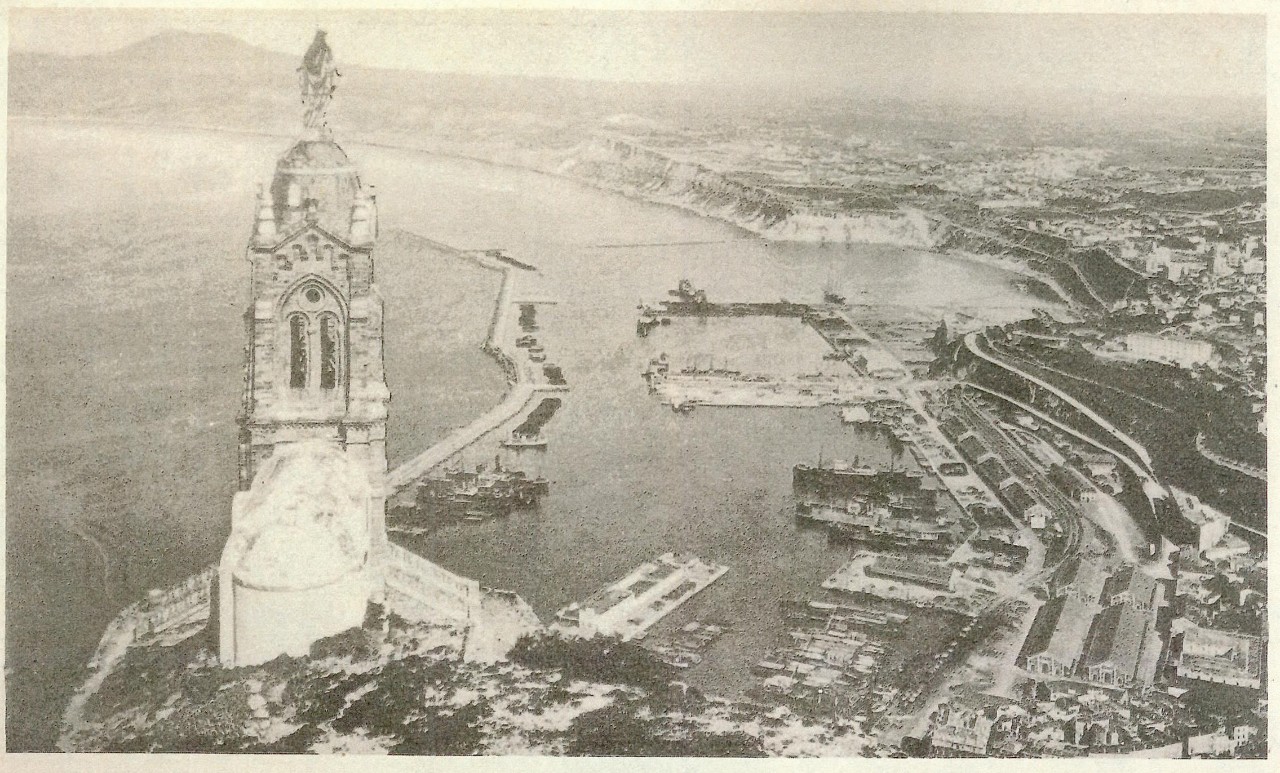
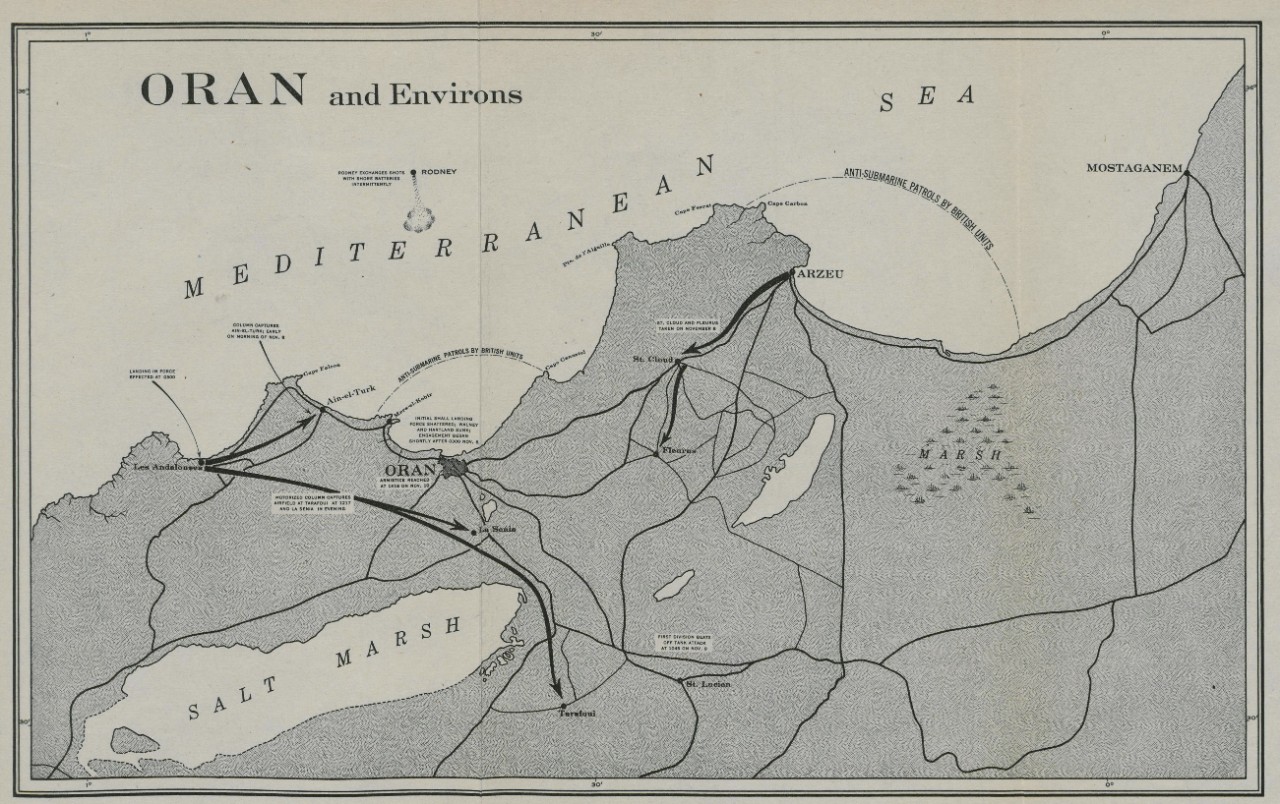
0-44-566293 Faces p. 64
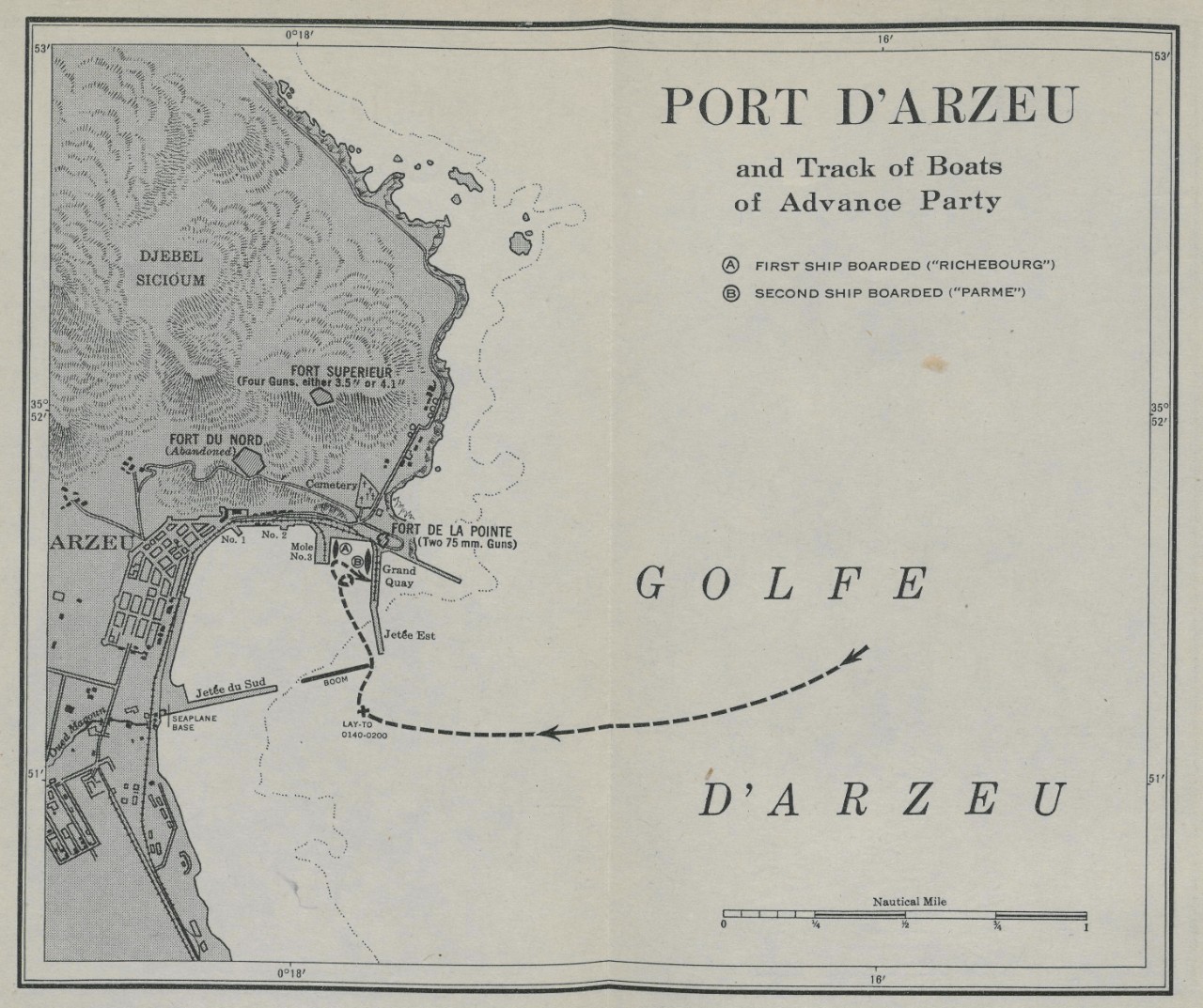
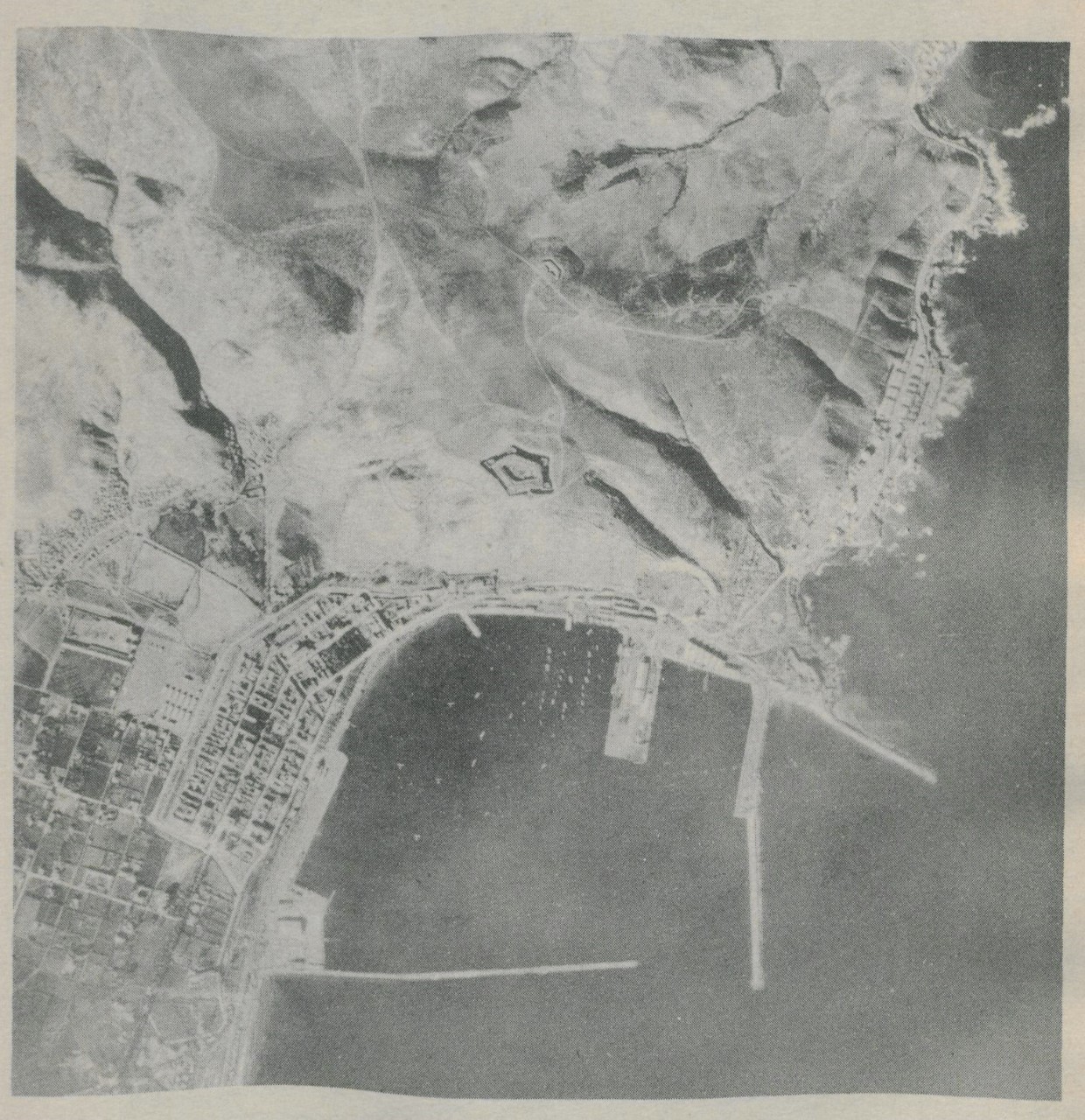
Airplane view of Arzeu
necessary to occupy a neighbor port, Arzeu, a small, snug harbor on the eastern side of the Cape Ferrat promontory, 25 miles to the east of Oran. The plan also called for landings on beaches to the east and west of Oran and a subsequent convergence on the city. In order to prevent the sabotage of ships and port installations, the harbor of Oran was to be entered by the two ex-United States Coast Guard cutters, HMS Hartland and Walney, and a special detachment put on shore.
The two operations will be considered in the order named.
The harbor of Arzeu is south of Djebel Sicioum at the northwesterly end of curving bay. The harbor entrance faces due south and is formed by two breakwaters, one paralled to the coast, the other at right angles to it. On the easterly slope of Djebel Sicioum, at Fort Supérieur, a battery of four guns (exact caliber uncertain, either 3.5” or 4.1”) had been mounted. At Forte de la Pointe, where the eastern breakwater starts, two 75-mm. guns had been placed.
The plan of attack called for a landing by two companies of Rangers near Fort de la Pointe at H-hour (0100) on 8 November, after which an advance party was to enter the harbor. This party was commanded by Capt. Walter Ansel, USN, and consisted of 3 other United States officers (Lt. Col. Louis C. Plain, USMC, Lt. Comdr. Curtis B. Munson and Ens. Frank Olender) and 11 enlisted Marines. At 0035 the party embarked in a LCA of the transport Royal Ulsterman together with a British port party (exact number not stated). The boat was commanded by a Royal Naval Reserve officer who took orders from Comdr. H. Archdale, R.N., who in turn consulted Capt. Ansel throughout the operation. At about 0400 departure was taken and a course steered by visual toward the harbor entrance. The light on Arzeu Island was then burning. At about 0140 the party was off the entrance and hove to. HMS Calpe, destroyer, remained in the neighborhood for support.
In the meantime the first assault waves of Rangers had presumably landed near Fort de la Pointe and should have occupied the shore in the harbor south of that point. No firing, however, had developed and no signal of success observe so the advance party was in ignorance as to the progress being made on shore, although landing boats had been seen returning. At 0200, therefore, it was decided not to await any signal from the Army but to proceed into the harbor.
The night was extremely dark and the party had considerable difficulty recognizing landmarks. Fortunately, the French had left the lights
65
burning on the buoys. These, however, were mistaken for the breakwater lights, so that some confusion resulted. Nevertheless the harbor was entered without incident and a course taken toward the docks at the far end. When the party arrived somewhere between the third mole and the Grand Quai, a blast of machine-gun fire was heard on shore indicating that the Rangers were attacking the fort. The boat thereupon circle to the right to avoid the fire, and headed towards Mole Three. At this point two ships were recognized , one on the eastern side of the mole, and one at the Grand Quai. At the same time four Very rockets appeared to the right, which was the prearranged signal that the landing party of Rangers had been successful. It was therefore decided to land and proceed to capture the shipping in the harbor.
The first vessel to be boarded was the Richebourg, of about 3,000 tons. The second vessel was the Parme, about the same size. The crew of the first ship was largely Arab, the crew of the second mainly French. The captains were told the mission of the boarding party and assured that their vessels were under the protection of the United States. They were then directed to assemble their crews and inform them of the situation. Both skippers proved to be perfectly amenable and n trouble was encountered. The Danish ship Meonia, which had been recently taken over by the French, was next boarded. In the meantime, contract was made with the Rangers, and Senegalese prisoners were being brought in. These were placed on board the ships which had been taken over. By daylight, all the shipping in the harbor had been occupied.
As the light increased and targets became visible, the French fire became more intense. Large caliber and machine-gun fire seemed to come from the southern breakwater and the adjoining seaplane base. Sniping also broke out from the high ground overlooking the harbor. The two LCA’s[49] were thereupon despatched to engage the machine guns on the southern jetty, using their own .50-calier guns. The French firing continued, nevertheless. The boats thereupon were directed to make smoke screens which had the effect of blanketing the vision of the French gunners.
United States Army contingents, however, soon occupied the seaplane
__________
49 LCA’s (Landing Craft, Assault) had the following specifications: Capacity: 25 troops and 800 lbs. equipment besides crew of 4. Length: 41 ft. Beam: 10 ft. Draft: Forward 1’ 9”, Aft 1’ 11’. Speed: 11.5 m.p.h. Endurance: 65 miles. Displacement: 18,000 lbs. Armament: one .50-caliber Bren Gun. Armored from forward bulkhead to stern. Twin screw.
base and put a stop to further resistance from that quarter. By 0745 the Rangers had consolidated the fort area and all French naval personnel, including the crew of a small patrol vessel, had been made prisoners. The mission of the landing party had therefore been speedily and successfully accomplished. Arzeu was promptly occupied in force by the First Division[50] which established headquarters in town and used it as a base for further operations against Oran.
The Oran operation was to prove more difficult. The original plan, approved by Gen. Eisenhower, did not mention a frontal attack. The moment of entering the harbor was to be just prior to the surrender or capture of the city. That this might be delayed considerably beyond H-hour was foreseen by the operation order. “It is highly improbable,” the last sentence read, “that the order to immobilize the port will be given by the French commander until it is clear that the port cannot be held.” Capt. F. T. Peters, who commanded the operation, was contemplating entering with the HMA Walney (ex-U.S. Coast Guard cutter Sebago) and the HMS Hartland (ex-U.S. Coast Guard cutter Pontchartrain), all guns firing, at H plus 15 minutes, if possible- in any event by H plus 2 hour hours- and to put out of action the batteries near Cape Blanc and at Fort Lamoune.
This entry at a predetermined time regardless of the progress of the Army obviously involved the risk of heavy casualties from the fire of the shore batteries. Nevertheless, the risk was accepted and the landing party proceeded into the harbor without any preliminary bombardment.
The landing party consisted of about 500 United States combat troops and 30 United States naval engine room personnel who had undergone a period of intensive training in Scotland. To these were added a British contingent of 40 naval ratings and a special demolition party of 12. The mission of the group was threefold: (1) To capture Fort Lamoune and the battery near Cape Blanc, (2) to capture and hold the wharfs, (3) to board and hold the merchant ships in the harbor in order to prevent sabotage. The last named objective was to be carried out by the party to which the United States naval contingent had been assigned. They had been placed on board the Hartland.
__________
50 As previously noted, the First Division was the one to develop the U.S. Army amphibious tactics.
67
The party arrived off Cape Ferrat about 0100 on 8 November and began the approach to the harbor of Oran at 0300, the Walney leading, followed by the Hartland and two motor launches. The first approach was inaccurate, necessitating a reapproach. Meanwhile, an alarm had been sounded in the city and a searchlight picked up the Walney. Heavy gunfire ensued. Both ships turned away, making smoke. No fire support was given them as in the case of the Bernardou and Cole at Safi. As they reapproached, the French fire, which had momentarily ceased, was resumed. The Walney, nevertheless, broke the boom and proceeded up the harbor.
The Hartland, 600 yards astern, ran on the south jetty, backed off, and proceeded to a position west of the Môle du Ravin Blanc. By this time she was drifting, out of control. The French destroyer Typhon had opened fire on her but at this point was compelled to cease firing so as not to endanger French shipping. Soon the Hartland was on fire and all hands were driven on deck, where they were exposed to machine-gun fire from the French naval units I the harbor as well as from several guns on shore. Orders were given to abandon ship at 0410. The Hartland burned until 1016 when she exploded and sank.
In the meantime the Walney was proceeding up the harbor. On the way she encountered severe fire from shore batteries, four French destroyers and two submarines. At 0445 she exploded at a point close to where the Epervier was moored.
The failure of the landing party to attain its objective was due to the overwhelming fire it encountered. In view of the recent British attack on the French fleet at Mers-el-Kébir, the landing in Oran Harbor had been entrusted to American troops and to two former American vessels. To increase the possibility of only pro forma resistance both vessels flew United States colors at the fore, the British ensign being flown from a signal hoist. The darkness, however, prevented the French from recognizing the American complexion of the force, assuming they were disposed to do so- of which there is no evidence.
While the Hartland was aground on the breakwater all hands topside were killed. Only two of the detachment later got ashore with weapons. Forty percent of the personnel embarked in that ship were killed. The survivors, about 200, practically all of whom had been wounded, were taken prisoners by the French and released when the city was captured on 10 November. Our forces, besides sustaining heavy losses, had failed
68
to save the shipping and warship in the harbor, which were sabotaged by the French on the approach of the Center Task Force. Three floating drydocks and 25 vessels had been damaged, among them the submarines Danaë, Pallas and Céres.
In spite of this unfortunate episode the operations against Oran progressed. Contact was made with the beacon submarine, as planned. The usual delays in getting landing boats off and an error of 2 ¼ miles in the position of the transports were the only incidents. By 0300 a landing at Les Andalouses, 12 miles west of Oran, had been effected and the ships proceeded towards shore to complete discharge of men and matériel.
At 0328 HMS Aurora, while patrolling 5 miles to the northward of Oran,[51] noticed a powerful searchlight illuminating the landing forces. She opened fire at 1,000 yards and extinguished the light. Shortly thereafter the destroyer Tramontane sorties from Oran. After a brief engagement at 6,000 yards she was observed to burst into flames and sink (0537). Two other destroyers, the Tornade and Typhon, and the escort vessel Surprise, had meanwhile sortied and were standing by their stricken comrade. At first they were not engaged. They soon, however, opened fire on HMS Calpe and Boadicia and fired a torpedo at the Aurora. The Boadicia was hit forward. In the running fight that ensued the Surprise was sunk. The Tornade was hit by a broadside and headed for shore while the Typhon was hit on stern and retired to Oran (0650). At 0727 the engagement was broken off. The French naval forces in Algerian waters were evidently as aggressive as their Moroccan comrades.
During the morning the navy-manned battery at Mers-el-Kébir opened fire on the beaches. The Rodney replied at 0956 and 1029 with her main armament, ranges 23,000 and 26,000 yards. She also bombarded the fort on Jebel Santo at 1235, 1512 and 1545 at ranges of 22,000 to 24,000 yards.
At about 0800 two columns of the Center Task Force started from Les Andalouses. One, a motorized column, made a dash for the airfields at Les Senia and Tarafoui, south of Oran. The latter was seized at 1217, the former held out until evening. Aircraft from the British carriers assisted in both operations, In the meantime, a column advancing
__________
51 Antisubmarine patrols were maintained between Oran and Arzeu during the entire operation.
69
from Arzeu captured St. Cloud and Fleurus, the latter only 10 miles east of Oran. By nightfall a well-defined pincer movement was developing against the French position.
During the following day, 9 November, the debarkation continued, hampered by the increasing surf and the loss of landing boats. At 0830 the Rodney was shelled by Jebel Santo at 22,000 yards, the shell just falling short. At 0934 the Rodney replied at 30,000 and again at 0954 at 34,500 yards. Shortly thereafter two French destroyers, the Epervier and Typhon, were sighted coming out of Oran. They were engaged by the Aurora and the Jamaica. The Epervier was later reported ashore and burning south of Pointe de l’Aiguille. The Typhon was beached near the harbor, blocking the entrance.
The First Division, in spite of stiff resistance encountered around St. Cloud, had by this time reached positions 7 miles east and 3 miles west of Oran and at 1045 had beaten off a French tank column at St. Lucien.
The final assault on Oran was planned for 10 November. The morning began with renew firing by Jebel Santo to which the Rodney replied at 1058 and 1142. At 1416, however, all firing ceased. Armistice negotiations were under way. In due course Oran was occupied by the United States forces and a naval operating base established.
THE ATTACK ON ALGIERS[52]
Algiers was the most important objective of the North African expedition. As the unofficial capital its political importance was considerable and its occupation bound to affect the international situation in Europe as well as the strategic situation in the Mediterranean. Located on the southwestern edge of a deep bay extending from Pointe Pescade on the west to Cape Matifou on the east, Algiers is a modern city of about 200,000 inhabitants with a well-equipped harbor. The picturesque old Arab Kasba is now completely encrusted in the French city. The area had been garrisoned and fortified and its capture in the face of determined opposition seemed likely to prove a major operation. Following the precedents established by the many other expeditions which from time to time have attacked Algiers, troop landings were to be effected on the beaches lying to the west of Pointe Pescade, notably at Sidi Ferruch (where
__________
52 Information regarding British operations in this area had not been received as this Narrative went to press. The Algiers attack was, however, predominantly British. Readers are cautioned against any false impression which might be derived from the fact that the following text deals of necessity almost exclusively with our relatively small part in the affair.
70
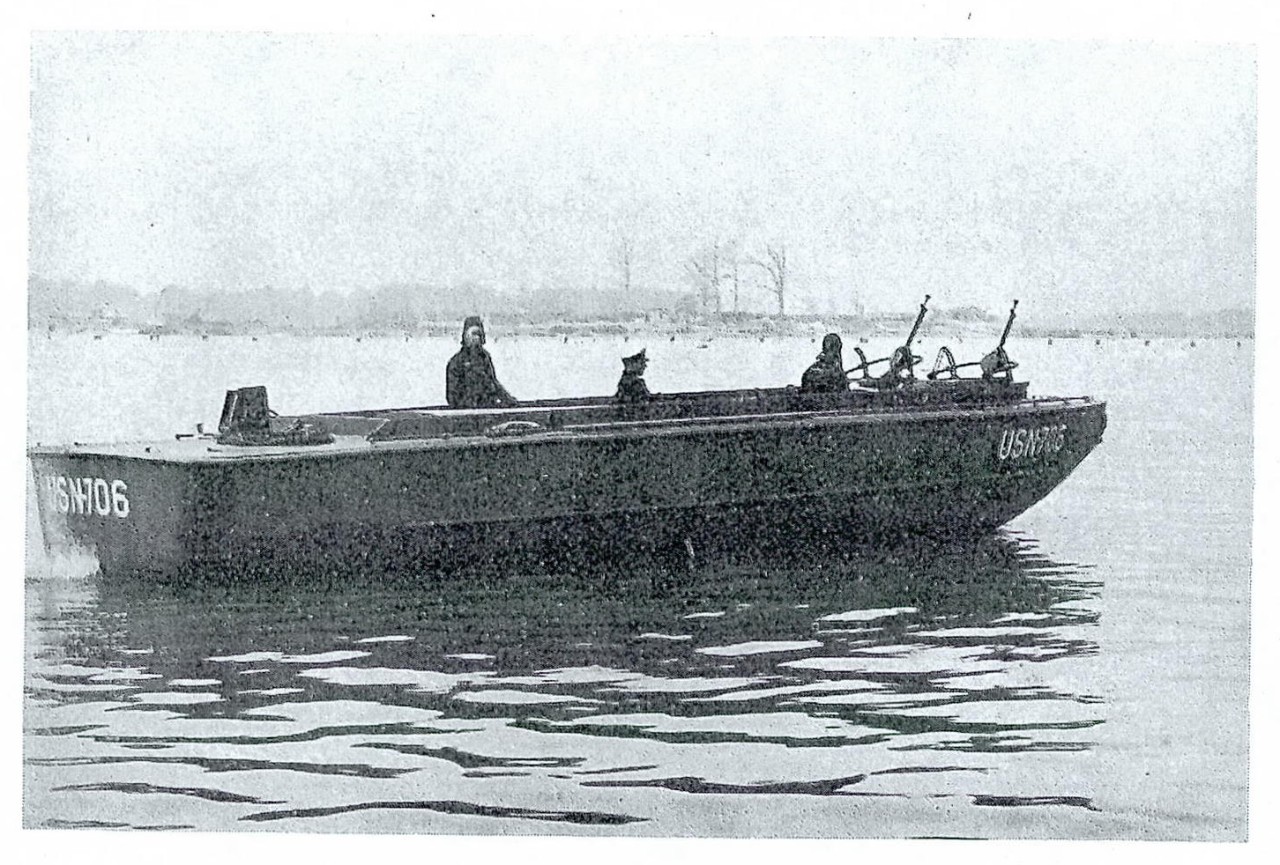
LCP(L) with armament
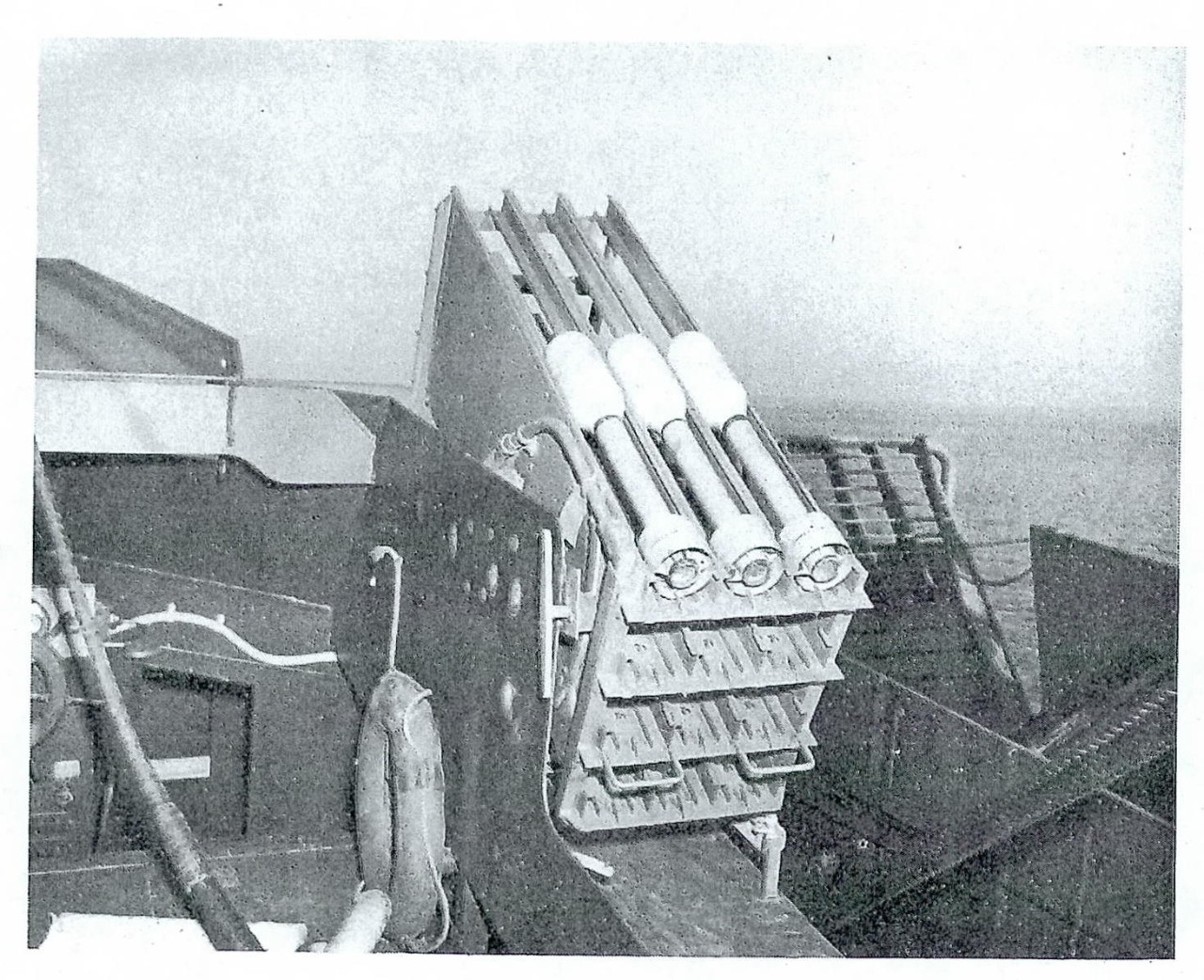
LCS with rocket racks
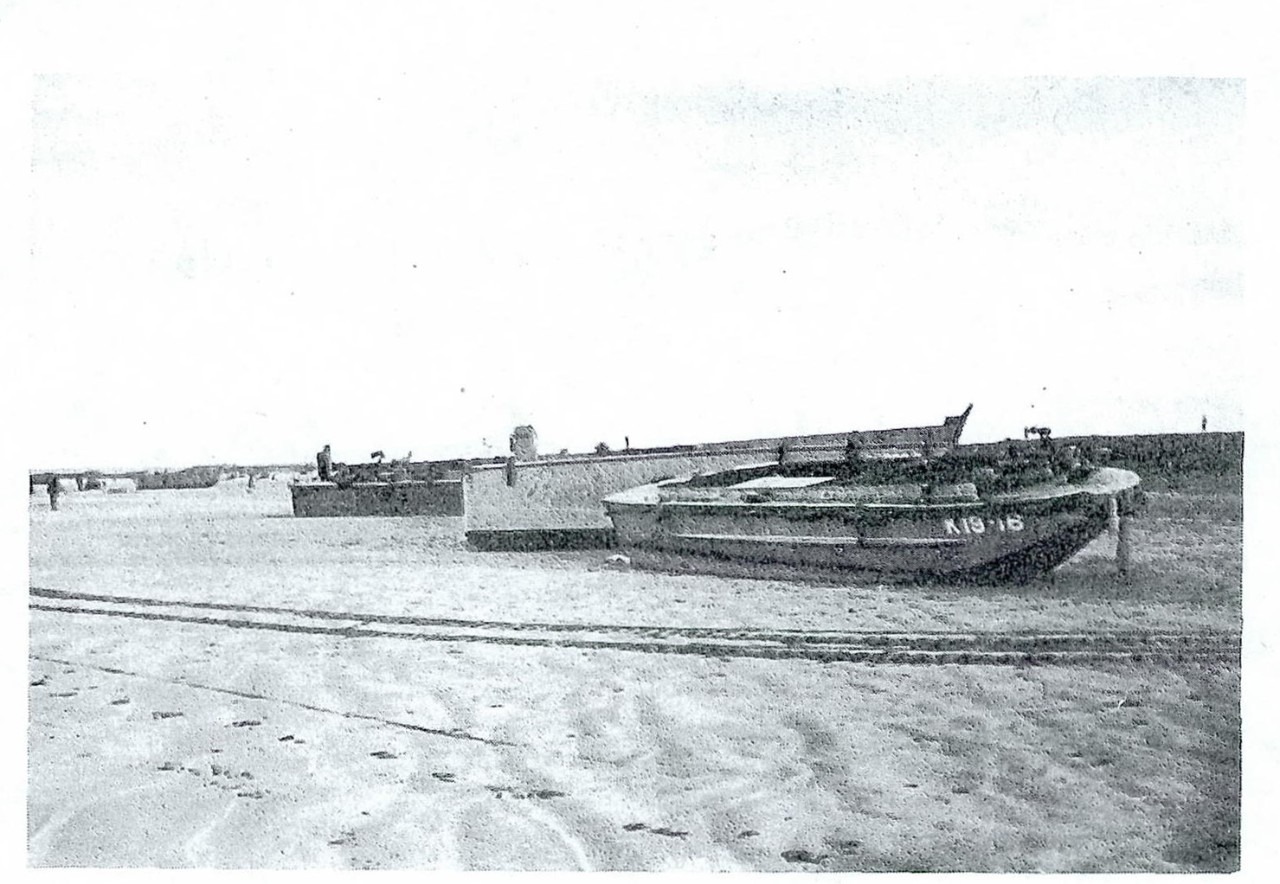
Stranded landing craft (Fedala)
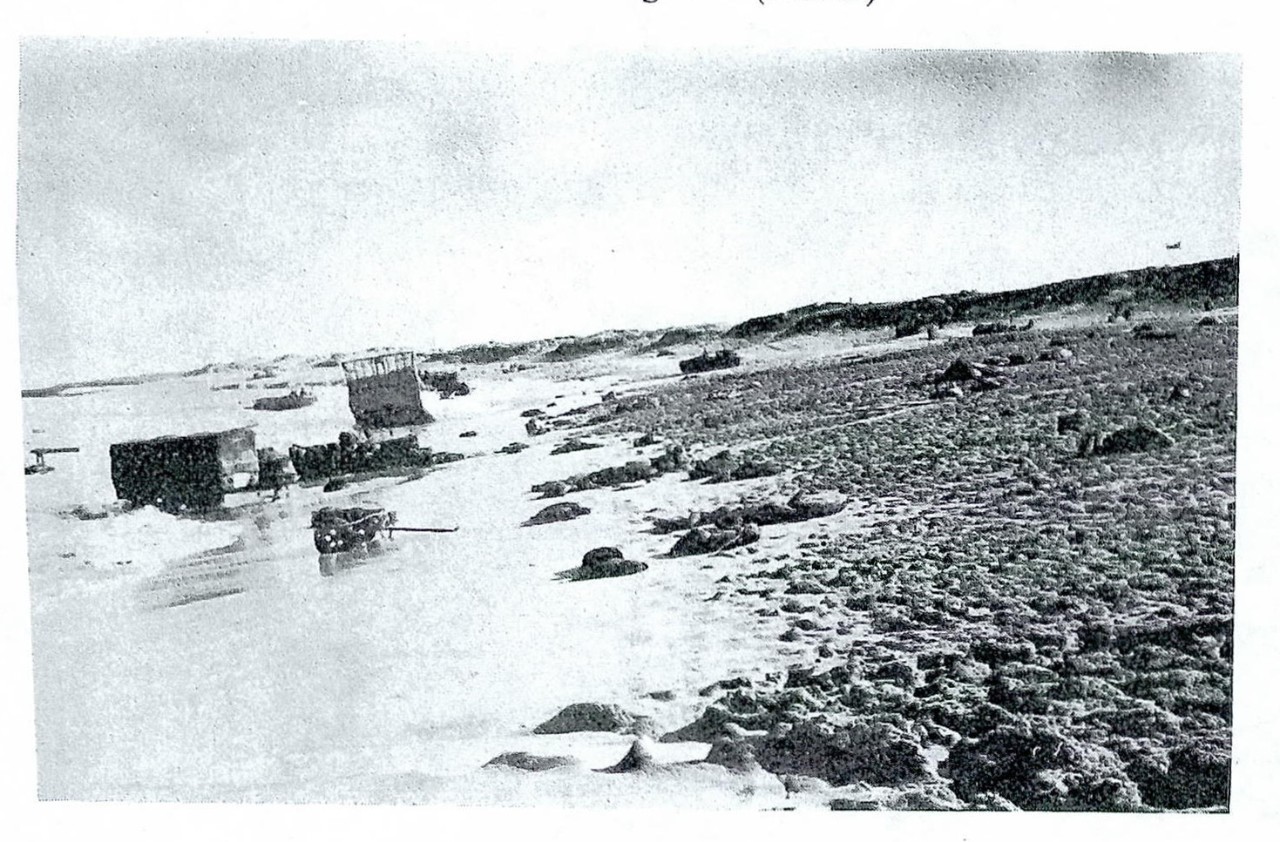
Broached landing craft (Fedala)
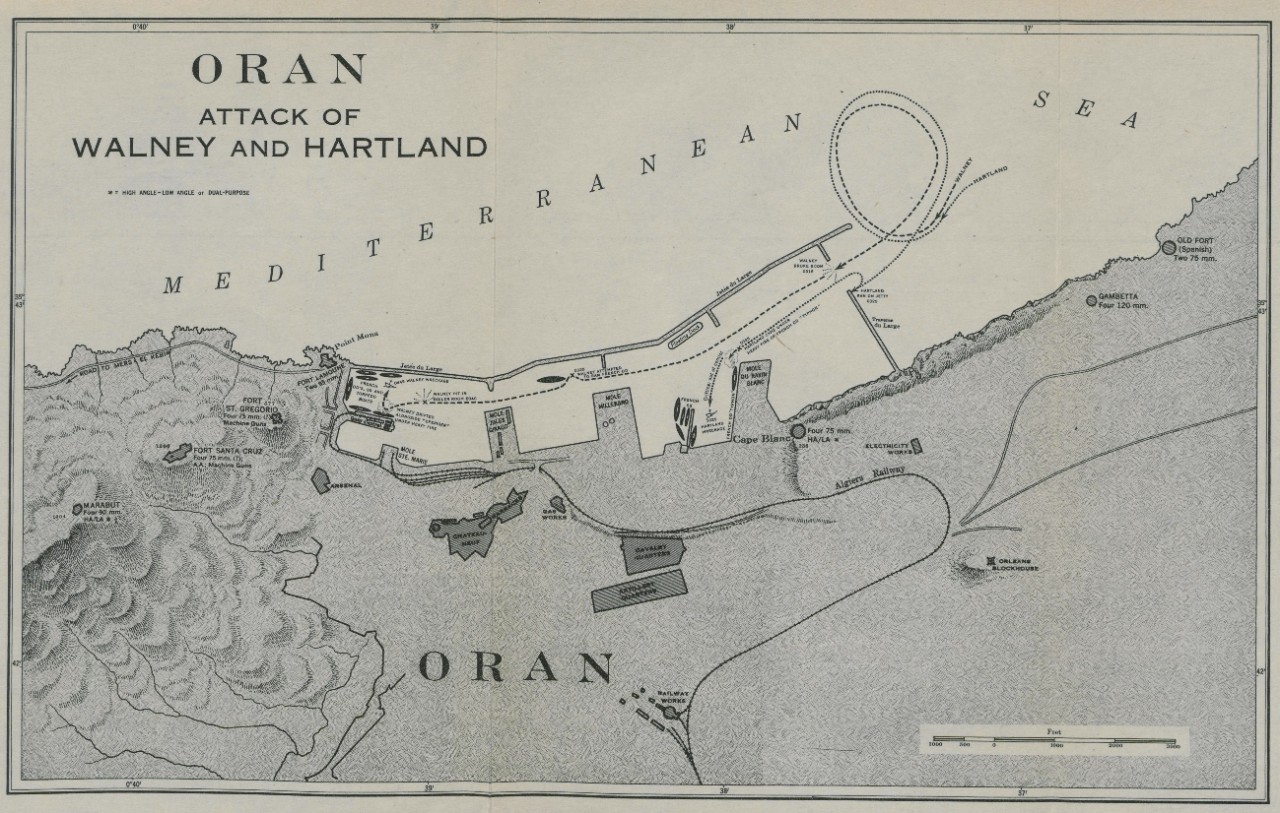
0-44-566293 Faces P. 70
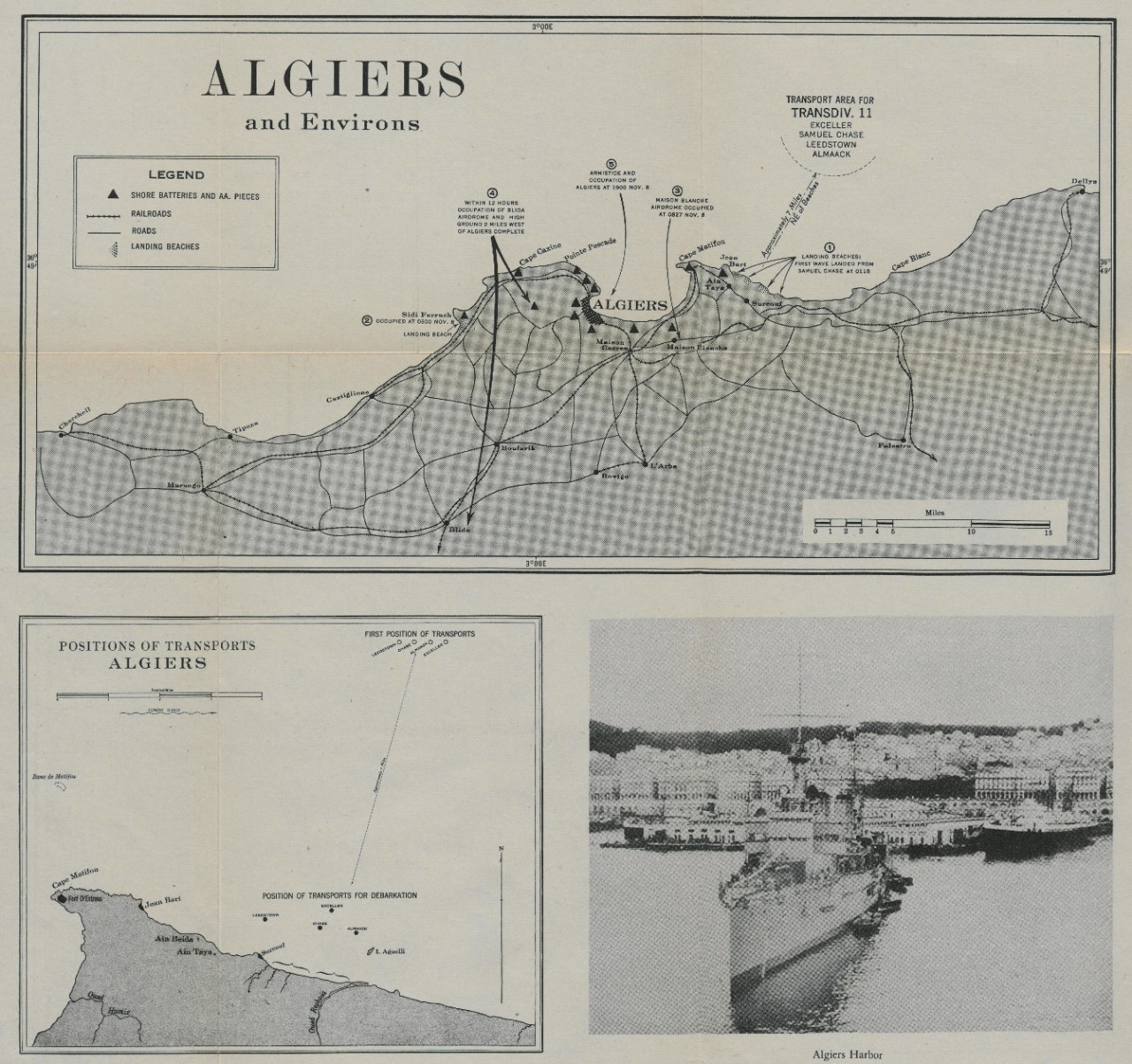
the original French landing had been made in 1830), and to the east of Cape Matifou.
The Eastern Naval Task Force (Rear Admiral Sir Harold M. Burroughs, R.N.) consisted of the following ships, all of which were British unless otherwise stated:
1 Headquarters ship-HMS Bulolo.
4 Cruisers-HMS Sheffield, Bermuda, Scylla and Charybdis.
1 Aircraft Carrier-HMS Argus.
3 Auxiliary Aircraft Carriers-HMS Palomares, Pozarica and Tynwald.
1 Monitor-HMS Roberts.
13 Destroyers.
7 Minesweepers.
3 Sloops.
7 Corvettes,
8 Trawlers.
6 Landing Ships, infantry.
5 Personnel Ships.
16 Motor Transport Ships.
2 Landing Ships, gantry crane.
3 Combat-loaded Transports (U.S.)
2 Cargo Ships.[53]
In addition to the task force, units of the British Mediterranean Fleet participated in these operations.
The three U.S. transports were:
Samuel Chase, (F), Comdr. Roger C. Heimer, USCG.
Thomas Stone, CApt. Olten R. Bennehoff.
Leedstown, Lt. Comdr. Duncan Cook.
These vessels, together with the U.S.S. Almaack, Capt. Chester L. Nichols, carrying service and antitank companies, and the American steamer Exceller constituted Transport Division ELEVEN, Capt. Campbell D. Edgar. The troops they carried were our contingent in the Eastern Assault Force of which Maj. Gen. Charles W. Ryder, U.S. Army, was in command.[54]
On 14 October, Transport Division ELEVEN departed from the Clyde in company with a fast convoy which included 37 vessels.[55] The cruise was without incident until after Gibraltar was passed. At 0537 on 7
__________
53 Presumably the U.S. Auxiliary Cargo Ship Almaack and the S.S Exceller.
54 No attempt will be made to deal with the adventures of any but the American military contingent.
55 In order to expedite the dispatching of convoys, the British separated the faster vessels from the slower ones.
71
November, just as day was breaking, an explosion occurred well aft on the Thomas Stone, disabling her propeller and rudder and causing her to drop out of the convoy. At almost the same moment a plane was seen coming up from the stern passing from starboard to port. It was sighted for only a few seconds. At first it was believed that his plane had torpedoed the Thomas Stone, but subsequent investigation indicated that a submarine was responsible and that the plane was a British Swordfish in pursuit of the submarine. Nine men on the Thomas Stone were killed as a result of the explosion.
The damaging of the Thomas Stone was a severe blow, as her troops, some 1,4000 men, and boats were sorely needed in the operations set for the following day. Moreover, she was the only one of the 3 transports which had actual experience in landing troops prior to departure from the United States. Here Capt. Bennehoff took a courageous decision. He determined, with the concurrence of the responsible Army officer, Maj. Walter M. Oaks, U.S. Army, to use the ship’s boats to land the troops he was carrying, so that they could participate in the capture of Algiers while he attempted the salvaging of his damaged vessels, the position of which at that time was latitude 37ᵒ 01’ 30’’ N. longitude 00ᵒ E., approximately 160 miles northwest of Algiers. The sea was smooth with a slight breeze from the northeast. It was determined, therefore, that with the gasoline tins available on board, the ship’s landing boats could probably complete the 160 miles to Algiers.
Accordingly, about 800 troops comprising 3 assault waves were placed in the 24 most seaworthy landing boats, which were to be escorted by HMS Spey. In order to maintain the secrecy of their destination it was decided that the boats would not get under way until after dark. At 1852 they were dispatched under Lt. (jg) Ralph C. Marler with orders to proceed to the beach southwest of Cape Matifou. At first a speed of between 8 and 9 knots was maintained, but this soon had to be reduced to 6 knots. At 2000 the engine of one boat broke down. Repairs were effected and the boat rejoined the group at 2130, at which time 2 more boats broke down. They were repaired and rejoined the group. From that time there was never a period of 30 minutes in which all the boats were able to proceed at one time. Broken oil lines, broken water lines, overheating, etc., were continually disabling one or another of the boats which had to be taken in tow while repairs were made, thereby delaying progress.
73
At approximately 2115, the captain of the Spey informed Lt. Marler that he had received orders to return to the Thomas Stone. A conference was held between Lt. Marler and Maj. Oates as to whether to continue without the Spey. Maj. Oates was doubtful whether the boats would make shore safely. It was therefore decided to follow the corvette back to the Thomas Stone. At about 2200, however, the British officer advised that he had received orders to take the boat group either back to the transport or to Algiers. Lt. Marler promptly chosen Algiers.
At approximately 2300, the Spey deviated about 4 miles to port to investigate radar contacts. The boats ran very slowly awaiting her return. About 2330, fire and a white flare were observed to port. Twenty-five minutes later the Spey rejoined and her captain stated that he had been in contact with boat No. 28 which had fallen behind, got out of position, and had been proceeding in the wrong direction.
At midnight the wind freshened to force 3, and a sea began running from the southeast. All boats using gasoline were constantly refueling at every stop made for broken down boats. At approximately 0030 on 8 November, the officer in charge of boat No. 9 advised that he had been in collision with another boat and was taking water fast. Lt. Marler instructed him to put his men and equipment aboard the Spey and open the seacocks of his boat.
About six in the morning the condition of the sea appeared very unfavorable. The boats were taking considerable water in spite of the fact that speed had been reduced to 4 knots. The troops were all seasick and wet, and al gear was soaked. Lt. Marler and Maj. Oates held a conference on board the Spey on which it was decided to place all men and equipment on board that vessel, especially as she had a mission to perform on the following morning and would have to make haste. In the meantime, however, word had been received from Algiers that the assault waves had landed but that all the boats had been lost due to high seas and rocky beaches. Lt. Marler, thereupon decided to scuttle all the boats that were unseaworthy but to retain three ramp boats, two personnel boats and two support boats. With these proposed to continue. The captain of the Spey in the meantime agreed to cooperate by maintaining a speed of 11 knots, which was only 1 ½ knots more than the boats were now making.
No sooner had Lt. Marler started than he discovered that none of the compasses on his boats would work. The presence of so much metal
73
in the loaded boats produced a deviation which could not be compensated. The sky was overcast so that no position could be taken by the stars. Daylight would have to be awaited in order to take a position by the sun. Lt. Marler again went on board the Spey and held a conference with her captain who agreed to take the two support boats in tow but not the others.
In the meantime the sea had risen and the wind was steadily increasing from the southeast. Lt. Marler thereupon transferred all hands to the Spey and scuttles all the remaining boats except the support boats. At approximately 1300 the Spey headed for the beaches to the east of Cape Matifou. Two hours later one of the support boats broke adrift, but was recovered. The captain of the Spey, however, advised that he could nor risk the ship and the many men on board by stopping again. About 1800 another support boat broke away and at 1900 the remaining one broke away. This left Maj. Oates exactly one lifeboat for unloading troops. Additional landing boats were requested by radio but no answer was received. By this time a heavy sea was running. The Spey reduced speed to avoid shipping seas which might was men and equipment overboard.
At 2030 the Spey finally anchored 1 mile off shore. At 2300 were received to remain at anchor, as Algiers had surrendered, and to proceed to that port at 0600 the following day. At 0700 on 9 November the Spey berthed alongside the main passenger quay at Algiers and unloaded her troops and equipment.
The departure of the Spey left the Thomas Stone adrift without protection until the destroyers requested from Gibraltar had arrived. Because of the importance of the Spey’s mission, this risk was considered justified, as there were sufficient boats and life rafts to accommodate all the crew and remaining groups should the submarine return to attack. A landing boat was stationed on either side of the ship 1,000 yards distant to patrol as an antisubmarine screen. It should be noted that the absence of any submarine attack during the ensuing night furnishes some evidence for the belief that the torpedo had been fired from a plane. At 2040 HMS Wishart and Velox, destroyers, arrived in the vicinity of the ship. The Wishart attempted to take the Thomas Stone in tow with an 8-inch hawser made fast to 30 fathoms of the port anchor chain. The towline parted, and at 2313 an inch and a half wire was run. The Wishart, however, had difficulty in managing the tow and little progress was made during the night.
At 0535 of 8 November HMS St. Day (a tug) reached the ship and took position astern with a line to either quarter of the Thomas Stone and acted as a rudder while the Wishart towed. This did not prove successful and the tow was shifted from the Wishart to the St. Day. The Wishart thereupon joined the screen. The wind freshened considerable during the day and little progress was made. By the morning of the 9th the wind had risen to force 4-5. At 0840 an enemy plane was sighted and 21 round of antiaircraft ammunition fired with no hits. At this point it was decided to tow in tandem with the Wishart towing and the St. Day holding the transport’s head up. In this manner a speed of 4 knots was obtained. The Velox, which was acting as escort, detected a submarine and dropped a depth charge. Fortunately the weather moderated on the 10th. At 1040 another submarine alarm occurred. The Velox dropped four depth charges astern of the tow. No attacks were made, however. Finally, at 0027 of the 11th, Cape Caxine was sighted. As day broke British warships were observed patrolling before Algiers. At 0725 the tow arrived off the harbor and anchored at 1034. Here a message was received from Rear Admiral Burroughs: “My warmest congratulations on the splendid effort put up by the U.S.S. Thomas Stone. The determination to take part in this operations, whatever the obstacle, is an example to us all.”
An examination of the injured vessel disclosed serious damage: propeller shaft broken; steering gear machinery knocked loose from foundation, bent and broken; electric equipment and pumps damaged by submergence. Her salvage, especially in view of weather conditions, was ascribable to superb seamanship on the part of her commander and crew and to the equally skillful maneuvering of the three British vessels who had stood by her.
The Thomas Stone was not the only vessel of Transport Division ELEVEN to suffer casualties. At 2220 of 7 November the Leedstown arrived at the transport area and at 2355 put off her Commando wave. At 0200 she proceeded at slow speed to her assigned position and at 0815, 8 November, dropped anchor in 42 meters of water with Cape Matifou light bearing 278ᵒ and Arguelli Island bearing 107ᵒ. Debarkation of troops was proceeding steadily when at 1730 a considerable number of Heinkel bombers and Junkers 88 torpedo planes appeared. All ships went into action. Events occurred with great rapidity. The attack was well planned and executed under cover of approaching
darkness. As the action was drawing to a close a Junkers 88 was observed crossing from the Leedstown’s starboard quarter to port quarter close astern at an altitude of approximately 50 feet. This plane was hit repeatedly by the Leedstown’s guns and soon crashed in flames. A few seconds later another Junkers 88 came at a low altitude directly astern and launched two torpedoes, one of which hit the Leedstown on the starboard counters in the steering engine room compartment.
An examination showed that the damage was extensive. The steering gear compartment was completely wrecked, the deck ruptured and buckled, the steering engine room demolished and three-quarters filled with water which was pouring in rapidly through ruptured plates. The rudder had been carried away and a bad leak developed in No. 6 hold. Nevertheless, debarkation was continued.
During the night the sea rose and by 0800 of the 9th wind of force 5-6 was blowing from northeast-by-east. Unloading had to be discontinued. At 1030 a dispatch was sent to Algiers requesting tugs, and another to the airport at Maison Blance requesting fighter protection.
At 1255 two planes were sighted immediately overhead and three heavy bombs straddled the Leedstown. These near-hits caused great vibration throughout the ship and increased the damage suffered the night before. At 1310 the Leedstown was struck amidships by two torpedoes which exploded with terrific force. The ship began settling by the head with an increased starboard list until the main deck amidships by two torpedoes which exploded with terrific force. The ship bean settling by the head with an increased starboard list until the main deck amidships was under 3 feet of water. The decision to abandon ship was taken. HMS Samphire stood by and performed a splendid rescue operation, landing 104 survivors at Algiers the following morning (10 November). All casualties were removed in the one remaining motorboat, which had been salvaged from the beach with the motor out of commission. At 1430, all personnel having left the sinking ship, Comdr. Cook went over the side and was rescued by the Samphire and hour later. A muster held on the 12th showed 20 of crew missing, of who 2 were killed and 6 missing in action. The small loss of life was due to the rescue work done on the beach by the inhabitants, the Army, and the beach parties who, at considerable risk to themselves, assisted the occupants of rafts and boats struggling in the surf.
The landings in which Transport Division ELEVEN took part were four in number. Two beaches extend from Surcouf to the Oued Reghaia. All vehicles were to be landed on those beaches. A third beach, about
800 yards wide, is situated halfway between Jean Bart and Ain Taya, and a fourth beach, of about the same size, lies in front of Ain Taya. Personnel was to be landed at the last two beaches.[56] A transport area was chosen about 7 miles northeast of the debarkation points and there the Samuel Chase, Leedstown, Almaack, and Exceller stopped at 2201 of 7 November. The lowering of boats began at once and by 2256 the Samuel Chase had all her boats in the water. By 2307 the Almaack had done likewise.
The first wave left the Samuel Chase at 0015 on 8 November and arrived at the designated beach at 0118, and from then on the debarkation continued uninterruptedly. After the last wave had departed, the transports approached to approximately a mile offshore, preparatory to unloading equipment.
The only serious resistance was that offered by the enemy planes. At 0225 the first plane appeared and was fired on by the escort vessels. At 1730 a concerted air attack was begun. The Leedstown was the only vessel to be hit. In the meantime the weather had taken a turn for the worse. By 2000 a force 5 wind was blowing from east northeast. Boating operations were discontinued. By that time, however, word was received that an agreement had been reached with the French. Firing ceased. As far as the French were concerned, although Axis air attacks continued intermittently during all of the 9th and 10th.
The fighting around Algiers never attained the intensity reached in other areas. The navy-manned batteries at Cape Matifou and Fort d’Estrées alone proved recalcitrant and had to be severely bombarded by HMS Bermuda and naval aircraft between 1400 and 1530. Armistice negotiations were on foot from the start, although some time lag occurred before other forces laid down their arms. Sidi Ferruch airfield was occupied by American troops at 0300, 8 November, the Maison Blanche airfield at 0827. Within 12 hours after landing, the Army had occupied high ground 2 miles west of Algiers and the Blida airfield. By 1900 French resistance had ceased and the occupation of Algiers began. British forces participated in these operations.
It was indeed fortunate that no serious opposition had been met on shore. Of the 26 boats launched by the Samuel Chase, 6 never survived the first landing although the surf at that time was not heavy. Only
__________
56 The importance of accurate intelligence work here became apparent. What seemed from the air to be a good sandy beach proved on one occasion to be solid sandstone.
10 of the transport’s boat lasted through the night. The situation on other ships was even more serious. Of the boats used in the Algiers landings 98 were damaged or lost, a percentage of 94.[57]
After the armistice the transports were able to proceed to Algiers where unloading facilities were plentiful. Good relations were soon established with the French authorities. The occupation of the surrounding country was promptly begun. On 11 November at dawn the Thirty-sixth Infantry Brigade landing at Bougie without opposition. The advance on Tunis was under way.
CONCLUSION
The landing in Morocco and Algeria constituted one of the largest joint expeditions then known to history. The operations were marked by several noteworthy features. The coordination between land, sea, and sir was well-night perfect. What is even more important, a high degree of mutual understanding characterized the relations between the United States and the British high commands.
The Moroccan campaign was, as we have seen, an entirely American undertaking both as regards to the military and the naval forces involved, with a total of more than 37,000 officer and men in the land forces and 99 vessels of all categories.
The Algerian campaign was a joint one. The British furnished the naval force with the exception of the five vessels constituting Transport Division ELEVEN. Of the 72,000 officers and men landed in Algeria, 23,000 were furnished by the British Army and 49,000 by the United States Army.
In spite of the fact that the Morocco and Algerian convoys sailed from different continents, the simultaneous landing was effected without a hitch.
That the occupation of Morocco prevented the Axis from gaining a port facing the South Atlantic is evident. The occupation of Algeria greatly facilitated the westward advance of the British Eighth Army. Far from becoming a starting point from which to initiate an attack against the Atlantic coast of the Americas, northern and western Africa, once in Allied hands, became the springboard from which our powerful attack was launched against Sicily in July 1943.
__________
57 This high percentage was attributed by one observer to (a) poor design (the plastic boats proved fragile), (b) inexperience of coxswains, (c) overloading, (d) not unloading promptly and expeditiously, (e) backing off before ramp was closed, (f) engine failire.
APPENDIX I
Task Force HOW
Organization for departure
At the time departure was taken, and during the assembly period that preceded it, the Task Force was divided into a Covering Groups, an Air Group, and two Detachment.
The Covering Group (Task Group HOW-I) under the command of Rear Admiral Robert C. Giffen (ComCruDiv SEVEN), consisted of:
Battleship:
Massachusetts (F), Capt. Francis E.M. Whiting.
Cruiser Division SEVEN:
Wichita, Capt. Francis S. Low
Tuscaloosa, Capt. Norman C. Gillette.
Destroyer Squadron EIGHT, Capt. Don P. Moon:
Wainwright (F), Lt. Comdr. Robert H. Gibbs.
Jenkins, Comdr. Henry T. Read.
Destroyer Division SIXTEEN:
Mayrant, Lt. Comdr. Edward K. Walker.
Rhind, Comdr. Henry T. Read.
Rowan, Lt. Comdr. Robert S. Ford.
Oilers:
Chemung, Comdr. John J. Twomey.
The Air Group (Task Group HOW-2) under the command of Rear Admiral Ernest D. McWhorter (ComCarLant), consisted of:
Aircraft Carrier:
Ranger (F0, Capt. Calvin T. Durgin.
Auxiliary Aircraft Carriers:
Santee, Capt. William D. Sample.
Sangamon, Capt. Carlos W. Wieber.
Suwannee, Capt. Joseph W. Clark.
Cruiser Division TWELVE:
Cleveland, Capt. Edmund W. Burrough.
Destroyer Squadron TEN, Capt. James L. Holloway, Jr.:
Ellyson (F), Comdr. John B. Rooney.
Destroyer Division NINETEEN, Capt. Charles Welborne, Jr,:
Hambleton (F), Comdr. Forrest Close.
Rodman, Comdr. William G. Michelet.
Emmons, Lt. Comdr. Harold M. Heming.
Macomb, Comdr. William H. Duvall.
Destroyer Division TWENTY, Capt. Thomas L. Wattles:
Forrest (F), Lt. Comdr. Merle Van Metre.
Fitch, Lt. Comdr. Eugene C. Burchett.
Hobson, Lt. Comdr. Robert N. McFarlane.
Plus additional destroyers:
Dallas, Lt. Comdr. Robert Brodie, Jr.
Cole, Lt. Comdr. Geo. G. Palmer.
Bernadou, Lt. Comdr. Robert E. Braddy, Jr.
Oiler:
Housatonic, Comdr. Alfred R. Boileau.
Detachment One-H (Task Group HOW-3) under command of Rear Admiral Monroe Kelly (ComBatDiv FIVE), consisted of:
Battleship:
New York (F), Capt. Scott Umsted.
Texas, Capt. Roy Pfaff.
Transport Division FIVE, Capt. Augustine H. Gray:
Henry T. Allen, Capt. Paul A. Stevens.
John Penn, Capt. Harry W. Need.
George Clymer, Capt. Arthur T. Moen.
Susan B. Anthony, Capt. Henry Hartley.
Electra, Comdr. James J. Hughes
Algorab, Comdr. Joseph R. Lannom.
Plus:
Florance Nightingale, Capt. Edwin D. Graves Jr.
Anne Arundel, Capt. Lunsford Y. Mason Jr.
Transport Division SEVEN, Capt. Wallace B. Phillips:
Harris (F), Capt. Otto M. Forster.
Dorothea L. Dix. Capt. Leo B. Schulten.
Titania, Comdr. Victor C. Barriger, Jr.
Plus:
Lyon, Capt. Martin J. Gillan, Jr.
Lakehurst, Comdr. Harold J. McNulty
Destroyer Squadron FIFTEEN, Capt. Charles C. Hartman:
Destroyer Squadron TWENTY-NINE, Capt. Charles C. Hartman:
Marvine (F, Capt. Hartman), Lt. Comdr. Solomon D. Willingham.
Quick, Lt. Comdr. Roger B. Nickerson.
Beatty, Lt. Cmdr. Frederick C. Stelter, Jr.
Tillman, Lt. Comdr. Francis D. McCorkle.
Destroyer Division THIRTY, Comdr. Horace C. Robison:
Cowie (F), Lt. Comdr. Charles J. Whiting.
Knight, Lt. Comdr. Richard B. Levin
Doran, Lt. Comdr. Howard W. Gordon, Jr.
Earle, Lt. Comdr. Hamilton W. Howe.
Mine Division TWENTY-ONE, Comdr. Albert G. Cook, Jr. (CoMinRon SEVEN):
Raven (F), Lt. Comdr. Colby G. Rucker.
Osprey, Lt. Comdr. Cecil L. Blackwell.
Auk, Lt. Comdr. William D. Ryan.
Tug:
Cherokee, Lieut. Joseph H. Lawson.
Detachment Two-H (Task Group HOW 14), under command of Rear Admiral Lyal Davidson (ComCruDiv EIGHT), consisted of:
Cruiser:
Augusta, Capt. Gordon Hutchins.
(Admiral Hewitt’s Flagship.)
Cruiser Division EIGHT:
Philadelphia (F, Admiral Davidson), Capt. Paul Hendren.
Brooklyn, Capt. Francis C. Denebrink.
Savannah, Capt. Leon S. Fiske.
Destroyer Squadron ELEVEN, Comdr. Dashiell L. Madeira:
Roe (F), Lt. Comdr. Rathel L. Nolan, Jr.
Parker, Lt. Comdr. John W. Bays.
Destroyer Division TWENTY-ONE, Comdr. Dashiell L. Madeira:
Livermore, Comdr. Vernon Huber.
Kearny, Comdr. Adolph H. Oswald.
Ericsson, Lt. Comdr. Clyde M. Jensen.
Destroyer Squadron THIRTHEEN, Capt. John B. Heffernan:
Buck (F), Lt. Comdr. Bosquet N. Wev.
Murphy, Lt. Comdr. Leonard W. Bailey.
Destroyer Squadron TWENTY-FIVE, Comdr. John S. Reese:
Woolsey (F), Comdr. Bernard L. Austin.
Ludlow, Lt. Comdr. Liles W. Creighton.
Edison, Lt. Comdr. William R. Headden.
Bristol, Lt. Comdr. John. A. Glick.
Destroyer Division TWENTY-SIX, Comdr. Edward R. Durgin:
Wilkes (F), Lt. Comdr. John B. McLean.
Nicholson, Comdr. John S. Keating.
Swanson. Lt. Comdr. Lewis M. Markham, Jr.
Mine Division NINETEEN, Comdr. Albert G. Cook, Jr. (CoMinRon SEVEN):
Hogan (F), Lt. Comdr. Ulysses S.G. Sharp, Jr.
Hamilton, Lt. Comdr. Robert R. Sampson.
Howard, Lt. Comdr. Charles J. Zondorak.
Palmer, Lt. Comdr. Joshua W. Cooper.
Stansbury, Lt. Comdr. Joseph B. Maher.
Transport Division ONE, Capt. Robert R.M. Emmet (Commander Transports, Amphibious Force, U.S. Atlantic Fleet):
Leonard Wood (F), Comdr. Merlin O’Neill, USCG.
William P. Biddle, Comdr. Paul R. Glutting.
Thomas Jefferson, Comdr. Chauncey R. Crutcher.
Arcturus, Comdr. John R. McKinney.
Procyon, Comdr. Lemuel P. Padgett, Jr.
Transport Division THREE, Capt. Robert G. Coman:
Charles Carroll (F), Capt. Harold Biesemeier.
Joseph T. Dickman, Comdr. Charles W. Harwood, USCG.
Oberon, Comdr. Ion Pursell.
Transport Division NINE, Capt. William M. Quigley:
Ancon (F), Capt. Paul L. Mather.
Elizabeth C. Stanton, Capt. Ross A. Dierdorff.
Thurston, Capt. Jack E. Hurff.
Plus additional Vessels:
Auxiliary Aircraft Carrier:
Chenango, Capt. Ben H. Wyatt.
Transports:
Hugh L. Scott, Capt. Harold J. Wright.
Edward Rutledge, Capt. Myron W. Hutchinson, Jr.
Tasker H. Bliss, Capt. Gerald L. Schetky.
Joseph Hewes, Capt. Robert M. Smith.
Mine Layers:
Miantonomah, Lt. Comdr. Raymond D. Edwards.
Monadnock, Comdr. Frederick O. Goldsmith.
Oilers:
Kennebec, Comdr. Stewart S. Reynolds.
Merrimack, Capt. William E. Hilbert.
Winooski, Comdr. John E. Murphy.
Special Unit:
Calvert (AP), Capt. James W. Whitfield.
Boyle (DD), Lt. Comdr. Eugene S. Karpe.
Eberle (DD), Lt. Comdr. Karl F. Poehlmann.
ORGANIZATION FOR PASSAGE
For the Atlantic crossing the Task Force was regrouped. The Covering Group, reinforced by several destroyers, became the Protective Screen. The Air Group remained the same except for the detachment of three destroyers assigned to the convoy which was, roughly speaking, a consolidation of the two Detachments. A convoy screen, consisting of destroyers and minesweepers was added. Thus reformed, the organization for passage was as follow:
The Protective Screen (Task Group HOW I), under the command of Rear Admiral Giffen, consisted of the battleship Massachusetts (F); the cruisers Wichita, Tuscaloosa, Philadelphia, Brooklyn, and Savannah; the destroyers Wainwright, Mayrant, Jenkins, Rhind, Rowan, Roe, Livermore, Kearny, and Ericsson; and the Chemung oiler.
The Air Group (Task Group HOW 2), under the command of Rear Admiral McWhorter, consisted of the aircraft carrier Ranger (F); the Macomb, Forrest, Finch, Corry, and Hobson; the auxiliary aircraft carriers Santee, Sangamon, and Suwannee; and the oiler Housatonic.
The Convoy Screen (Task Group HOW 12), under the command of Capt. Heffernan, consisted of: the Destroyers Buck, Woolsey, Ludlow, Edison, Bristol, Wilkes, Nicholson, Swanson, Davison, Mervine, Quick, Beatty, Tillman, Cowie, Knight, Doran, and Earle; the minesweepers Hogan, Hamilton, Howard, Palmer, and Stansbury.
The Convoy (Task Group HOW 4) consisted of Force Flagship Augusta and the following vessels under the command of Rear Admiral Kelly: the battleships New York (F) and Texas; the destroyers Dallas, Cole, and Bernadou; the minesweepers Raven, Osprey, Auk, Broadbill, Chickadee, Nuthatch, and Pheasant; the minelayers Miantonomah and Monadnock; the aircraft carrier Chenango, the tug Cherokee; and the following transports: Algorab, Allen, Ancon, Susan B. Antony, Arcturus, Anne Arundel, William P. Biddle, Tasker H. Bliss, Charles Carroll, George Clymer, Joseph T. Dickman, Dorthea L. Dix, Electra, Harris, Joseph Hewes, Jefferson, Kennebec, Lakehurst, leonard Wood, Lyon, Merrimack, Florence Nightingale, Oberon, John Penn, Procyon, Edward Rutledge, Hugh L. Scott, Elizabeth C. Stanton, Thurston, Titania, Winooski.
ORGANIZATION FOR ATTACK
According to the basic plan of attack the Protective Screen once more became the Covering Group. The main body of the Task Force was divided into three Attack Groups: the Northern, the Southern, and the Center. Each was assigned a distinct area to attack. Each Attack Group comprised (a) a Fire Support Unit, (b) a Transport Unit (with its escort of destroyers and sweepers) on which (c) an Army Task Group was embarked. The composition of these units is given in the text dealing with the attacks in question.
The Air Group had undergone a similar division into three subgroups but remained under the command of Admiral McWhorter.
Northern Air Group-Sangamon (auxiliary aircraft carrier), Hambleton and Macomb (destroyers), Chenango (special unit, ferrying Army planes).
Southern Air Group- (a) Ranger (carrier, flagship), Cleveland (cruiser), Ellyson, Corry, Hobson (destroyers). (b) Suwannee (auxiliary aircraft carrier), Forrest, Finch (destroyers), Housatonic (oiler).
The planes carried by the Air Group were as follows:
Sangamon- VGS- 26 (9 TBF, 9 SBD) and VGF-29 (12 F4F-4).
Santee- VGS- 29 (9 TBF, 9 SBD) and VGF- 29 (12 F4F-4).
Ranger (F) - VF-9 (27 F4F-4); VF-41 (27 F4F-4); VS-41 (18 SBD) and Commander Ranger Air Group (1 TBF).
Suwannee- VGS-27 (9 TBF); VGF-27 (12 F4F-4); VGF-28 (12 F4F-4) and VGS 30 (6 F4F-4).
Chenango-76 U.S. Army P-40F planes.
APPENDIX II
DESIGNATIONS OF AIRCRAFT MENTIONED IN THIS NARRATIVE
Aircraft symbols:
VF-Fighter. VGF-Fighter squadron on Converted carrier (obsolete).
VS-Scout. VGS-Scout squadron on converted carrier (obsolete).
American aircraft:
TBF-Grumman “Avenger” torpedo bomber, with single air-cooled engine, had crew of three; one of largest carrier-based planes in existence.
F4F-4 Grumman “Wildcat” carrier-based single seat fighter, with low folding wings; powered by a P & W air-cooled engine.
SBD-Douglas “Dauntless” carrier-based scout dive bomber; two-seat, low wing. Wright-powered monoplane.
P-40F-Curtis single-engine liquid-cooled low wig pursuit monoplane.
PBY-5-Consolidated “Catalina” long-range flying boat for patrol and scouting, powered by two P & W engines.
PBY-5A-Amphibian version of same.
SOC-3-Curtis scout observation float biplane. Crew of two.
French aircraft:
DeWoitine fighter-low wing, single seat monoplane with 12-cylinder liquid-cooled Hispano-Suiza engine.
Martin (Glenn Martin) bomber- “Maryland” low wing twin-engined air-cooled medium bomber. Maneuverable and fast. Crew of three.
L.E.O. Bomber- Loire et Olivier twin-engined low-wing monoplane; crew of three or four; powered by two 14-cylinder Gnome-Rhone radial engines.
P-36-Low-winged single radial engine (air-cooled) single seat fighter monoplane.
German aircraft:
Junkers 88. Medium Bomber-fighter. Twin-engined, low-winged monoplane.
85



